‘Inquiry’ Quarantine Book Recommendations!
Written by Mark Lynch on April 14, 2021
WICN Inquiry host Mark Lynch is sharing 3 Book Recommendations a Week For Everyone Who Has Sheltered in Place a Bit Too Long. We hope these help keep you occupied and entertained!
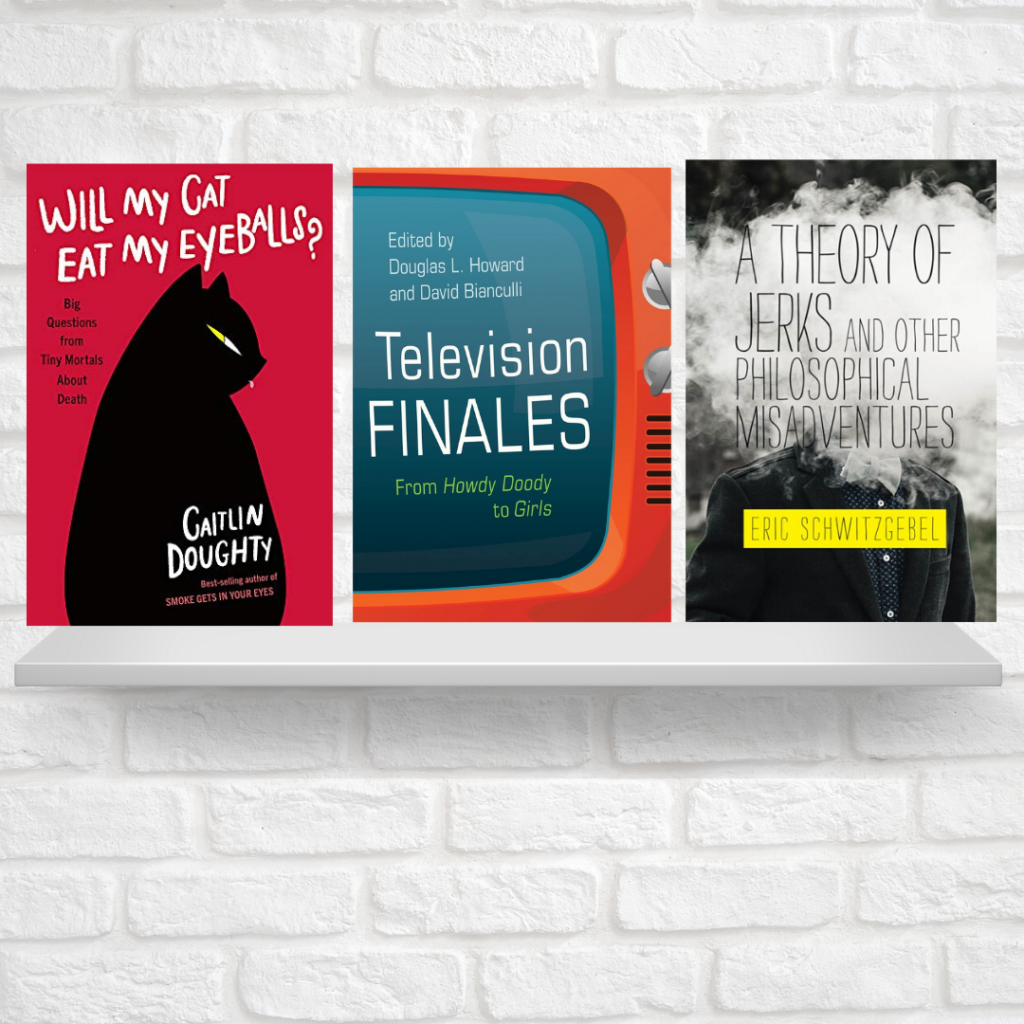
Thank you.
1) *Still* unhappy with the way Game of Thrones ended? DOUGLAS L. HOWARD holds the academic chair of the English Department on the Ammerman Campus at Suffolk County Community College. DAVID BIANCULLI is a writer and radio host, who has been a TV critic since 1975. Together they have edited a collection of serious essays about the last episodes of some of the most beloved TV shows: TELEVISION FINALES: FROM HOWDY DOODY TO GIRLS. This is a book that will start a hundred arguments.
2) Have you ever worried that if you should die home and alone, your pet dog or cat would eat you? Gruesome thought, yes, but we are all thinking such thoughts nowadays. Writer and mortician CAITLIN DOUGHTY’s new book answers this and many other questions that people, especially children, have asked about what happens when they go on the “long goodbye”: WILL MY CAT EAT MY EYEBALLS? BIG QUESTIONS FROM TINY MORTALS ABOUT DEATH. Not for the squeamish, but fascinating, well-researched, and fun none the less.
3) Is there a theory of jerks? Because that would explain a lot. Is the United States a conscious entity? Could you accidentally become a zombie robot? How would you know? These are just a few of the wild ideas that are considered in the new book by ERIC SCHWITZGEBEL, Professor of Philosophy at the University of California, Riverside. His new book redefines philosophy and makes the subject fun and deeply fascinating: A THEORY OF JERKS: AND OTHER PHILOSOPHICAL MISADVENTURES.
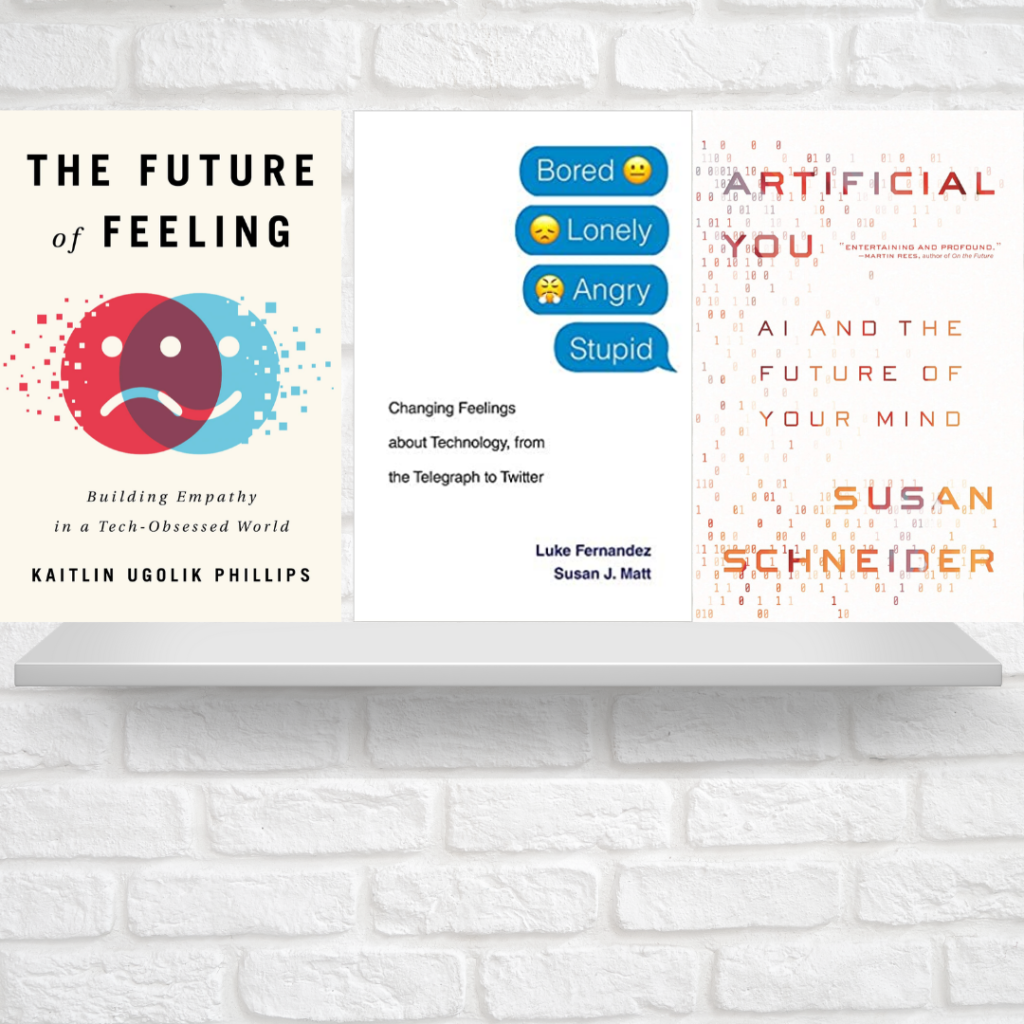
Thank you.
“I’ve been on my computer for so long, I think I’m falling in love with it.”
We all have been spending an inordinate amount of time on our phones and computers. Here are three books about how technology is affecting us:
1) Are we losing our ability to feel empathy the more we become enthralled to our portable tech? Are Facebook and Twitter creating a nation of the emotionally handicapped? Can this same tech also help us to restore our emotional health? KAITLIN UGOLIK PHILLIPS has written an important new book that addresses this concern: THE FUTURE OF FEELING: BUILDING EMPATHY IN A TECH-OBSESSED WORLD.
2) LUKE FERNANDEZ is an Assistant Professor in the School of Computing and Co-director of the Tech Outreach Center at Weber State University, and SUSAN J. MATT, Presidential Distinguished Professor of History at Weber State University. Their new book BORED. LONELY. ANGRY. STUPID: CHANGING FEELINGS ABOUT TECHNOLOGY, FROM THE TELEGRAPH TO TWITTER shows that we have always felt conflicted about new technology, even the telegraph.
3) If you want to really get freaked out about tech and humanity, read this book: SUSAN SCHNEIDER is the NASA Baruch Blumberg Chair at the Library of Congress and the director of the AI, Mind and Society Group at the University of Connecticut. Her new book is ARTIFICIAL YOU: AI AND THE FUTURE OF YOUR MIND and asks questions like: Can we create a super-intelligent machine that has consciousness? What are the dangers of creating a machine consciousness? Should we want to transfer our mind into a machine?
If you watch WESTWORLD, you will find this book alarming.
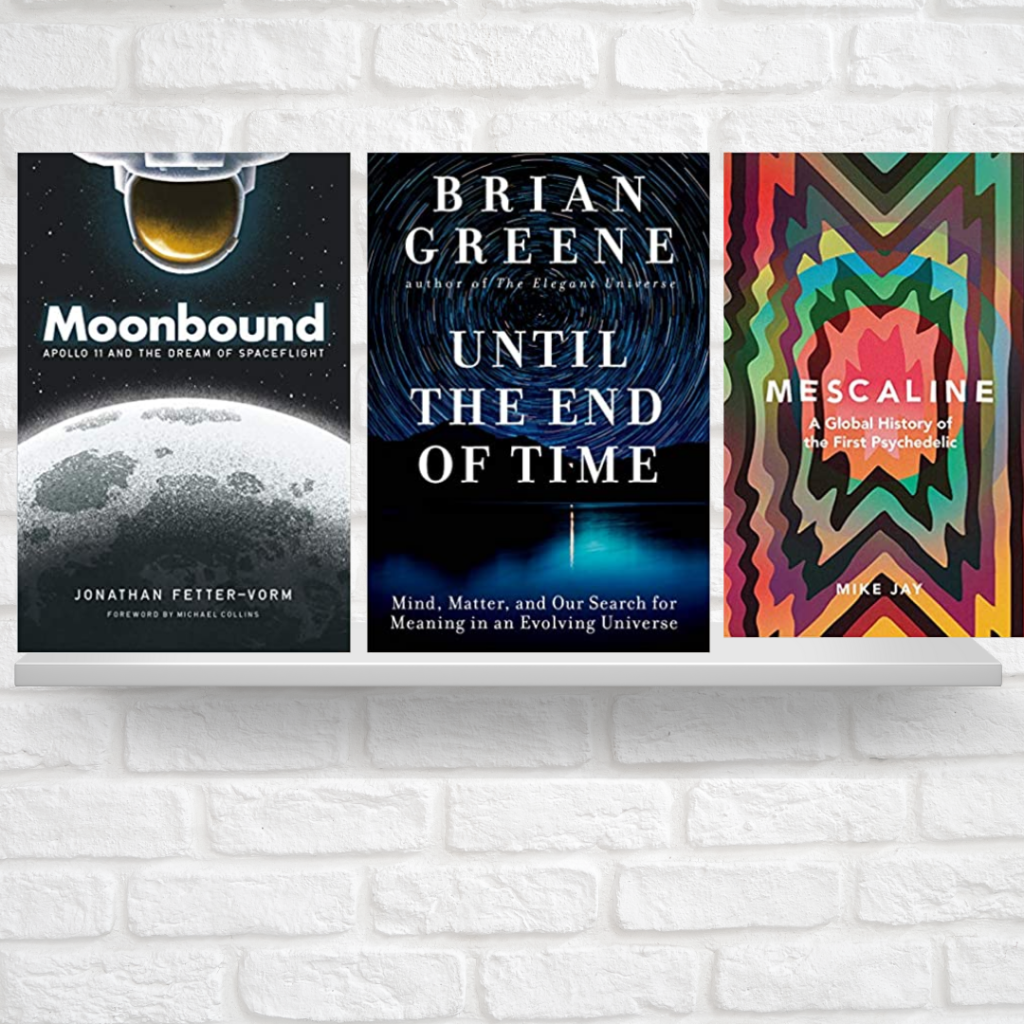
Thank you.
THIS WEEK’S COVID-19 ISOLATION BOOK RECOMMENDATIONS, via WICN “Inquiry” host Mark Lynch:
“This week, I want to read something that will take me far away from this bat-crazy world. Well, how about the moon, for starters?”
1) *That’s one small step for man…one giant leap for
mankind.* Artist and writer JONATHAN FETTER-VORM’s new graphic history is about the Apollo 11 moon landing as well as a concise history of how cultures around the world have thought about the moon, the history of astronomy, rocketry, and the politics of the space race. It’s a history like no other that you have read: MOONBOUND: APOLLO 11 AND THE DREAM OF SPACEFLIGHT.
2) Is the moon not far enough away from earth for you? Well, how about traveling beyond the end of everything? BRIAN GREENE is a professor of physics and mathematics and director of Columbia University’s Center for Theoretical Physics. His new book is a mind-expanding trip from the Big Bang through till after the end of time and proton decay, evaporating Black Holes, and the disintegration of everything: UNTIL THE END OF TIME: MIND, MATTER, AND OUR SEARCH FOR MEANING IN AN EVOLVING UNIVERSE.
3) If the above book is still not far enough away from your earthly concerns, maybe you need to travel inwards instead. MIKE JAY has written extensively on scientific and medical history. His new book is a cultural, social, and scientific history of mescaline. “No mind-altering substance
has been described more thoroughly and from such a variety of perspectives.” Jay’s book is MESCALINE: A GLOBAL HISTORY OF THE FIRST PSYCHEDELIC.
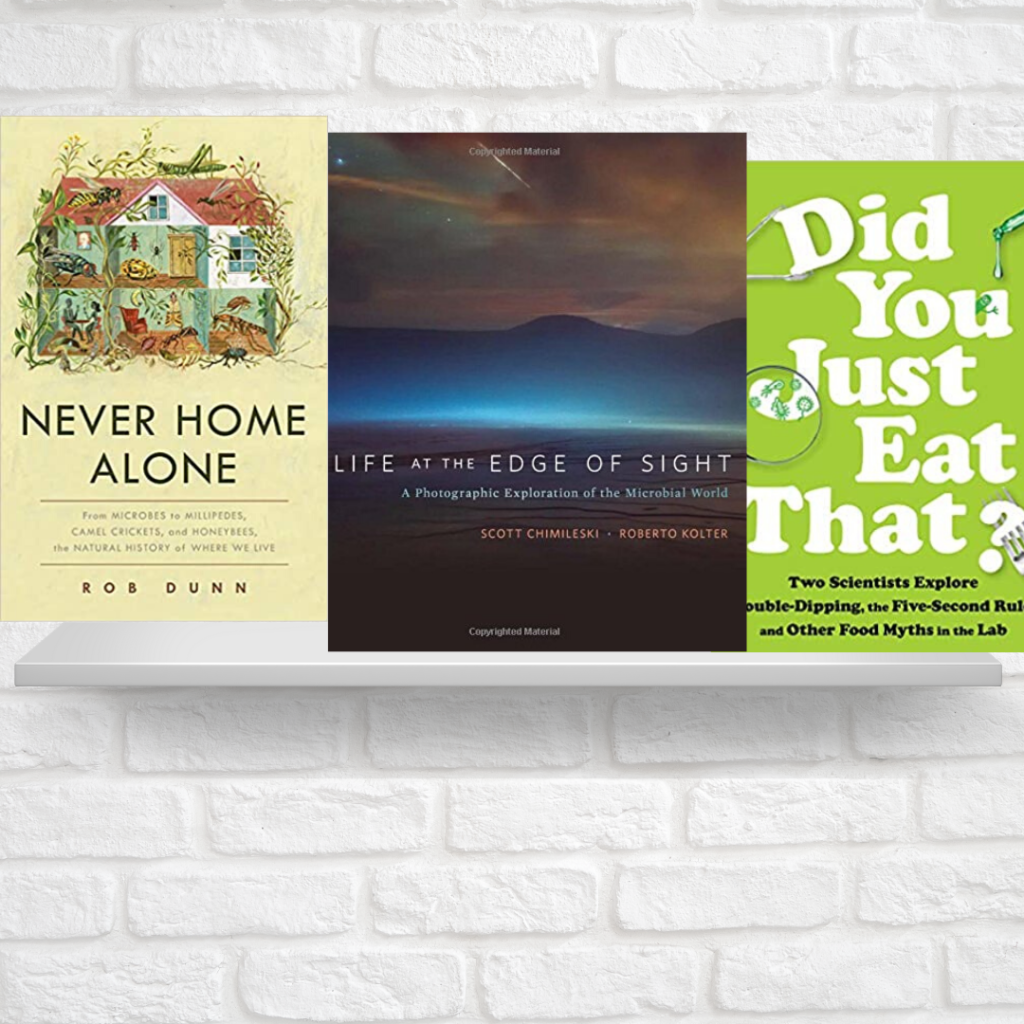
Thank you.
LET’S GET SMALL: THREE FUN BOOKS ABOUT TEENY INSECTS AND MICROBES AND HOW THEY LIVE ALL AROUND US.
1) Think your house is really clean? Think again.
ROB DUNN is a professor in the department of applied ecology at North Carolina State University and in the Natural History Museum of Denmark at the University of Copenhagen. Like so many biologists and ecologists, he originally conducted his research in far-flung rainforests until he discovered that there is another wild ecology that exists in our own homes. Come to find out, our cellars, water heaters, and showerheads contain an entire ecology of teeny creatures. Even the ISS and MIR orbiting earth contain jungles of microorganisms. Learn all about the living worlds in your own homes in Dunn’s book: NEVER HOME ALONE: FROM MICROBES TO MILLIPEDES, CAMEL CRICKETS, AND HONEY BEES, THE NATURAL HISTORY OF WHERE WE LIVE.
2) When your buttered toast falls on the kitchen floor, do you really have 5 seconds before it gets contaminated?
Can you pick up “something” from a menu? Is there a hidden danger to beer pong? These are just a few serious questions answered by PAUL DAWSON, Professor at Clemson University and BRIAN SHELDON, Professor Emeritus in food Microbiology at North Carolina State University. They and their students have carefully designed scientific experiments to test some of the most often cited food myths. The book that is the summary of their findings is one of the best books on science for a popular audience published: DID YOU JUST EAT THAT? TWO SCIENTISTS EXPLORE DOUBLE-DIPPING, THE FIVE-SECOND RULE, AND FOOD MYTHS IN THE LAB.
3) Maybe we should try to understand the world of the microbe.
This is a complex world we typically cannot see, but in fact, these microbes communicate, cooperate, and compete, sometimes in a matter of femtoseconds. It’s a complex ecology we rarely get to see. SCOTT CHIMELESKI is a photographer and a Research Fellow at Harvard Medical School and ROBERTO KOLTER is a Professor at Harvard Medical School and Co-Director of Harvard’s Microbial Sciences Initiative. Together they have written one of the most surprising, beautiful and fun books on the biological sciences: LIFE AT THE EDGE OF SIGHT: A PHOTOGRAPHIC EXPLORATION OF THE MICROBIAL WORLD.
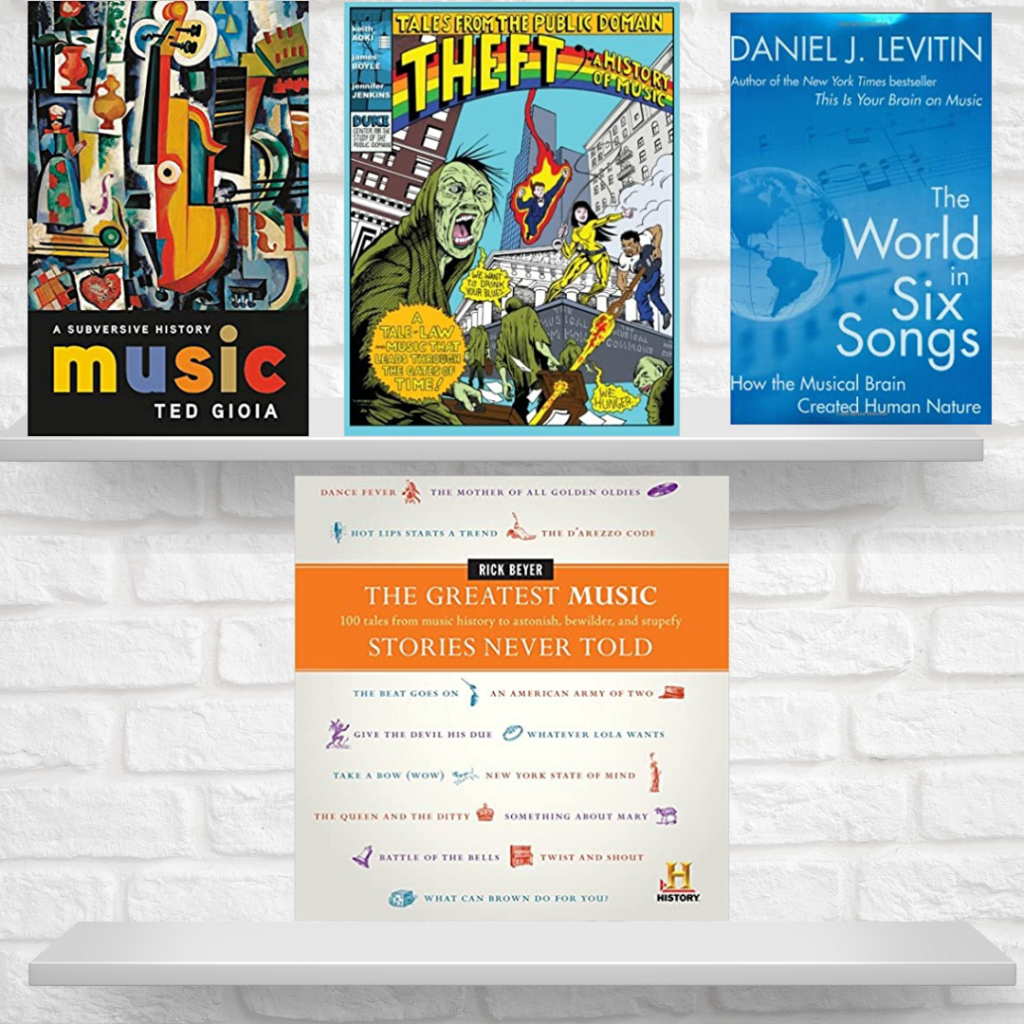
Thank you.
IT’S ALL ABOUT THE MUSIC, DUMMY!
WICN broadcasts some of the finest music shows on the dial. Not just jazz, but folk, blues, soul, rock, and much more. Here are four books about that very large topic: MUSIC.
1) Critic, scholar, performer, writer, and music historian TED GIOIA’s new book is a history of music like no other. MUSIC: A SUBVERSIVE HISTORY tells the often hidden evolution of music from ancient Egypt, Assyria, and Greece to Burning Man, MP3s, and electronic dance music. It’s a tale filled with sex, violence, magic, ecstasy, and rebellion against the authoritarian powers that always tried to control what music was proper.
2) JAMES BOYLE is the Williams Neal Reynolds Professor of Law at Duke Law School. With Jennifer Jenkins and Keith Aoki, he has written a very unique and fun treatise on the history of music and copyright laws. Not just a book, but a wild and wonderful book-length comic! Read it and learn about the evolution of the corporate control of music: THEFT: A HISTORY OF MUSIC.
3) PROFESSOR DANIEL J. LEVITIN runs the LABORATORY FOR MUSIC PERCEPTION, COGNITION, AND EXPERTISE at McGill University. His latest wild and fascinating book is THE WORLD IN SIX SONGS: HOW THE MUSICAL BRAIN CREATED HUMAN NATURE. It is Professor Levitin’s belief that music and song may have come before human language, and that song passes down information in human society. Levitin believes that there are 6 kinds of songs that do this: songs of FRIENDSHIP, JOY, COMFORT, KNOWLEDGE, RELIGION, and LOVE. This is a book about how the musical brain made human society possible, why music is the perfect mnemonic tool, and why listening to “Boulder to Birmingham” by Emmylou Harris makes me cry.
4) What’s the oldest song in the world? Did Ben Franklin invent a musical instrument that drove people mad? What are the actual lyrics to the classic rock song “Louie Louie”? All these fascinating stories are in writer and documentary filmmaker RICK BEYER’S latest rollicking compendium THE GREATEST MUSIC STORIES NEVER TOLD: 100 TALES FROM MUSIC HISTORY TO ASTONISH, BEWILDER AND STUPEFY. Read it and find out where to find the largest human-made dog in the world and other wild tales.
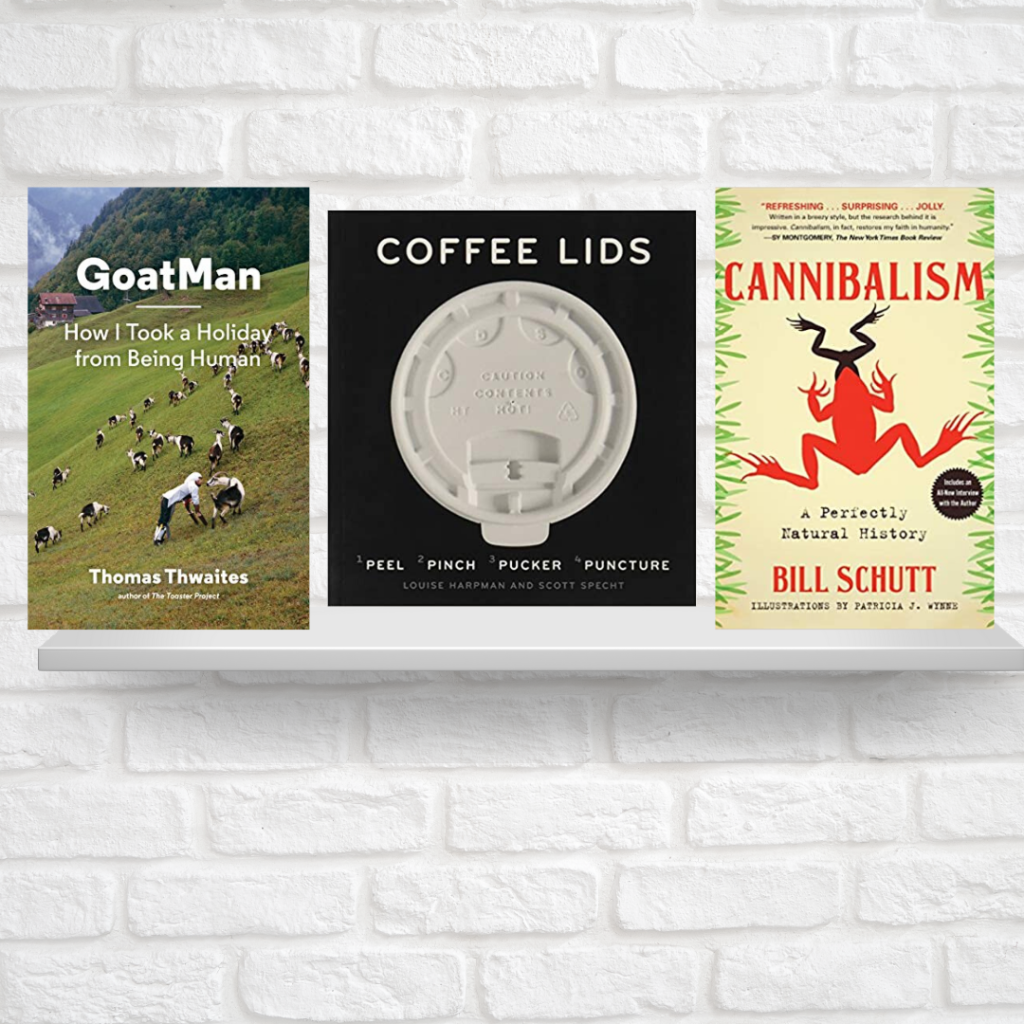
Thank you.
I often get the request: “Can you recommend something really weird to read?” I get it. After living for weeks under strict restrictions, you are ready to read something a little “odd” and out of the ordinary. Well, I have a long list of such books. Here are just three:
1) Tired of mac and cheese? We all assume that cannibalism is bad. But it is a common phenomenon, at least in the rest of the animal kingdom. And though eating each other is taboo, it certainly appears in many of our myths, fairytales, and films. Then there was the Donner Party… BILL SCHUTT is a professor of biology at LIU Post and a research associate in residence at the American Museum of Natural History. His new book is not for the faint of heart: CANNIBALISM: A PERFECTLY NATURAL HISTORY
2) You see them every day, but have you ever thought deeply about their design? If you drink coffee or hot tea from a store, then you have seen coffee lids. These everyday objects have an entire design taxonomy and evolution. LOUISE HARPMAN, architect, educator, irrational optimist; and SCOTT SPECHT, architect, developer and researcher, have produced a surprisingly fascinating and beautiful book about COFFEE LIDS: (1) PEEL, (2) PINCH, (3) PUCKER, (4) PUNCTURE. It’s all about controlling spillage. Yes, an entire book, profusely illustrated, about coffee lids.
3) See the 1966 novel by John Barth. THOMAS THWAITES is a designer in London, where he ponders technology, science, and futures research. One day he realized he was tired of all the worry and stress of human life and decided to try to become a goat. Not just dress like a goat, but become a goat physically, eating grass and gamboling over alpine meadows. What happened next is told in his new book GOATMAN: HOW I TOOK A HOLIDAY FROM BEING HUMAN. The story is even weirder than you think. Lots of color photographs, too.
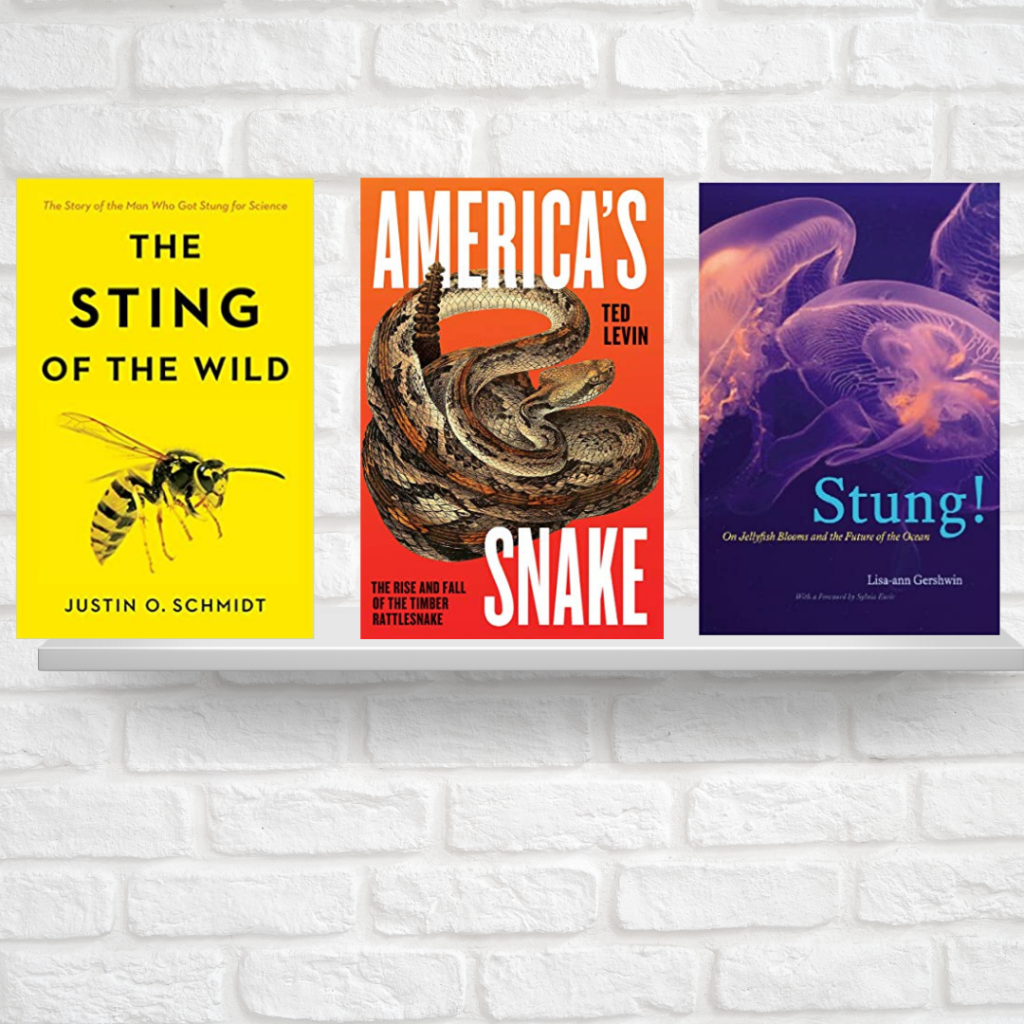
Thank you.
Itching to get outside? Here are three fine books on natural history that might also encourage you to stay inside:
1) Do you suffer from ophidiophobia? Many people fear snakes and try to kill them on sight. And of all the snake species here in America, the most feared is the rattlesnake. TED LEVIN is a writer and wildlife biologist. His new book is AMERICA’S SNAKE: THE RISE AND FALL OF THE TIMBER RATTLESNAKE. It is an intimate and loving look at the complex life of this rattlesnake of the northeast and explores why their populations around the area are so endangered. Read this and find out why this species is so special and deserving of protection. Seriously!
2) If you think the beach is safe, think again: Around the world, our oceans and seas are experiencing a bizarre and frightening phenomenon: jellyfish blooms. The appearance of many thousands of jellyfish prevents fishing, gums up ships, and creates a general panic because of their painful sting. So, why are these apocalyptic congregations appearing now? LISA-ANN GERSHWIN has a great job title. She is the director of the Australian Marine Stinger Advisory Services. Her book is STUNG! ON JELLYFISH BLOOMS AND THE FUTURE OF THE OCEAN.
3) Chinese Death Wasps? Pish Posh! Have you ever been stung by a yellow jacket or honey bee? Why do wasp stings hurt so much? Here is a book all about the biology, ecology, and biochemistry of stinging insects. JUSTIN O. SCHMIDT is a biologist at Southwestern Biological Institute and is affiliated with the Department of Entomology at the University of Arizona. His new book, THE STING OF THE WILD, recounts his wild adventures collecting, and sometimes getting stung by, some of the most painfully venomous insects in the world.
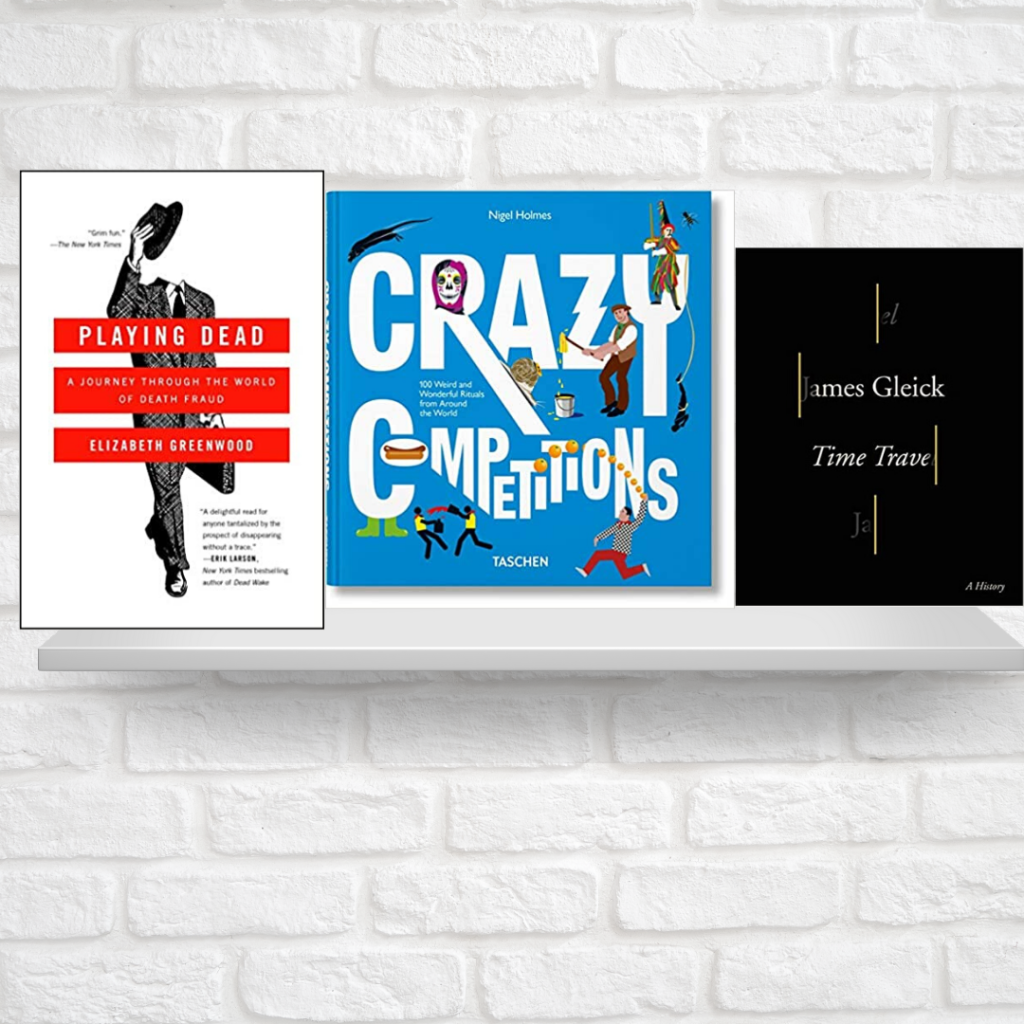
Thank you.
Bored with reruns of ballgames from five years ago? Have you watched all of Netflix? Does the thought of walking your dog for the third time today just to get outside fill you with ennui? All wound up with nothing new to do? Here are three books that suggest some new ways to spend all your pent-up energy.
1) How about starting a new life? Are you too much in debt? Facing a criminal conviction? Or are you just unhappy with your family life? Have you ever dreamt about faking your death and starting all over with a clean slate? Writer and journalist ELIZABETH GREENWOOD did just that. She started her very strange trip by Googling “faking your death” and what followed is recounted in her wild and bizarre book: PLAYING DEAD: A JOURNEY THROUGH THE WORLD OF DEATH FRAUD. WARNING: Before you attempt to fake your drowning and run away to Panama, read this book first.
2) How about starting a new life in the 1800s? “Sherman, set the WABAC…” We are all fascinated by stories and films about time travel and considering the possibilities of actual travel to the past or future. But is time travel possible? Noted chronicler of science and technology JAMES GLEICK has written a wonderful book that explores the science, literature, and philosophy of TIME TRAVEL.
3) How about ditching baseball and getting into some really “different” competitions? Have you ever heard of the “Pig-N-Ford” Races? Have you longed to do some Bog Snorkeling? Dwile Flonking? British-American graphic designer NIGEL HOLMES has written a crazy and beautiful compendium of some of the globe’s most insane “sports”: CRAZY COMPETITIONS: 100 WEIRD AND WONDERFUL RITUALS FROM AROUND THE WORLD. If you have ever dreamt of running down a steep hill after a careening wheel of cheese, this is the book for you.
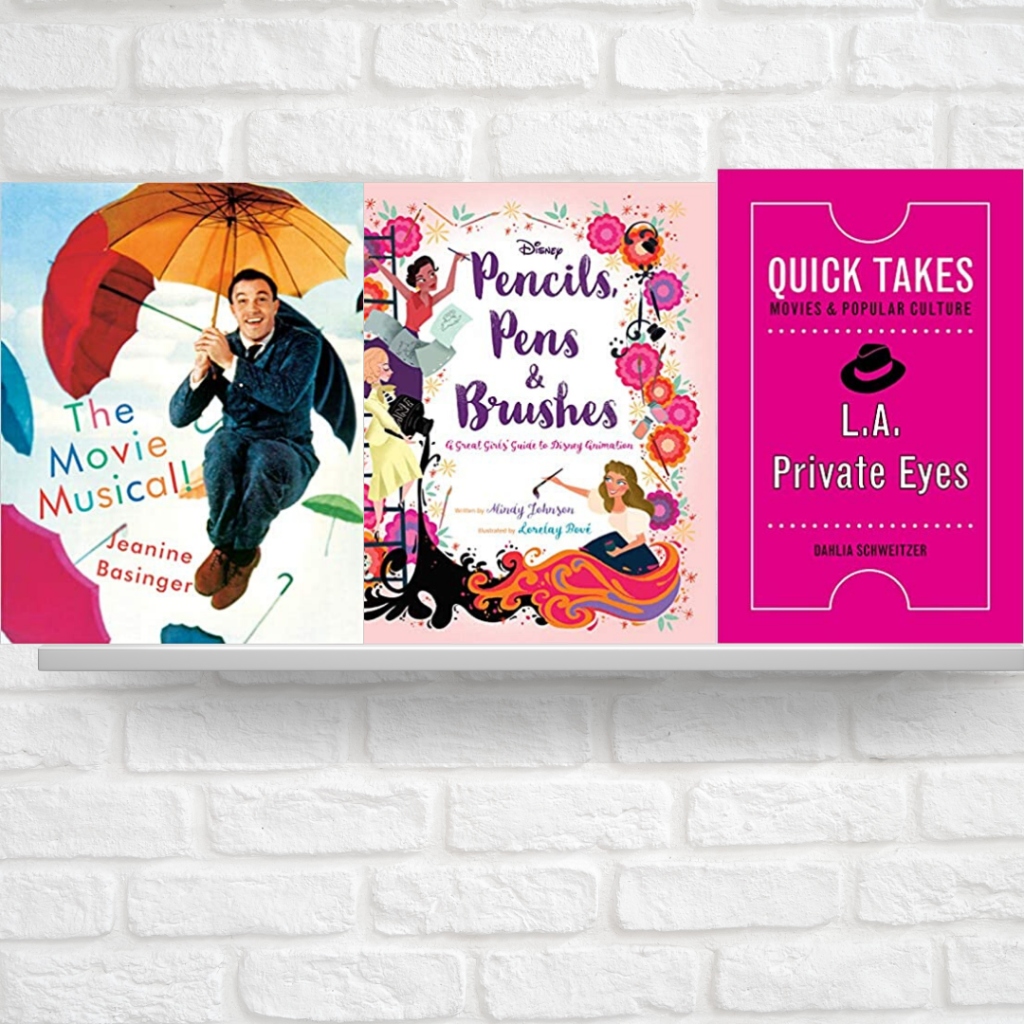
Thank you.
HOORAY FOR HOLLYWOOD! You probably have now watched a ton of movies in quarantine. If you would like to read something more about those films beyond the usual two-sentence description, here are three great books about films.
1) “It’s Chinatown, Jake.” DAHLIA SCHWEITZER is a professor at Art Center College of Design in Pasadena, California. Her latest book looks at the books and films that portray the private eye in Los Angeles. From Marlowe to Jake to Veronica Mars, it takes a certain kind of person to uncover the sleaze and corruption that lurks beneath the fake glamour of Tinseltown. If you want to find out what it takes, read Schweitzer’s entertaining book titled: L.A. PRIVATE EYES
2) “Bippity-Bobbity-Boo.” MINDY JOHNSON is an award-winning author, historian, filmmaker, educator, and musician. Two of her latest books are outstanding histories of the crucial role women have played in the history of Disney animation. Her INK & PAINT: THE WOMEN OF WALT DISNEY’S ANIMATION is a large format, sumptuously illustrated, book for adult readers. DISNEY PENCILS, PENS & BRUSHES: A GREAT GIRLS GUIDE TO DISNEY ANIMATION is for younger readers.
3) “You’re gonna go out there a kid, but you’ve got to come back a star!” JEANINE BASINGER is the founder of the Department of Film Studies at Wesleyan University and the curator of the cinema archives there. Her monumental new book is THE MOVIE MUSICAL! It is a wonderful, fun history that is bound to start a thousand discussions and arguments. If you love musicals old or new, this is a “must-have” companion. Spoiler: she hates LaLa Land but loves the musical sequence in Hail, Caesar!
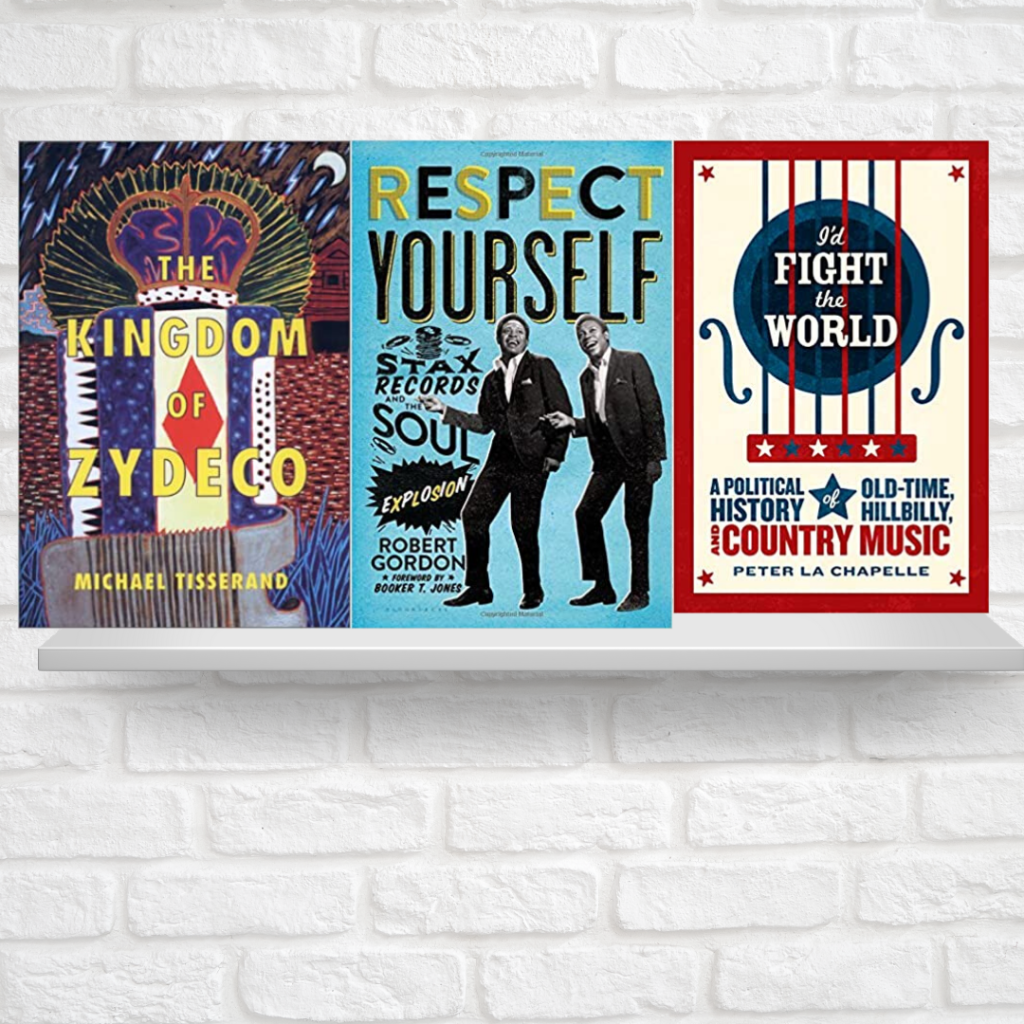
Thank you.
More books about more music. This week, we go south for some great histories that will make you want to expand your record collections.
1) Zydeco is a word for the music of Creole Louisiana as well as the event at which it is played and what people do when they get to the dance. Here is a fine book about accordions, washboards, snap beans, and some of Zydeco’s greatest musicians: MICHAEL TISSERAND’S THE KINGDOM OF ZYDECO.
2) Stax Records in Memphis was “Soulsville USA.” It was an incredible enterprise from the 1960s and ‘70s that would record 800 singles, 300 albums, win an Academy Award, and create Wattstax in 1972, aka “The Black Woodstock.” Artists on Stax included Otis Redding, Isaac Hayes, Sam and Dave, Booker T and the MGs, Wilson Pickett and many more. Filmmaker and historian of the Memphis music scene, ROBERT GORDON, has penned a dynamic history: RESPECT YOURSELF: STAX RECORDS AND THE SOUL EXPLOSION.
3) Between 1878 and the turn of the 21st Century, country music, old-time fiddle music, hillbilly music, and bluegrass were central to the campaigning of many politicians. PETER LA CHAPELLE is a professor of history at Nevada State College and his fascinating history is: I’D FIGHT THE WORLD: A POLITICAL HISTORY OF OLD-TIME, HILLBILLY, AND COUNTRY MUSIC.
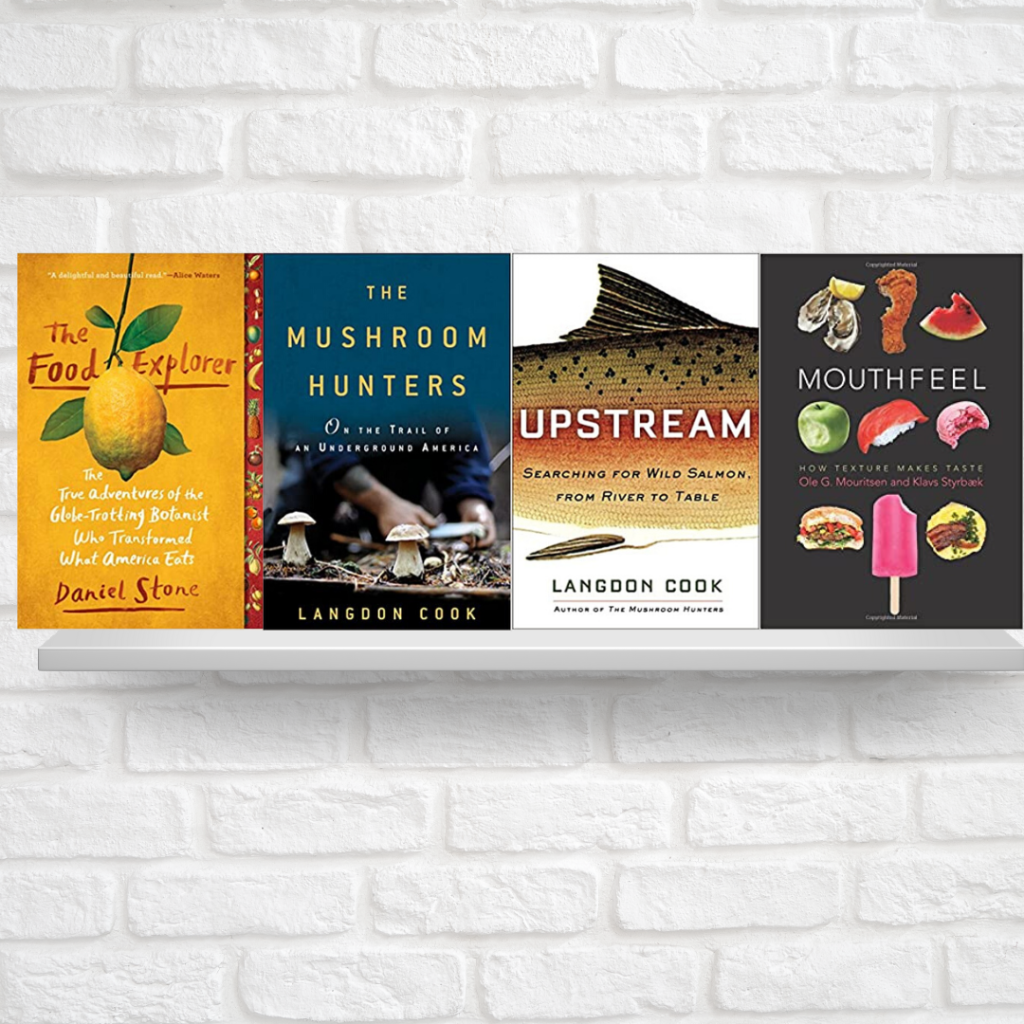
Thank you.
FOOD, GLORIOUS FOOD!
Here are three scrumptious books about food:
1) Mouthfeel is created by the physical characteristics of what we put in our mouth. It’s why a crunchy potato chip tastes better than a soggy one. OLE G. MOURITSEN is the director of the Danish Center for Taste and the Center for Biomembrane Physics and he is also president of the Danish Gastronomical Academy. Together with award-winning chef Klaus Strybaek, they have written a unique and fascinating book that is part neuroscience and part cookbook: MOUTHFEEL: HOW TEXTURE MAKES TASTE.
2) Wild salmon are a keystone species of the Pacific Northwest. Prized for their flavor, these anadromous fish have suffered huge declines in recent decades due to the construction of dams, logging, mining, pollution and loss of habitat. Can wild salmon survive all that is being done to them? LANGDON COOK’s book is UPSTREAM: SEARCHING FOR WILD SALMON FROM RIVER TO TABLE. He is also author of another great wild food book: THE MUSHROOM HUNTERS: ON THE TRAIL OF AN UNDERGROUND AMERICA.
3) David Fairchild spent his life traveling the globe tasting the fruits and vegetables of the world and sending seeds and cuttings back for American farmers to grow. If you have ever enjoyed an avocado or a mango, you can thank Fairchild. DANIEL STONE is a writer for National Geographic and a former White House correspondent for Newsweek. His book is a great tale of culinary and botanical exploration: THE FOOD EXPLORER: THE TRUE ADVENTURES OF THE GLOBE-TROTTING BOTANIST WHO TRANSFORMED WHAT AMERICA EATS.
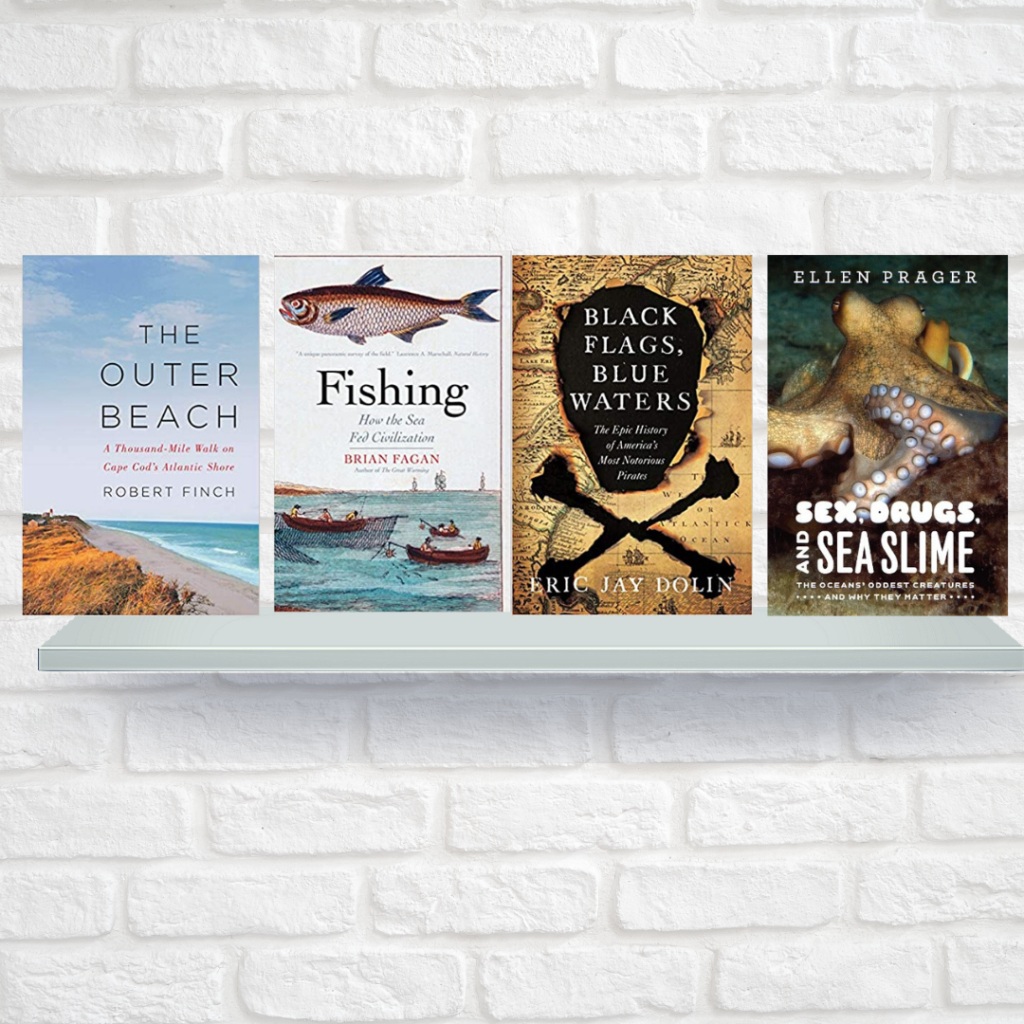
Thank you.
FOUR BOOKS FOR SEASIDE READING (while socially distancing)
Grab the beach umbrella, your good sunscreen, your hip sunglasses, and settle into some remote piece of sun-drenched sand by the ocean and enjoy these entertaining books about life in, on, and beside the mighty seas.
1) Arrrrggghhh…hoist the Jolly Roger, mates! Author and historian ERIC JAY DOLIN’sbook is the perfect history of anarchy on the high seas: BLACK FLAGS, BLUE WATERS: THE EPIC HISTORY OF AMERICA’S MOST NOTORIOUS PIRATES.
2) “Fishing is as old as humanity,” writes BRIAN FAGAN, an archaeological writer and emeritus professor at the University of California, Santa Barbara. His book is a fascinating survey of how human cultures have caught and used fish and shellfish, from prehistory to the present day: FISHING: HOW THE SEA FED CIVILIZATION. Read it and learn how the pyramids of Egypt were made possible because of fishing.
3) Writer ROBERT FINCH is a longtime resident of Cape Cod and his book is a wonderful collection of essays about walks on Cape Cod: THE OUTER BEACH: A THOUSAND-MILE WALK ON CAPE COD’S ATLANTIC SHORE.
4) Researcher and writer ELLEN PRAGER has written what amounts to a “tell-all” of life in the oceans. This features unusual creatures with very bizarre sex lives and lots and lots of slime. Prager has also included some amazing notes on why these creatures, strange and weird as they are, are important to humanity. Learn how hagfish can tie themselves into slimy knots; why a giant sea slug is critical to research on the human brain; and why you should never, EVER, eat the lobster’s tomalley. Prager’s vastly entertaining account of marine life is titled SEX, DRUGS AND SEA SLIME: THE OCEAN’S ODDEST CREATURES AND WHY THEY MATTER.
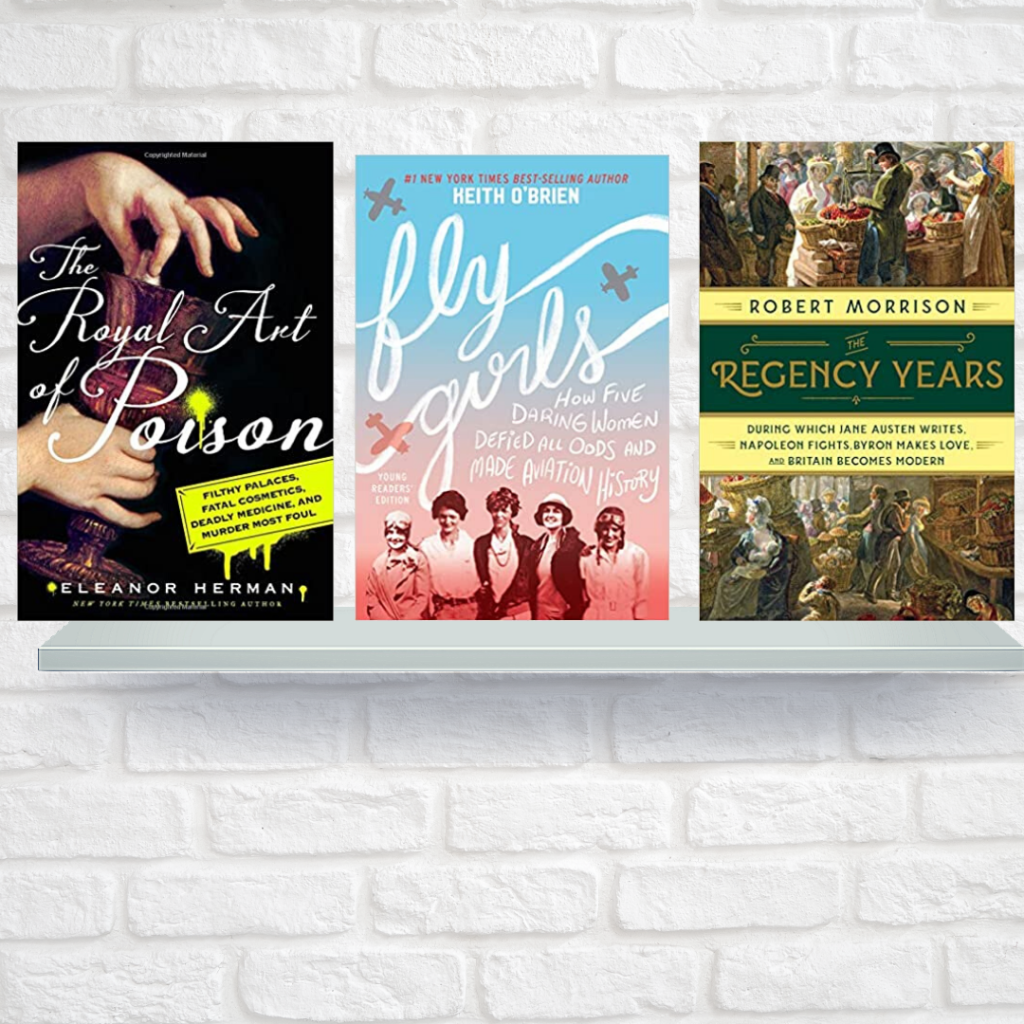
Thank you.
Sherman, set the WABAC for…
This week, we return to the past with three unique histories to take you far, far away from the realities of this disastrous year…
1) The “Regency” began in February 1811, when George, Prince of Wales, ruled Britain as “Prince Regent”, taking over the duties from the increasingly erratic King George III. The next decade saw a breathtaking amount of change in Britain, for good and bad. The war with Napoleon ended, the War of 1812 with America happened, Luddites protested the rapid changes in industry, Britain saw the beginning of major reforms in their government, and Mary Shelley penned Frankenstein. Writer and historian ROBERT MORRISON is the Queen’s National Scholar at Queen’s University, Kingston, Ontario. His new book is a deeply enjoyable survey of this wild decade: THE REGENCY YEARS: DURING WHICH JANE AUSTEN WRITES, NAPOLEON FIGHTS, BYRON MAKES LOVE, AND BRITAIN BECOMES MODERN.
2) During the 1920s and 1930s, a group of determined women fought against all odds to become daring aviators. Flying was still a very dangerous occupation at the time. Men in power didn’t believe flying was something a woman could or should do. But that didn’t stop a small group of determined women from mastering the skies. KEITH O’BRIEN is a former reporter for the Boston Globe and frequent contributor to National Public Radio. His book chronicles the lives of these women of the skies: FLY GIRLS: FIVE DARING WOMEN DEFIED ALL ODDS AND MADE HUMAN HISTORY.
3) The royal courts of The Renaissance were horribly filthy places. Food was often spoiled, sanitation was primitive, and even a woman’s makeup could be toxic. There was also a decent chance that you would be purposely poisoned by a professional. So how could you tell if the royal mistress died of “natural causes” or was the victim of court intrigue? Writer, historian, and television host ELEANOR HERMAN’s book is THE ROYAL ART OF POISON: FILTHY PALACES, FATAL COSMETICS, DEADLY MEDICINE, AND MURDER MOST FOUL.
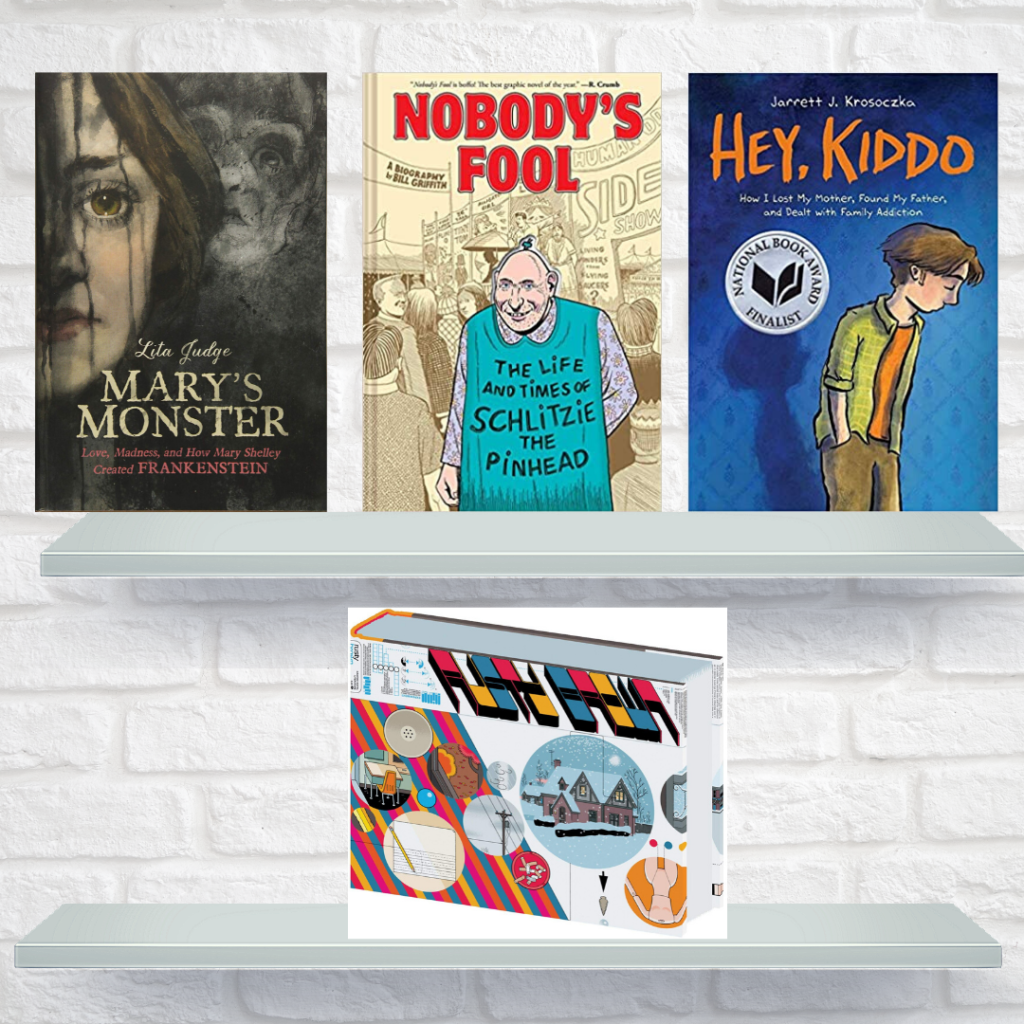
Thank you.
NOT YOUR PARENT’S COMICS!
Many contemporary graphic novels, histories, and memoirs are a distinct art form, far removed from the commercial superhero comics. These comics tell unique stories in a visually interesting way and explore adult issues. Here are just a few from the last five years.
1) Graphic artist BILL GRIFFITH is the creator of the syndicated daily comic strip, ZIPPY, and the graphic memoir INVISIBLE INK: MY MOTHER’S LOVE AFFAIR WITH A FAMOUS CARTOONIST. His latest graphic biography is NOBODY’S FOOL: THE LIFE AND TIMES OF SCHILTZE THE PINHEAD. Schiltze is best known to the public as one of the real sideshow performers that appeared in Tod Browning’s legendary film Freaks. He was also the inspiration for Griffith’s Zippy comics.
2) Mary Shelley’s Frankenstein was one of the first Industrial Age science fiction novels. But what was the inspiration for the monster in that book? Artist and writer LITA JUDGE’s new book explores Mary Shelley’s dark and painful life in illustrations and verse: MARY’S MONSTER: LOVE, MADNESS, AND HOW MARY SHELLEY CREATED FRANKENSTEIN.
3) I consider award-winning artist, graphic artist, and cartoonist CHRIS WARE to bethe Thomas Pynchon of graphic novels. His work is sometimes difficult, always complex, wildly beautiful, and channels the ennui that comes with growing up in the northern Midwest. His spectacular new book RUSTY BROWN is some of his best work.
4) JARRETT KROSOCZKA was born and raised in Worcester. He is now an award-winning author and illustrator of children’s and young adult books. He recently drew and wrote a graphic memoir of his own very difficult childhood. His father left at an early age and his mother was a serious drug addict. So, he was raised by his grandparents, who themselves were less than perfect. His new book, which has garnered many accolades, is HEY, KIDDO! Spoiler alert: I make an appearance in the middle.
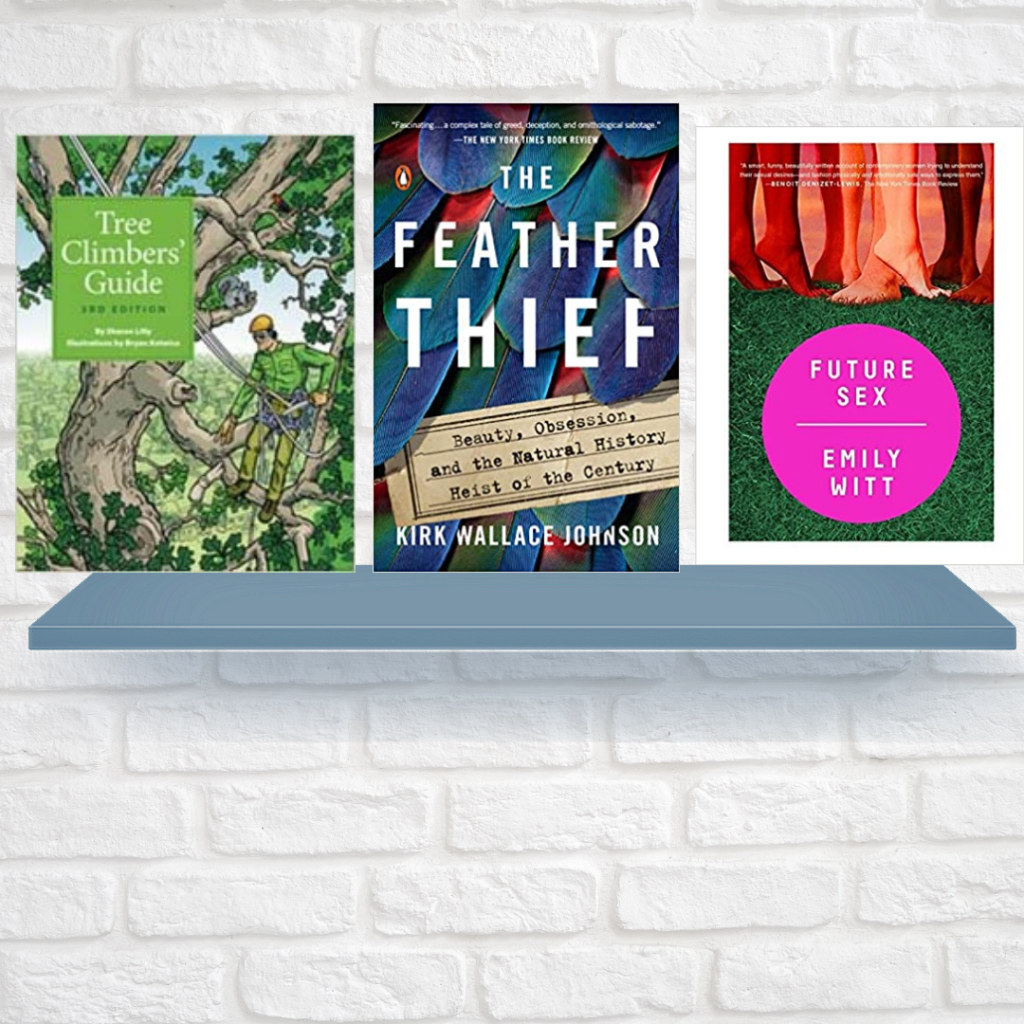
Thank you.
UNUSUAL PASSIONS!
We all have our passions in life. Here are three books chronicling some rather…unique ways to spend your free time.
1) Walking through a city, we rarely look up. Writer JACK COOKE who goes one better. He goes up. Jack Cooke has a passion for climbing large trees in and around London. Trees in parks, cemeteries, along rivers and even in those secret gardens London is famous for. Why should an adult take to the oak and cedar? Pick up Cooke’s unique book titled: THE TREE CLIMBER’S GUIDE: ADVENTURES IN THE URBAN CANOPY.
2) KIRK WALLACE JOHNSON is a writer and founder of the List Project to Resettle Iraqi Allies. One day while fly fishing he learned about Edwin Rist and the theft of a large number of specimens of very rare birds from the British Museum. This led Johnson down the rabbit hole as he became involved with the people who tie salmon flies and the very rare feathers they covet. This wild true crime case is told in Johnson’s new book: THE FEATHER THEIF: BEAUTY, OBSESSION, AND THE NATURAL HISTORY HEIST OF THE CENTURY.
3) When writer and journalist EMILY WITT turned thirty and found herself single, she began to wonder about the meaning of relationships and sex. Was there something to hope for other than the long-term monogamous relationship sanctioned by society? So, she began to explore other options and attitudes including internet dating, OMing, internet porn, live webcams, and polyamory. Witt’s new book FUTURE SEX chronicles her journey of sexuality and identity.
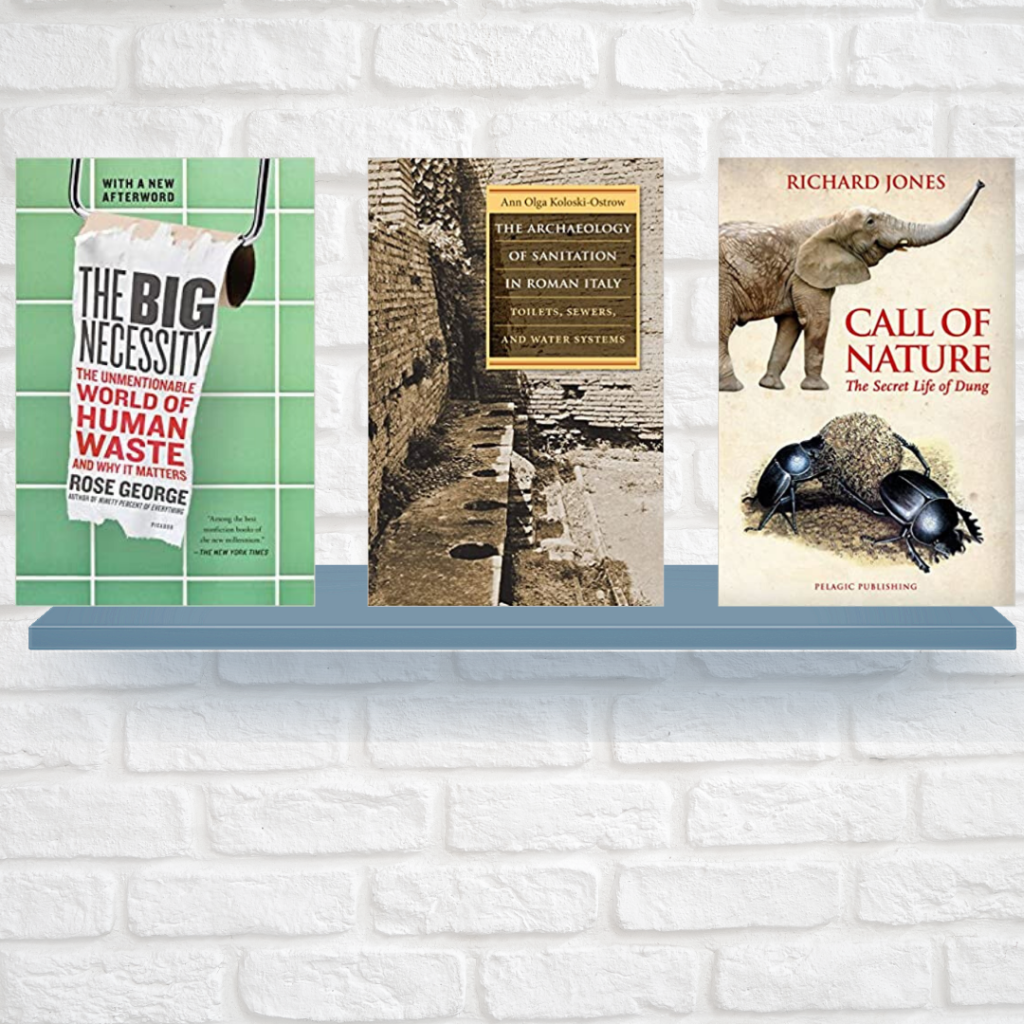
Thank you.
CHANNELING ED NORTON!
Everyone does it, and few people want to talk about it, so why not read about it?
1) Investigative reporter and writer ROSE GEORGE has written a great book about “human waste” and all the things we do–and neglect to do–with it. 2.6 BILLION people worldwide don’t even have the most basic sanitation, and this leads to numerous health and even education issues. In rural India, the outcaste “untouchables” are still forced to cart away waste on their heads. In China, farmers are converting human waste to “biogas” and fueling their homes with methane. In Japan, the focus is on ultra-modern “high function” toilets with blood pressure readouts, heated seats, and a variety of music. And why is it that no one can find a public toilet in New York City or London? All this and more can be found in Rose George’s book THE BIG NECESSITY: THE UNMENTIONABLE WORLD OF HUMAN WASTE AND WHY IT MATTERS.
2) The Ancient Romans had one of the most complicated sewer systems of their time. They also built a large number of public toilets. How did they work? What did Romans think about privacy, sanitation and cleanliness? Was there graffiti? ANN OLGA KOLOSKI-OSTROW is a professor and chair of Classical Studies at Brandeis University and affiliate faculty in Anthropology, Fine Arts, Italian Studies, and Women, Gender, and Sexuality Studies. Her book is THE ARCHAEOLOGY OF SANITATION IN ROMAN ITALY: TOILETS, SEWERS, AND WATER SYSTEMS.
3) Humans tend to step over or totally avoid a pile of dung, but there are many creatures that flock to dung. In fact, there is an entire “dung ecology.” RICHARD JONES is a nationally acclaimed entomologist, a fellow of the Royal Entomological Society and fellow of the Linnean Society. His new book is CALL OF NATURE: THE SECRET LIFE OF DUNG.
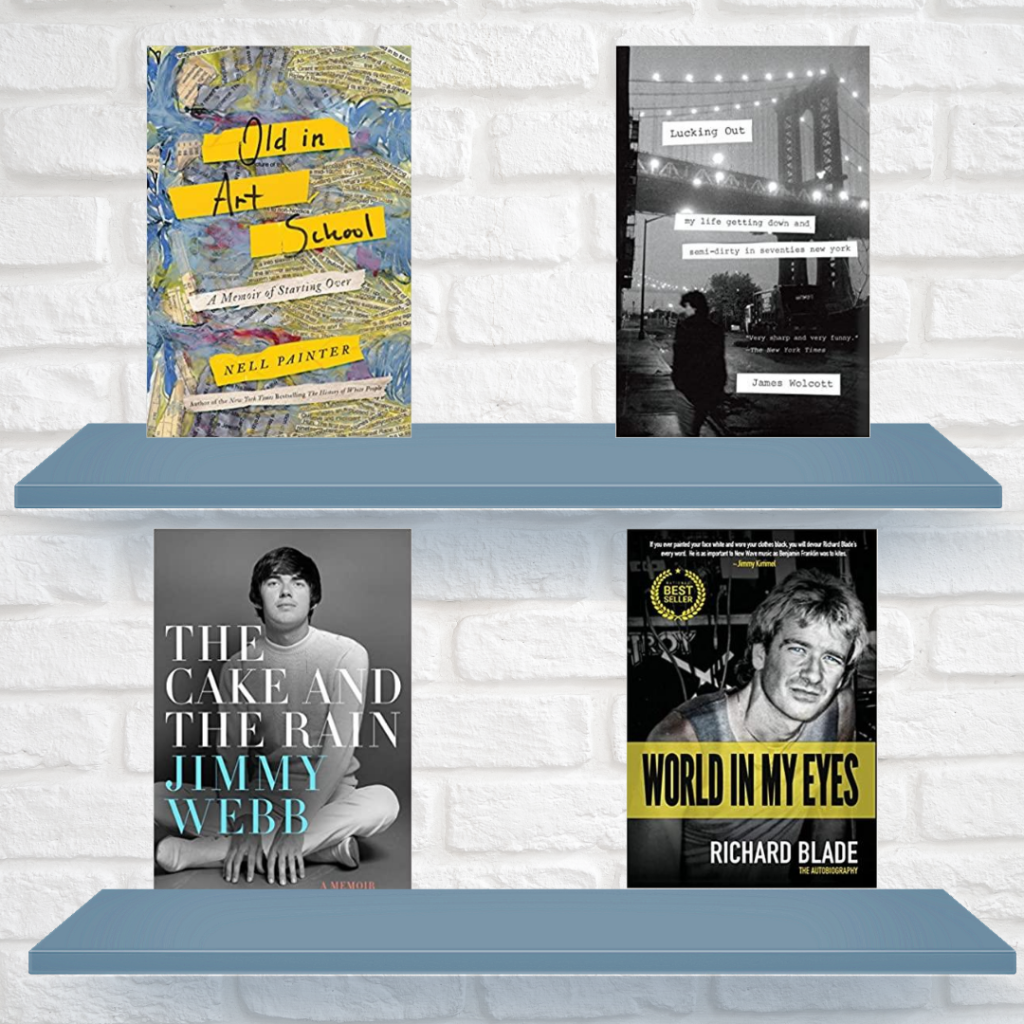
Thank you.
DOWN MEMORY LANE!
Here are four memoirs from authors who have led very interesting lives:
1) Professor NELL IRVIN PAINTER is the Edwards Professor of American History at Princeton University and author of such critically-acclaimed books as The History of White People. At the peak of her career, and into her sixties, Professor Painter decided to go to art school. Not just to dabble, but to complete rigorous BFA and MFA programs. Her new book is a memoir of those experiences and how her art evolved. OLD IN ART SCHOOL: A MEMOIR OF STARTING OVER is one of the most honest and compelling books on art, art education, and race to be published in quite some time.
2) Armed ONLY with a letter of introduction by Norman Mailer, JAMES WOLCOTT left college and headed for what he hoped would be a brilliant career as a critic in New York City in the early 1970s. As luck would have it, he managed to land an entry position at the Village Voice. Thus, began a whirlwind decade for Wolcott as he was introduced into the heady world of the legendary writers who worked in the city during what he calls “the Feudal Age of film criticism.” He becomes one of Pauline Kael’s posse and a regular at CBGB’s and there witnesses the first performances of the likes of Patti Smith and The Ramones. And that’s only the beginning of his story. Today, James Wolcott is a long-time columnist and blogger for Vanity Fair, and a well-known critic and fiction writer. His fabulous memoir is LUCKING OUT: MY LIFE GETTING DOWN AND SEMI-DIRTY IN SEVENTIES NEW YORK.
3) Ever wanted to know what it would be like to be a top rock DJ? RICHARD BLADE is one of the most popular rock DJs in America and has also hosted, directed, and/or starred in TV series like Video One, MV3, and Video Beat. He has recently written a new memoir that is a wild ride from blasting dance beats in clubs all over Europe to becoming one of the hottest on-air personalities at the legendary KROQ in Pasadena. It’s an amazing wild trip. His new book is titled: WORLD IN MY EYES: THE AUTOBIOGRAPHY.
4) He has been called “America’s songwriter.” The legendary singer and songwriter JIMMY WEBB’s new memoir is THE CAKE AND THE RAIN, a surprisingly wild and very dishy account of just the first decade of his prolific career. Satan is one of the characters. It’s a “must-read!”
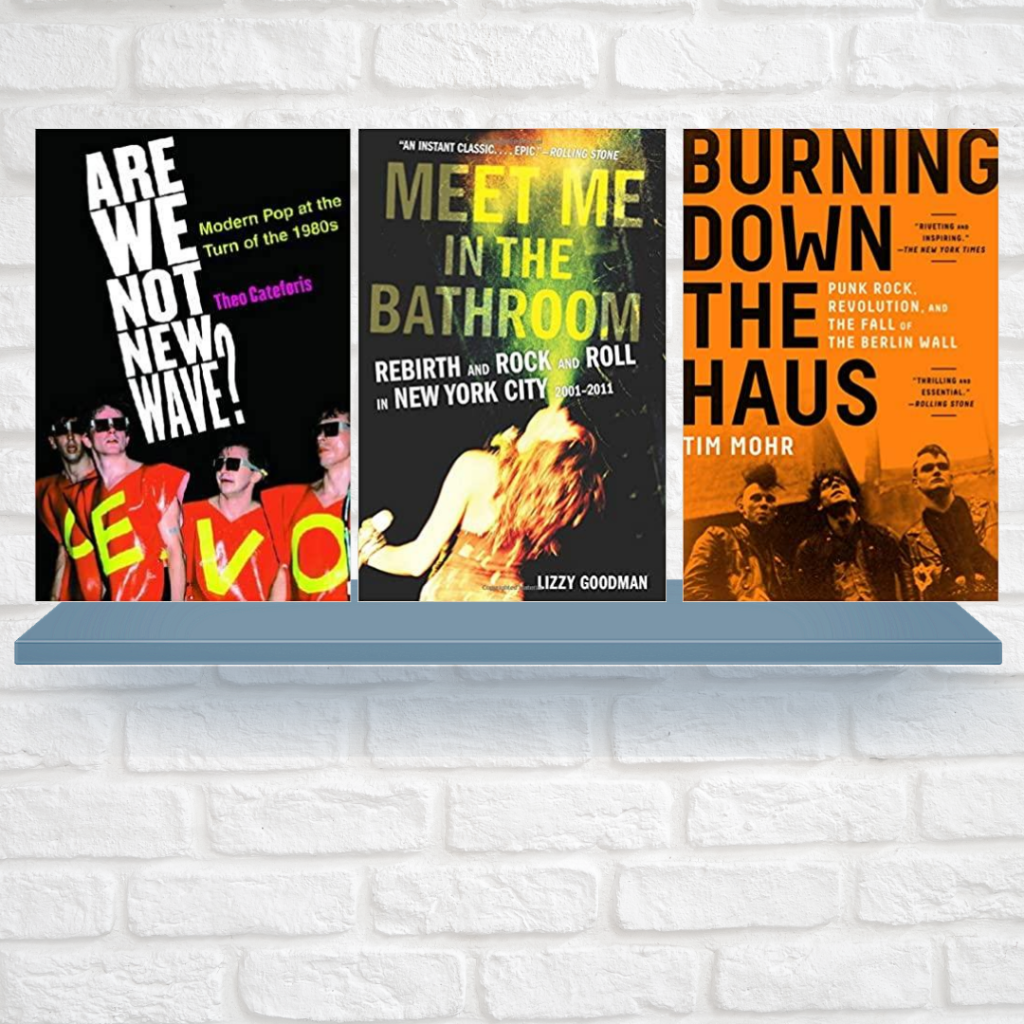
Thank you.
THREE BITS OF ROCK HISTORY THAT YOU MAY NOT BE FAMILIAR WITH:
1) In the late ‘70s and early ‘80s, bands like Talking Heads, Devo, The B52s, and OMD helped define an exciting and progressive modern pop music that was called “New Wave.” But is there an easy definition for this extremely varied music? THEO CATEFORIS is an Assistant Professor of Music History and Culture in the Department of Art and Music Histories at Syracuse University. His book ARE WE NOT NEW WAVE? MODERN POP AT THE TURN OF THE 1980s brings a surprising scholarly analysis to this progressive music that defined a generation of alternative music listeners. Read this book to find out why Devo epitomizes a neurotic disorder of the late nineteenth century, how Adam Ant found his groove in the Burundi Beat, and whether The Knack were Postmodernists.
2) Before the Berlin Wall fell, there were small groups of punk-music loving youth in East Germany who constantly risked arrest and prison to play the music they wanted to hear, dress the way they wanted to dress and express their independent views. Did they help the Berlin Wall to fall? Writer, journalist, and translator TIM MOHR has written a history of music, politics, and rebellion that most of us are unfamiliar with: BURNING DOWN THE HAUS: PUNK ROCK, REVOLUTION, AND THE FALL OF THE BERLIN WALL.
3) The Strokes, Yeah Yeah Yeahs, LCD Soundsystem and Interpol are just some of the brilliant bands that came out of New York City in the first decade of the new century in the shadow of the horrific attacks on 9-11. Journalist LIZZY GOODMAN has written an account of the music scene at that time by splicing together hundreds of hours of interviews: MEET ME IN THE BATHROOM: REBIRTH AND ROCK AND ROLL IN NEW YORK CITY 2001-2011.
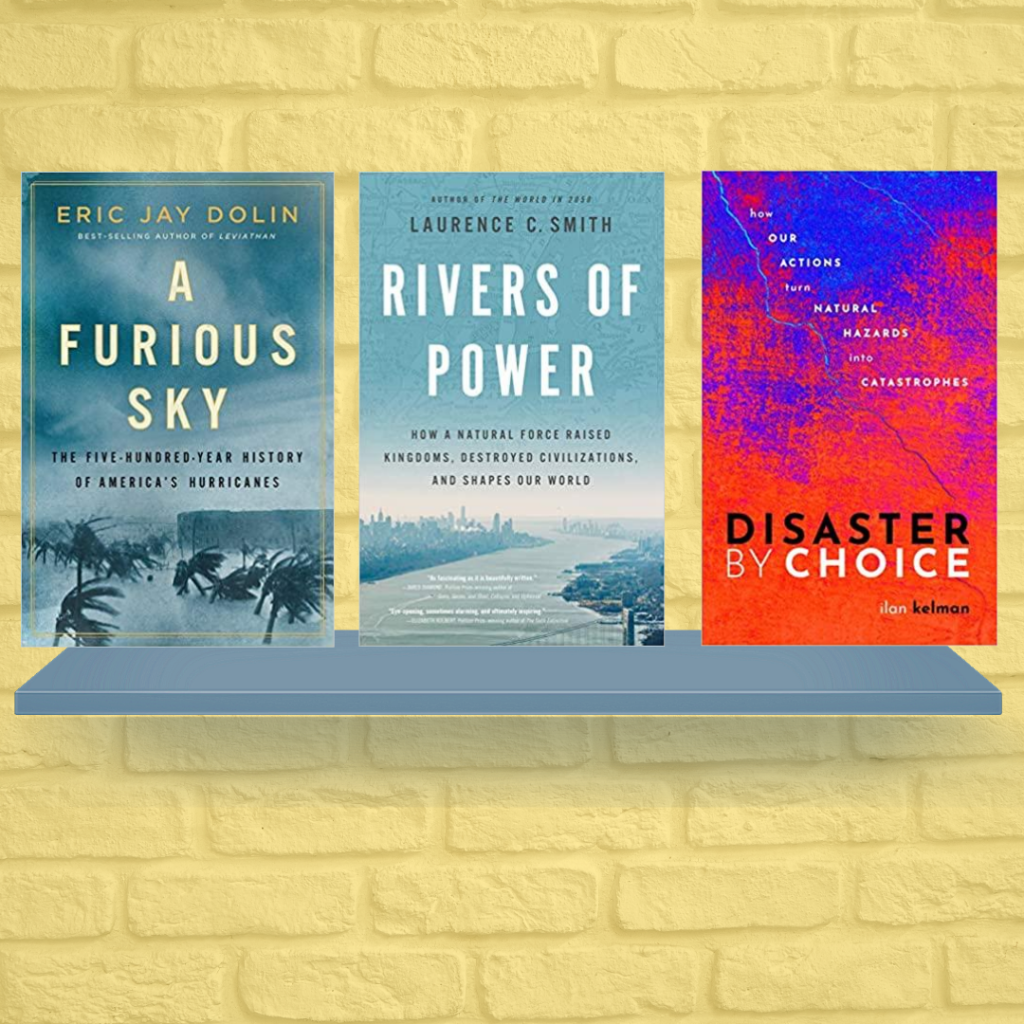
Thank you.
YIKES!!! HURRICANES! FLOODS! EARTHQUAKES!
This week, you get three engrossing books about humans and the fierce forces of nature.
1) This author believes that disasters are not natural. That tornado, earthquakes, or hurricanes are not to blame…we are. By making choices on where we build, how we take care of the poor, and how we maintain critical infrastructure, we are setting the stage for a natural event that will eventually take huge tolls on human life. ILAN KELMAN’s new book is DISASTER BY CHOICE: HOW OUR ACTIONS TURN NATURAL HAZARDS INTO CATASTROPHES. This book will change the way you think about what is called “a natural disaster”.
2) Rivers have played a critical role in shaping the course of human history. Rivers provide sustenance, waterways for travel, a source of energy, have played a part in warfare, and provide political boundaries. But we also terribly abuse these resources with pollution, enormous dam projects, and diversion projects. LAURENCE C. SMITH is the John Atwater and Diana Nelson University Professor of Environmental Studies and Professor of Earth, Environmental and Planetary Studies at Brown University. His new book is RIVERS OF POWER: HOW A NATURAL FORCE RAISED KINGDOMS, DESTROYED CIVILIZATIONS, AND SHAPES OUR WORLD.
3) Whether you call them typhoons, cyclones, Willy-Willys, or just plain hurricanes, these powerful tropical storms have been an inevitable part of the American experience. Award-winning non-fiction author ERIC JAY DOLIN’s new book is A FURIOUS SKY: THE FIVE-HUNDRED-YEAR HISTORY OF AMERICA’S HURRICANES. This is an engrossing account of how American scientists slowly developed a system to accurately predict and track hurricanes. We even learned how to fly planes into these monster storms. Dolin includes many in-depth accounts of some of our nation’s most destructive hurricanes, as well as the crazy history of naming storms and much more.
STAY COOL!
Here are three books about living a cool lifestyle…if that’s your thing.
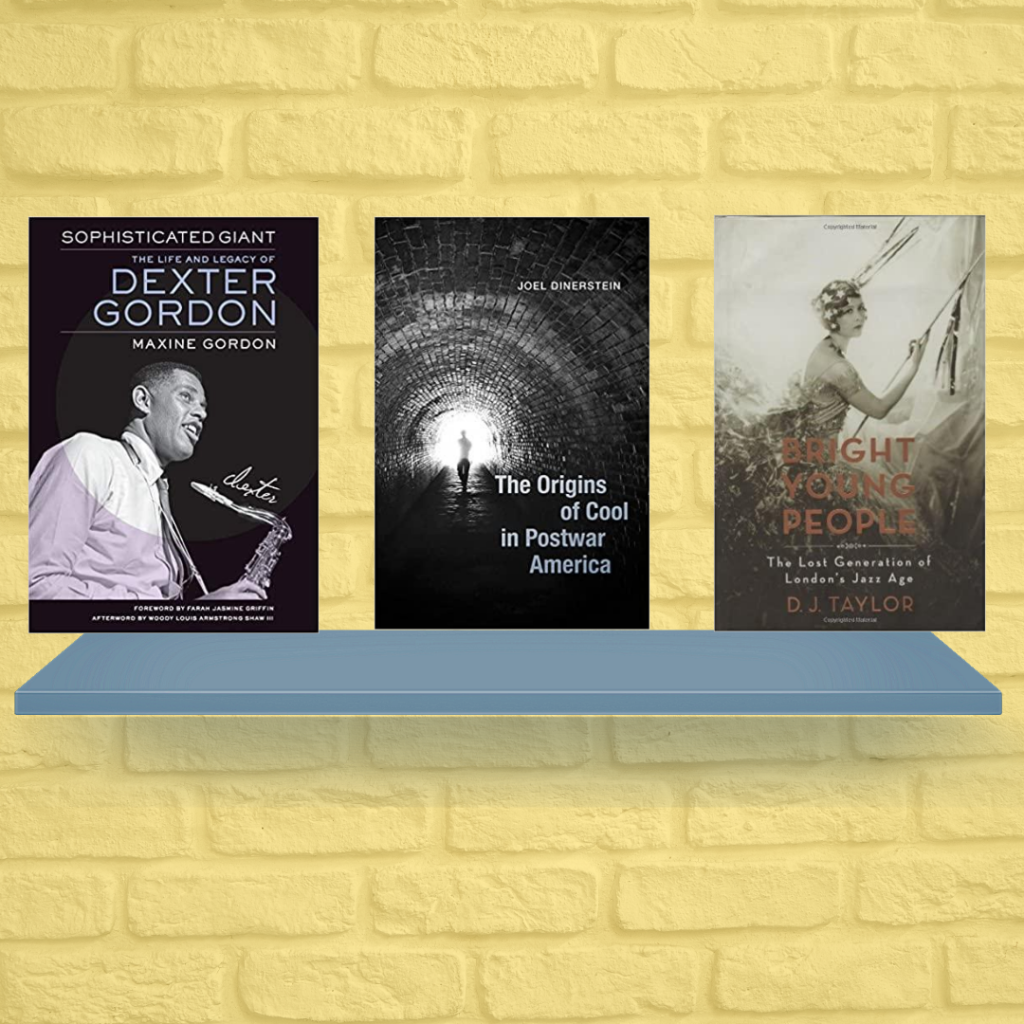
Thank you.
1) Pre-cool, but still cool adjacent: In Britain during the 1920s, a flamboyant group of youth threw never-ending scandalous parties and acted like dancers stepping ever closer to a precipice’s edge. This glittering group of the wild and carefree included such luminaries as Cecil Beaton and Evelyn Waugh. But their way of life would soon be over as Britain stumbled into a serious economic crisis and the war with Germany loomed. Literary critic and author D.J. TAYLOR has written a marvelous history of this period: BRIGHT YOUNG PEOPLE: THE LOST GENERATION OF LONDON’S JAZZ AGE.
2) This is what cool really is: What did it mean when Lester Young or Miles Davis used the word “cool.” Cool as a concept came into being after World War II and was influenced by certain jazz musicians, film noir and French existentialists like Albert Camus. Writer and professor of English at Tulane University JOEL DINERSTEIN. He was the curator of the American Cool exhibit at the Smithsonian Portrait Gallery. His book defines what cool really meant to the musicians: THE ORIGINS OF COOL IN POSTWAR AMERICA.
3) He was certifiably cool: MAXINE GORDON is an independent scholar with a lifetime career working with jazz musicians. The book is the fulfillment of a promise made to her late husband, legendary tenor saxophonist Dexter Gordon. Her unconventional and fascinating biography is titled SOPHISTICATED GIANT: THE LIFE AND LEGACY OF DEXTER GORDON.
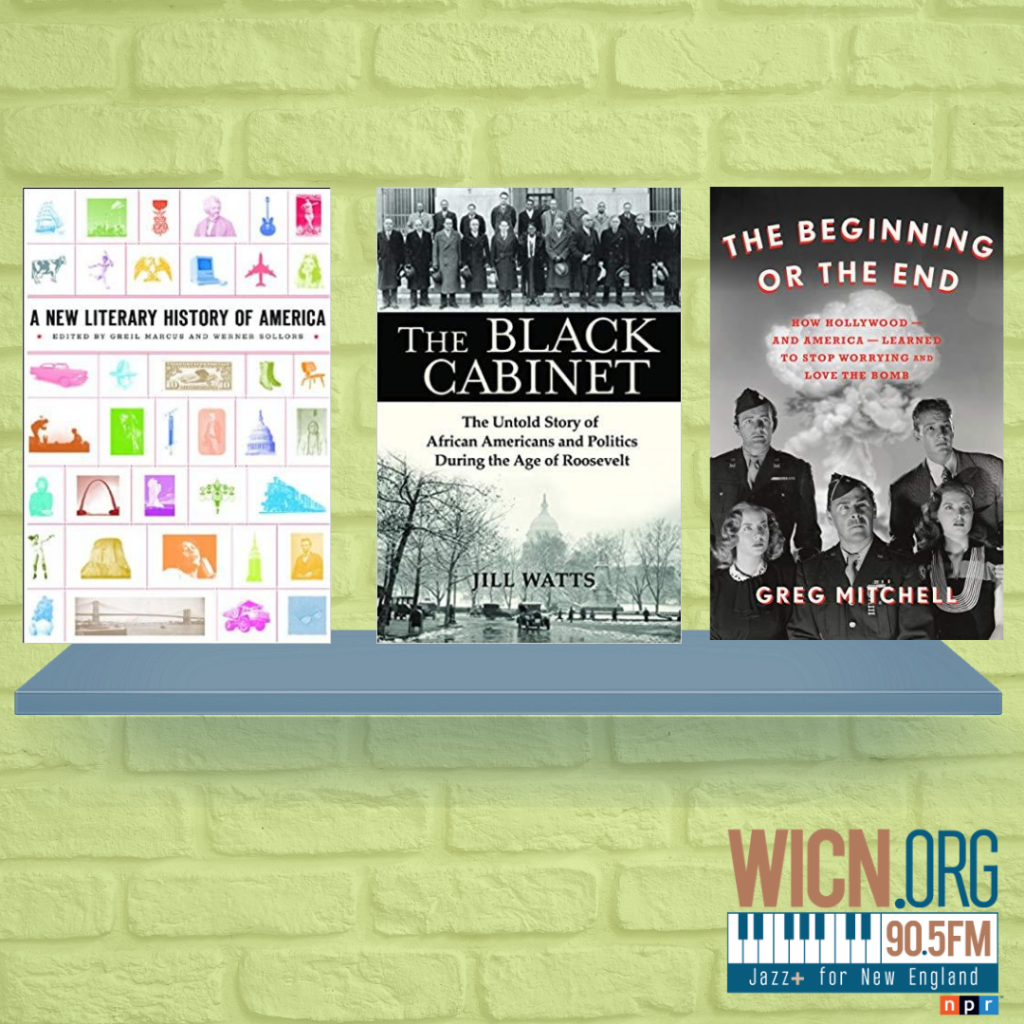
Thank you.
DON’T KNOW MUCH ABOUT HISTORY?
Below are three unique American histories:
1) GREIL MARCUS is an award-winning author and music historian. WERNER SOLLORS is the Henry B. and Anne M. Cabot Professor of English Literature and Professor of African and African American Studies at Harvard University. Together they have edited and created A NEW LITERARY HISTORY OF AMERICA, a breath-taking survey of American visual art, technology, films, and literature told through essays by numerous authors. This is an exciting and challenging compendium and quite unlike any other American history, you have read.
2) Writer and historian JILL WATTS is a Professor of History at California State University. Her new book is a compelling account of the African Americans who worked hard to effect real and permanent political change during the Franklin Delano Roosevelt administrations. Professor Watts’ “must-read” book is THE BLACK CABINET: THE UNTOLD STORY OF AFRICAN AMERICANS AND POLITICS DURING THE AGE OF ROOSEVELT.
3) Shortly after the American nuclear bombing of Hiroshima and Nagasaki, certain people in Hollywood decided that those events would make a great script for a film. What followed was a long series of crazy rewrites as people like President Truman, General Groves, the many scientists of the Manhattan Project, Eleanor Roosevelt, Ayn Rand, and many others took turns crafting a script to suit their agendas. It’s a tale worthy of a Pynchon novel, but it’s all true. Writer, historian, and editor GREG MARSHALL’s new book is titled THE BEGINNING OR THE END: HOW HOLLYWOOD-AND AMERICA-LEARNED TO STOP WORRYING AND LOVE THE BOMB.
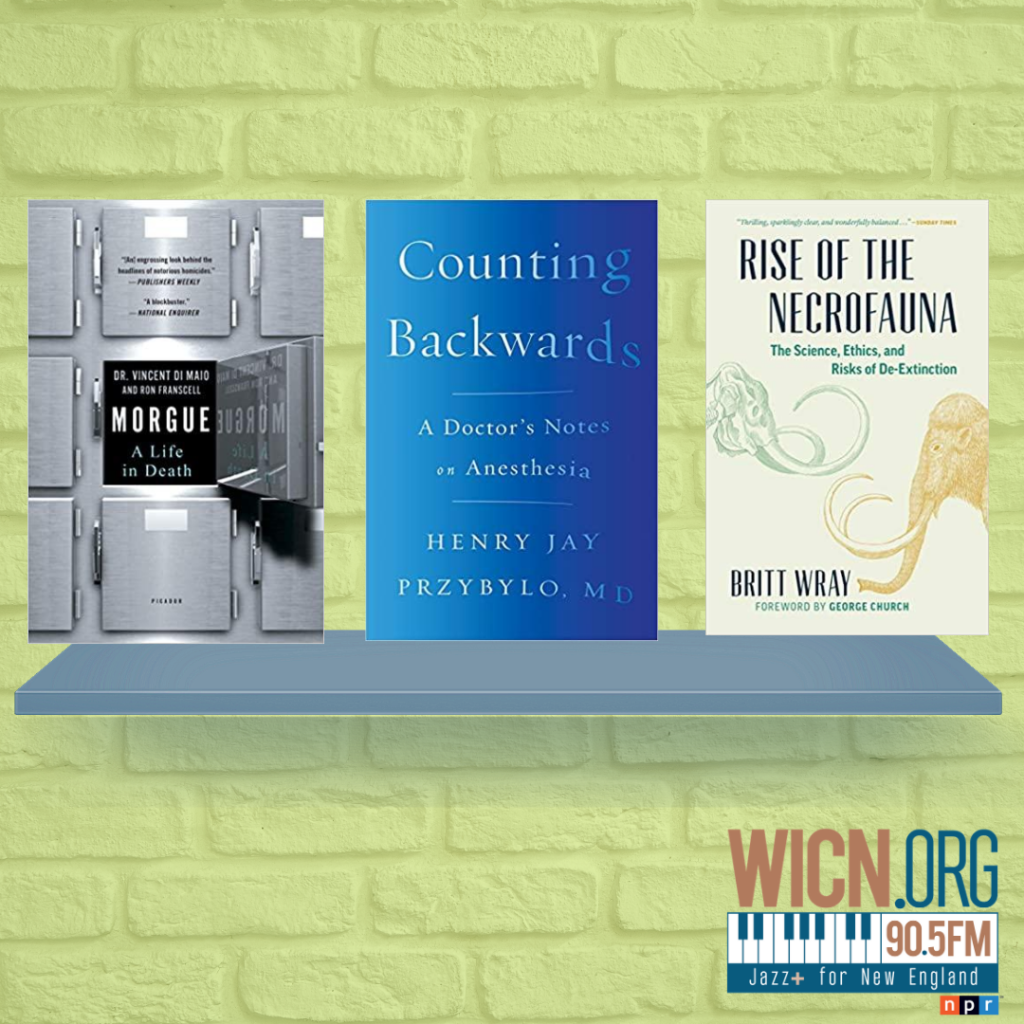
Thank you.
WEIRD SCIENCE: The out cold and down for the count list.
1) “I erase consciousness,” writes HENRY JAY PRZYBYLO, M.D., an Associate Professor of Anesthesiology at Northwestern University School of Medicine. His book, COUNTING BACKWARDS: A DOCTOR’S NOTES ON ANESTHESIA is an engrossing account of what he does in the operating room. It’s all cool, until it very much isn’t.
2) Bestselling crime author RON FRANSCELL and forensic pathologist Dr. Vincent Di Maio, have written MORGUE: A LIFE IN DEATH a memoir of some of Dr. Di Maio’s most interesting very cold cases including the exhuming of Lee Harvey Oswald’s body and looking at how Vincent van Gogh met the long goodbye!
3) There are now a number of scientists who think it might be possible to resurrect extinct species. Through a variety of genetic techniques, there are people working on bringing back the extinct Wooly Mammoth, the Auroch, and maybe even the Passenger Pigeon. But what are the ethics about bringing back to life a species that has died out? Just because we can, does that necessarily mean we should? Science writer and radio broadcaster BRITT WRAY’s book about selective re-animation is THE RISE OF THE NECROFAUNA: THE SCIENCE, ETHICS, AND RISKS OF DE-EVOLUTION.
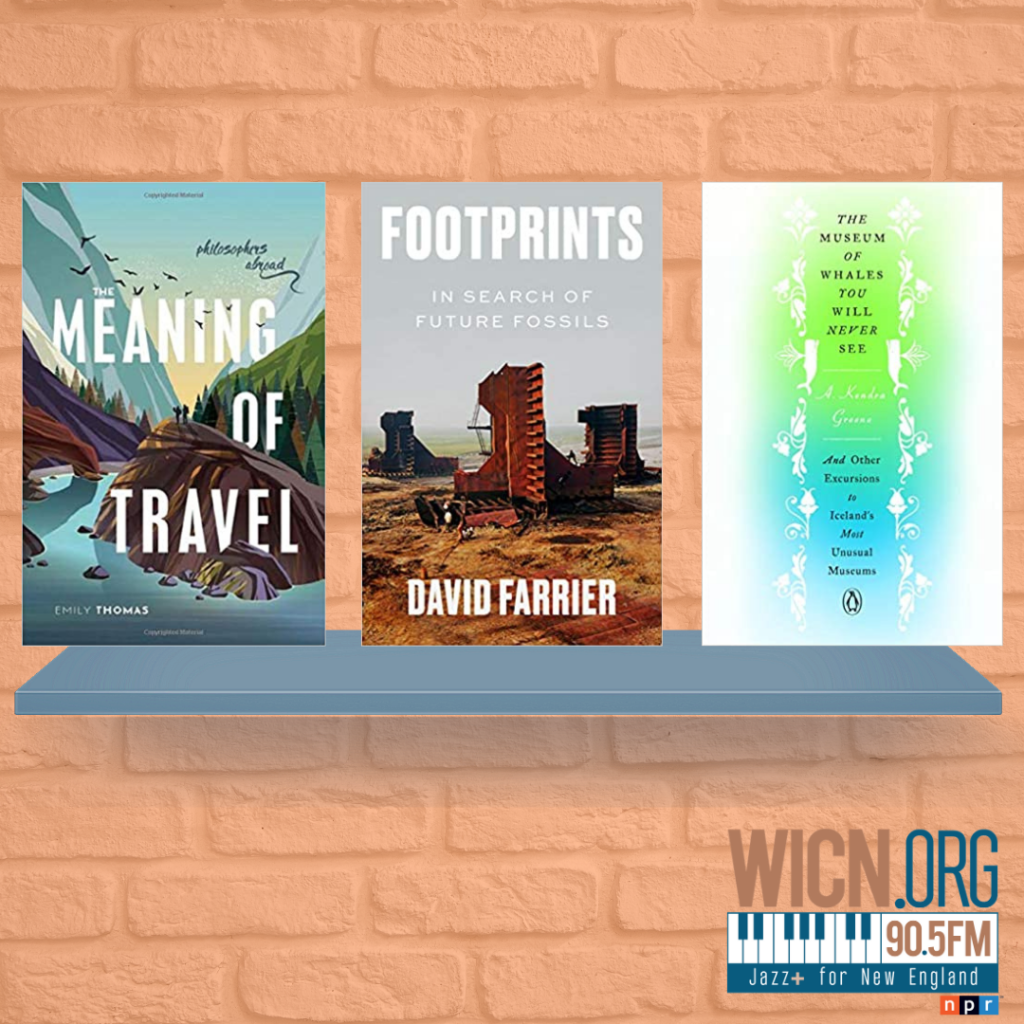
Thank you.
TRAVEL! Many of your vacations were likely cut short, changed, or canceled entirely because of COVID-19. Don’t even think about traveling abroad because most countries don’t want us! So, why not find a comfy chair, settle in, and travel vicariously by reading these three fascinating books about travel?
1) DAVID FARRIER teaches English Literature at the University of Edinburgh. In recent years he has become interested in what will be left of 21st Century human culture one million years from now. Will remnants of our great cities survive? How about our millions of miles of paved roads? So, he traveled the world looking for clues of what will be left of human civilization after we are well extinct. His thought-provoking new book is FOOTPRINTS: IN SEARCH OF FUTURE FOSSILS.
2) EMILY THOMAS is an Associate Professor in Philosophy at Durham University. Her new book examines how philosophers have looked at the importance of travel on the development of our beliefs and intelligence. Some philosophers’ writings even affected the tourist industry. Thomas’ new book is THE MEANING OF TRAVEL: PHILOSOPHERS ABROAD.
3) Iceland is a country of c.330,000 people, yet it has 265 museums and public collections. Some of these are quite idiosyncratic and odd, and located in very remote parts of the island, like The Icelandic Phallological Museum or Petra’s Stone Collection. Writer and artist A. KENDRA GREENE has written one of the most unique travel books published this year: THE MUSEUM OF WHALES YOU WILL NEVER SEE: AND OTHER EXCURSIONS TO ICELAND’S MOST UNUSUAL MUSEUMS.
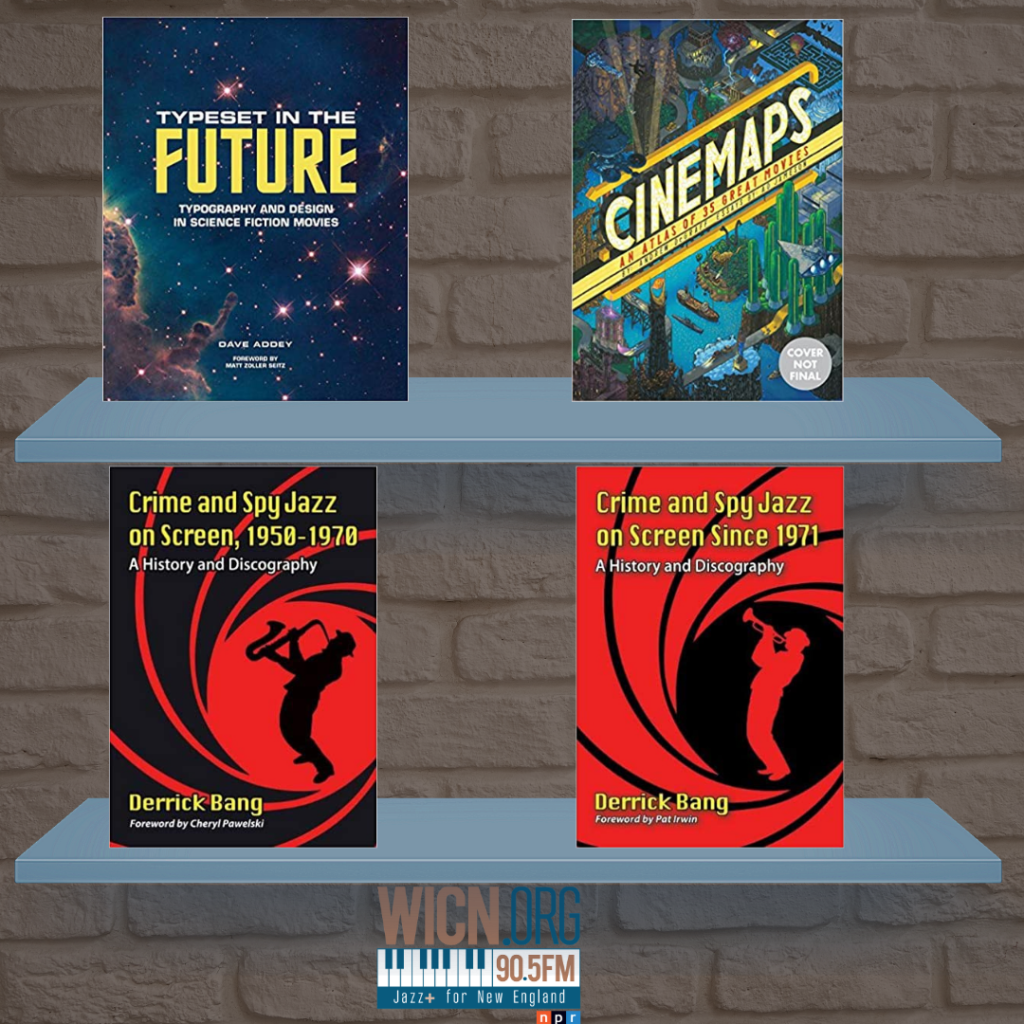
Thank you.
FOUR UNUSUAL BOOKS ABOUT CINEMA:
Most books about film are about specific directors, a biography of a well-known star, or the history of how some popular film was made. The four books below are unique film histories that are also a blast to read.
1) Illustrator and artist ANDREW DEGRAFF has a unique passion: he is a cartographer of fiction. Over the years, DeGraff has drawn wonderful very detailed maps that delineate the movements through space and time of major characters in popular films like Star Wars, the Wizard of Oz, and Fargo. A collection of these can be found in his fun, beautiful, and fascinating book: CINEMAPS: AN ATLAS OF GREAT MOVIES.
2) Have you ever wondered why the typefaces used in science-fiction movies like 2001 and Blade Runner all look the same? DAVE ADDEY is a designer, writer, software developer, and creator of the website Typeset In the Future. His large and colorful book explores the printed word as shown in films about the future: TYPESET IN THE FUTURE: TYPOGRAPHY AND DESIGN IN SCIENCE FICTION MOVIES.
3) Some of the greatest and most memorable jazz scores for television and film have been for crime and spy vehicles. Think about the dramatic intro score to Mission: Impossible or THE atmospheric music of The Ipcress File. Is the score to Shaft in fact a “jazz” score? Columnist and writer DERRICK BANG has written two thick books that together makeup one of the wildest and most entertaining jazz histories. Volume 1: CRIME AND SPY JAZZ ON SCREEN: 1950-1970 and Volume 2: CRIME AND SPY JAZZ ON SCREEN SINCE 1971. Cue the theme to James Bond.
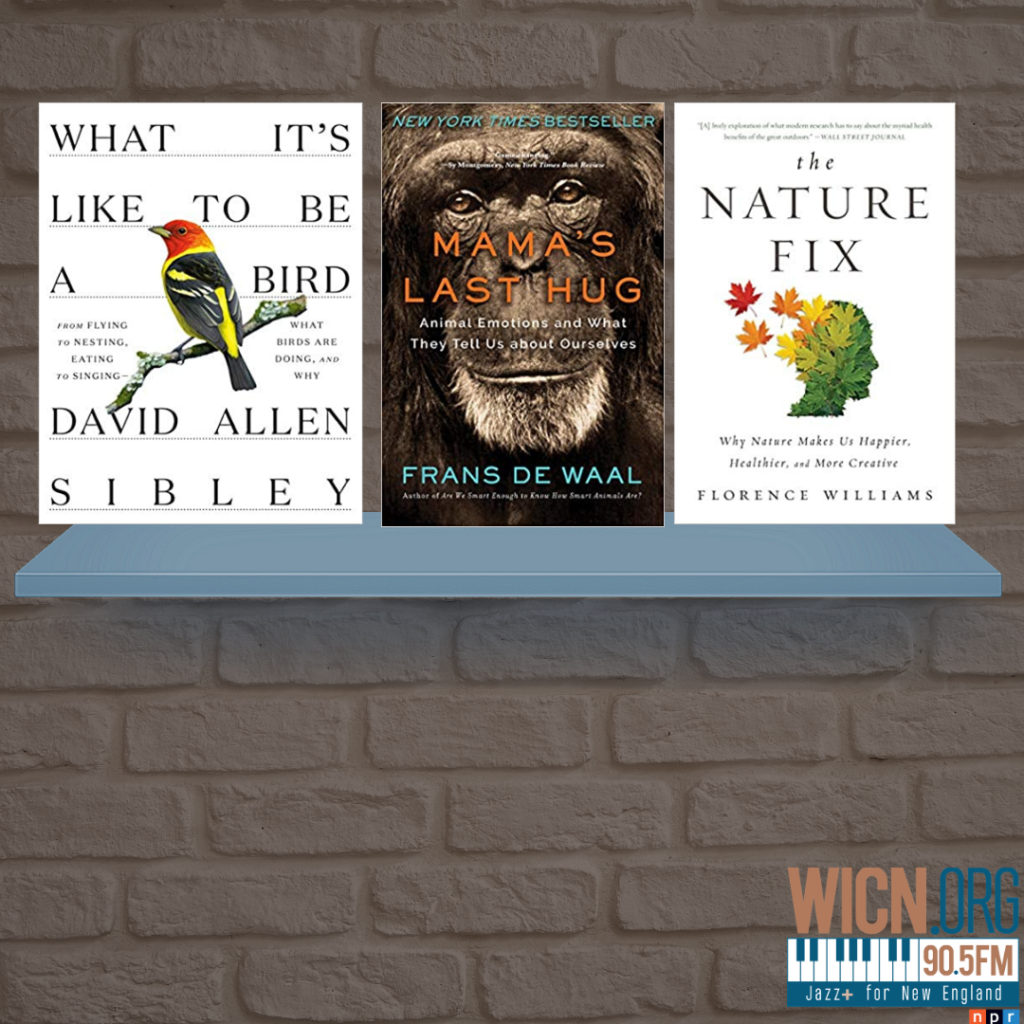
Thank you.
1) Journalist and contributing editor for Outside Magazine FLORENCE WILLIAMS has written a book about why it is important to get outside often: THE NATURE FIX: WHY NATURE MAKES US HAPPIER, HEALTHIER, AND MORE CREATIVE. In this book, Williams travels around the world to look at how scientists are trying to explore and quantify how being in forests, parks, deserts, and rivers can lower our blood pressure, reduce stress and perhaps help people deal with PTSD and ADHD.
2) Do animals have emotions? Can a chimpanzee show grief, disgust, or happiness? FRANS DE WAAL is the C.H. Candler Professor in Emory University’s Psychology Department and director of the Living Links Center at the Yerkes National Primate Research Center. His new book will forever change the way you view animals: MAMA’S LAST HUG: ANIMAL EMOTIONS AND WHAT THEY TELL US ABOUT OURSELVES.
3) Are birds “thoughtful”? Can birds actually make decisions? These are just some of the fascinating subjects discussed in DAVID ALLEN SIBLEY’s new book: WHAT IT’S LIKE TO BE A BIRD: FROM FLYING TO NESTING, EATING TO SINGING, WHAT BIRDS ARE DOING AND WHY. David Allen Sibley is the author and illustrator of a series of popular guides to nature that bear his name. This large-format, sumptuously illustrated book is for anyone interested in understanding how birds live.
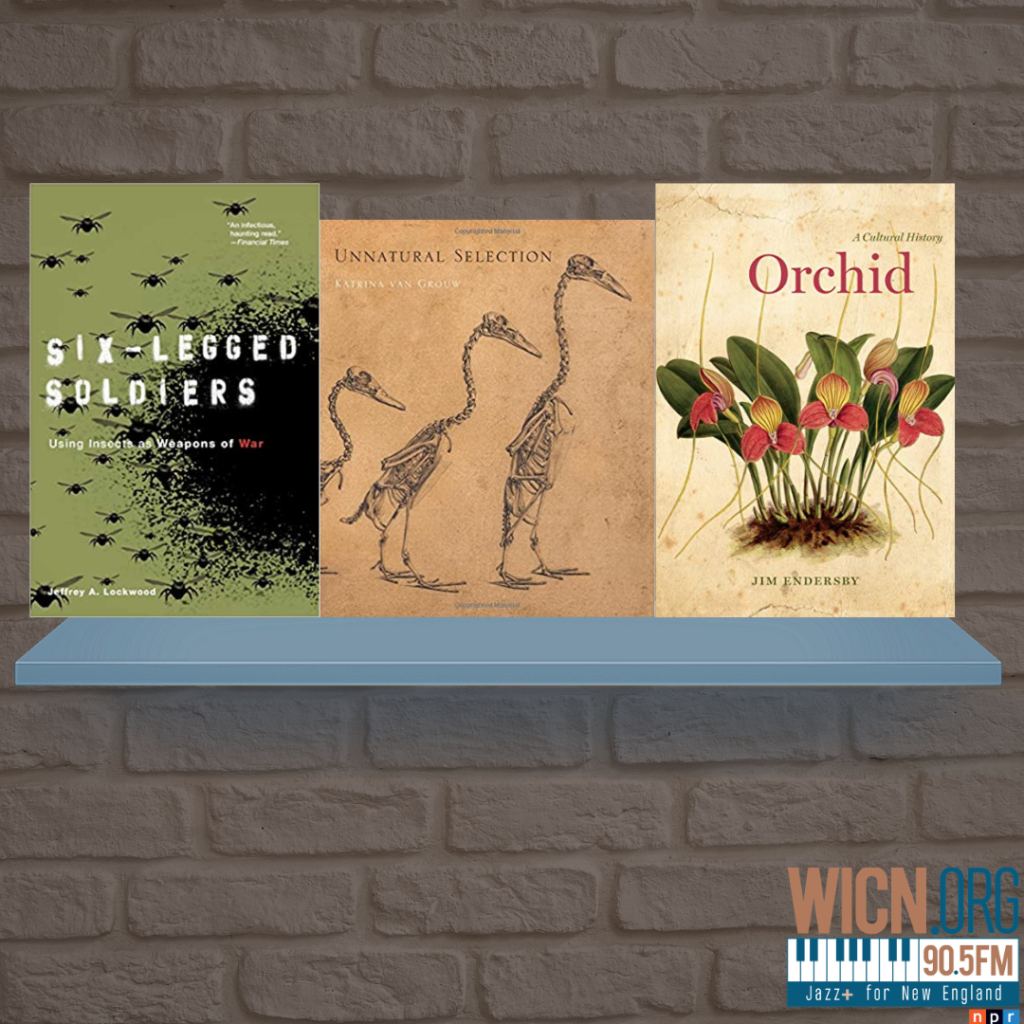
Thank you.
THREE BOOKS ABOUT HUMANS MUCKING AROUND WITH NATURE:
1) BLOOMING OBSESSIONS: Since Ancient Greece, people have been enthralled by orchids. Orchids were believed to have healing or magical properties. The 18th Century mania for collecting and growing orchids in England supported numerous expeditions to the jungles of the world where hundreds and sometimes thousands of orchids were shipped home to affluent buyers. Darwin even wrote a book about orchids. And that’s just the beginning of the orchid story. JIM ENDERSBY is a reader in the history of science at the University of Sussex. His book traces the wild and sometimes sexy history of humans and orchids: ORCHID: A CULTURAL HISTORY.
2) FUN WITH MUTANTS! “Natural selection is an irrepressible force,” writes KATRINA VAN GROUW. She is an artist, natural historian, and writer. Her book UNNATURAL SELECTION is both a stunning collection of her anatomical art combined with a scholarly, but very entertaining, text about selective breeding, genetics, and evolution. If you own a breed of dog, cat, bird, or fish, you will want to read this book and learn how “fanciers can fast forward evolution.” You will never look at your Pug the same way again.
3) IS THAT A FLY IN MY SOUP OR A TERRORIST WEAPON? Many people suffer from insect phobias, but have insects ever been used as large-scale offensive weapons? Is it possible terrorists could use plague-infected fleas to wreak havoc in one of our cities? Has this ever been tried in the past? JEFFREY A. LOCKWOOD is a Professor of Natural Sciences and Humanities at the University of Wyoming. Professor Lockwood has written one of the most unnerving, original, and downright creepy histories of biological warfare titled SIX LEGGED SOLDIERS: USING INSECTS AS WEAPONS OF WAR. Read it and learn how deadly mosquitoes and flies have been used to turn the tide of battles.
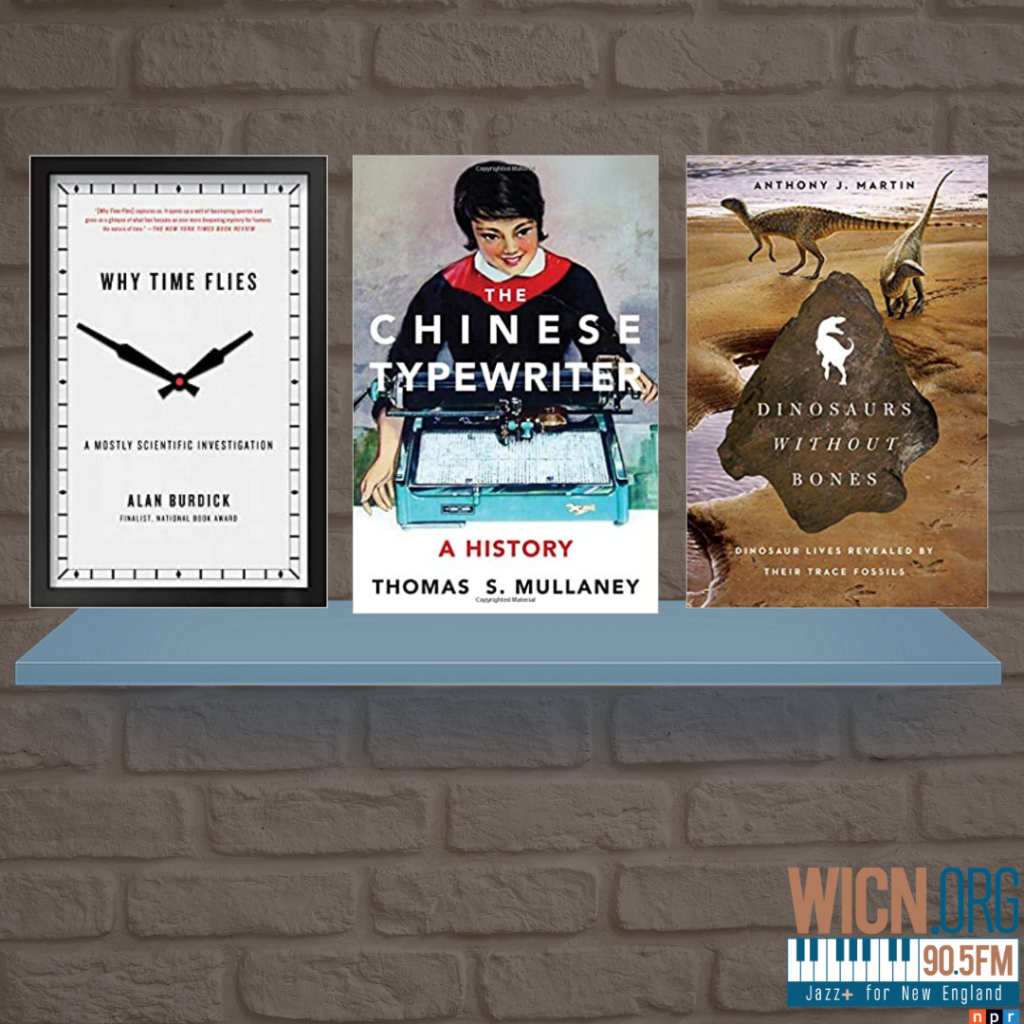
Thank you.
HAVE YOU EVER WONDERED????
1) HOW DID HUGE DINOSAURS HAVE SEX? ANTHONY J. MARTIN is a professor at Emory University, a paleontologist, geologist, and one of the world’s most accomplished ichnologists. In this book, he describes what is currently known about dinosaur sex, dinosaur eggs, and nests. Are there fossils of dino puke? How about dino scat? Do dinosaurs exhibit parental care? How does an enormous sauropod lay an egg without having it break? And what about dino sex anyway? Martin’s classic book is titled DINOSAURS WITHOUT BONES: DINOSAUR LIVES REVEALED BY THEIR TRACE FOSSILS.
2) WHY DO THOSE LAST TWO HOURS OF WORK SEEM LIKE YEARS? Why does time seem to speed up the older we get? Do we have an internal clock that regulates the body and mind? Can we purposely make time seem to speed up or slow down? When is now? Writer and editor ALAN BURDICK answers these questions and more in his book: WHY TIME FLIES: A MOSTLY SCIENTIFIC INVESTIGATION.
3) WHAT DID CHINESE TYPEWRITERS LOOK LIKE? THOMAS S. MULLANEY is an Associate Professor of History at Stanford University. His book is a fascinating history of technology, language, and invention: THE CHINESE TYPEWRITER: A HISTORY.
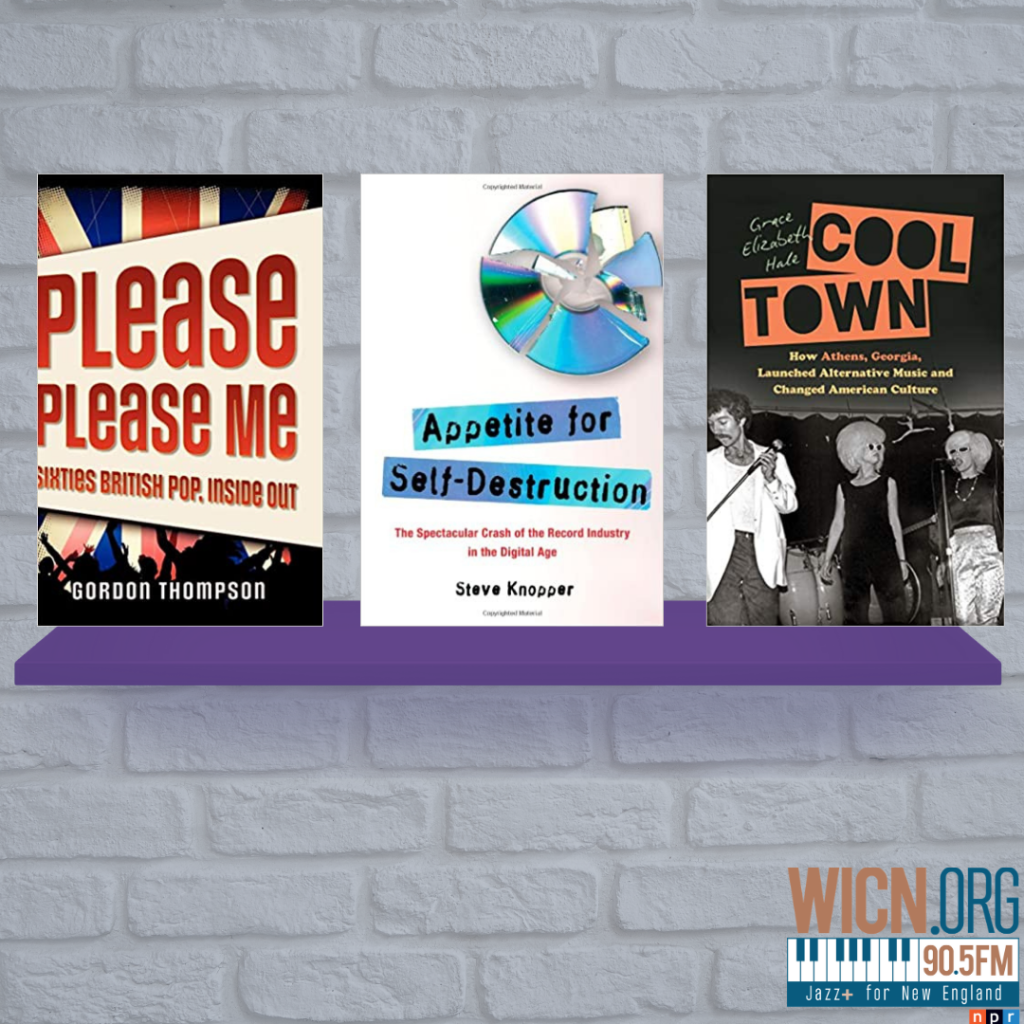
Thank you.
SOME INTERESTING MUSICAL HISTORY FOR YOU:
1) The invasion of those lovable mop tops! GORDON THOMPSON is a Professor of Music at Skidmore College and author of a scholarly and entertaining history called PLEASE, PLEASE ME! SIXTIES BRITISH POP INSIDE OUT. Professor Thompson brings a musicologist’s rigor to analyzing what made the ‘60s music of groups like The Rolling Stones, Pink Floyd and of course The Beatles so unique and how bands of the time wrote songs and got produced. Pick up this book and find out the inside scoop on “Winchester Cathedral.”
2) Free the music! The history of the music and recording industries in the last 35 years is a sorry story of consistent short-sightedness and resistance to technological innovation. Journalist and editor STEVE KNOPPER has written a lively insider’s story of how the record industry was dragged kicking and screaming into the 21st Century when they were confronted with CD technology, MP3s, file sharing, and Napster. The final nail in the coffin was smartly served up by Steve Jobs and the iPod. Is there any future for the consistently behind-the-times recording industries? Knopper’s dynamic history is titled: APPETITE FOR SELF-DESTRUCTION: THE SPECTACULAR CRASH OF THE RECORD INDUSTRY IN THE DIGITAL AGE.
3) Dance this mess around! Athens, Georgia in the 1970s was a very unlikely place to expect an active alternative culture that would begin a revolution in music. Groundbreaking bands like the B52s, R.E.M., Pylon, and many others all called Athens home and got their start there. What was going on in Athens during that time? GRACE ELIZABETH HALE is the Commonwealth Professor of American Studies and History at the University of Virginia. Her new book chronicles the rise of the bohemian culture of Athens: COOL TOWN: HOW ATHENS, GEORGIA, LAUNCHED ALTERNATIVE MUSIC AND CHANGED AMERICAN CULTURE.
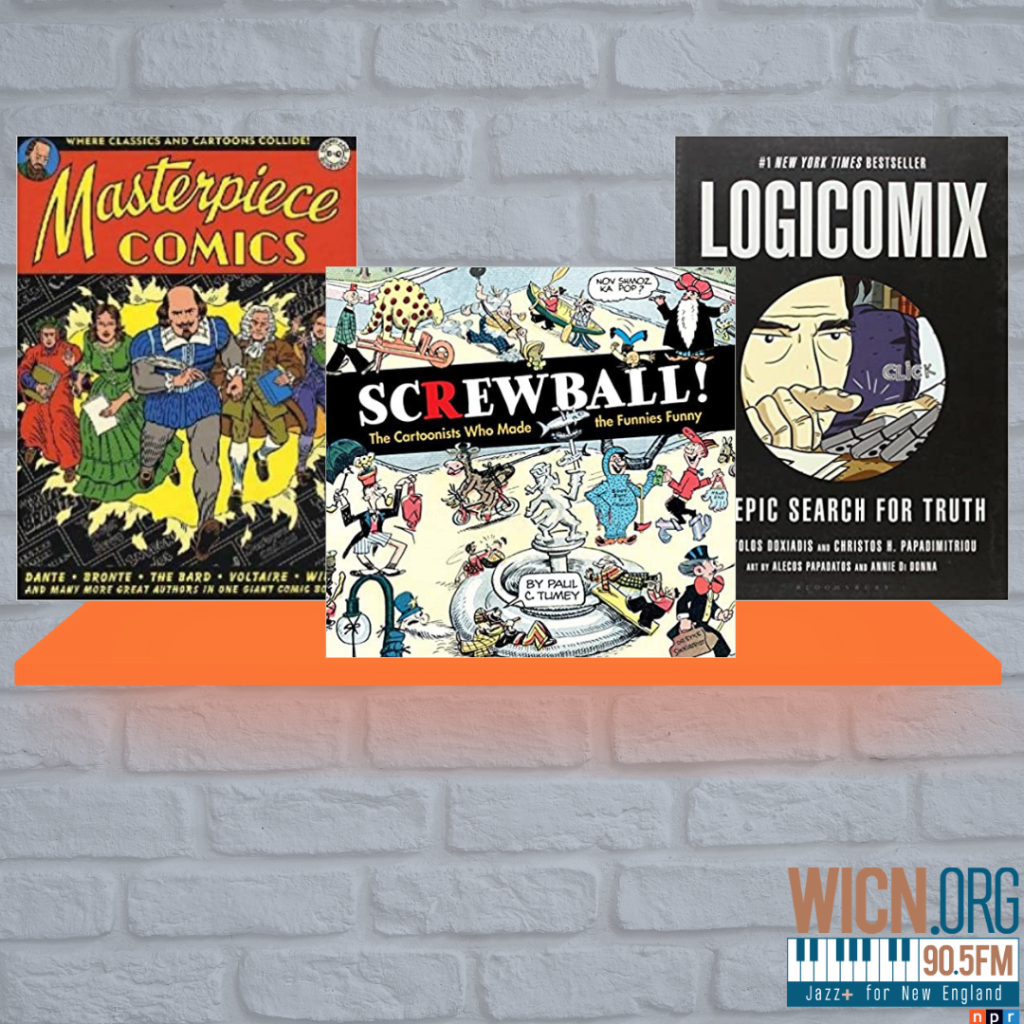
Thank you.
COMICS FOR ALL TASTES!
Can’t bear to read the news because of all that is going on? Have you had one too many Zoom meetings? Starting to feel like you are living in a dystopian novel written by a sadist? Why not turn to some graphic entertainment for relief?
1) DOES THE WORD “EPISTEMOLOGY” GIVE YOU A THRILL? One of the most unique and exciting graphic novels created in some time centers around the unlikely subject of Bertrand Russell’s search for mathematical proof based on logic and his decades-long struggle to write Principia Mathematica. This almost unreadable series of highly technical logic books take 362 pages just to prove that 1+1=2. And ultimately this life’s work was shown to be a pointless and impossible endeavor! CHRISTOS PAPADIMITRIOU, writer and C. Lester Hogan Professor of Computer Science at the University of California, Berkeley teamed up with APOSTOLOS DOXIADIS, a writer who has done award-winning work in film and theatre. Together with artists ALECOS PAPADATOS and ANNIE DI DONNA, they have created a stunning graphic history of 20th Century logic, mathematics, and philosophy that manages to be compelling, thrilling, and beautiful. LOGICOMIX: AN EPIC SEARCH FOR TRUTH weaves the passionate conversations of Christos and Apostolos with the life stories of Russell, Alfred North Whitehead, Ludwig Wittgenstein, and many others and along the way, the ancient Greek play, The Oresteia, is even retold! Against all odds, it all hangs together wonderfully and the result is a truly unique and moving work of writing and art.
2) DO YOU LIKE THE DIVINE COMEDY AND MAD MAGAZINE EQUALLY? Imagine Dante’s classic L’Inferno, told entirely through Bazooka Joe Bubble Gum comics complete with cheesy prizes and gum wrappers. Or perhaps you would like to see Charlie Brown as Gregor Samsa or Little Lulu as Hester Prynne. Or maybe Beavis and Butthead in a production of “Waiting for Godot.” Welcome to the wild world of MASTERPIECE COMICS: WHERE CLASSICS AND COMICS COLLIDE. Artist, teacher, and cartoonist R. SIKORYAK has created a unique literary art form, a surprising smash-up between great literature and classic comics, many now compiled for the first time in one large insanely wonderful volume.
3) DO YOU LOVE THE THREE STOOGES AND ORIGINAL POPEYE CARTOONS? For the first half of the 20th Century, several comic artists drew madcap, crazy strips, and series. These artists included Rube Goldberg, George Herriman, and E.C. Segar, the creator of Popeye. Comics historian PAUL C. TUMEY has compiled a hilarious new history: SCREWBALL! THE CARTOONISTS WHO MADE THE FUNNIES FUNNY. The book is chock full of perfectly reproduced zany strips from papers.
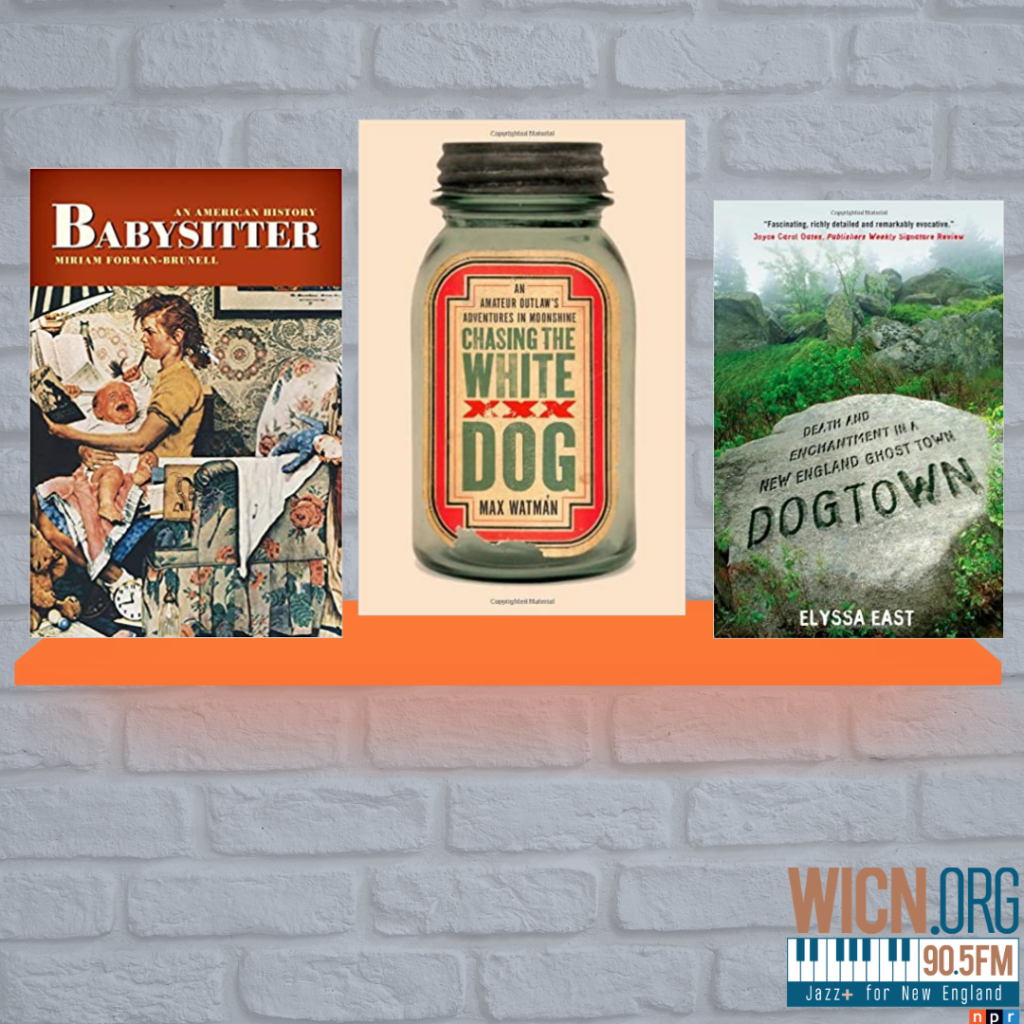
Thank you.
THREE INTERESTING BITS OF AMERICAN HISTORY: BOOGEYMEN, BOOZE, AND BABYSITTERS
1) Marsden Hartley painted some of his finest works here. This was also the scene of a recent horrific violent murder. “There is something different about Dogtown,” as one Gloucester resident put it. It is a place both beloved for its lonely natural beauty and feared for its eerie sense of gloom and foreboding. Writer ELYSSA EAST started out to write about Harley’s experiences in Dogtown and soon got swept up in the weird and wild history of this very unusual spot. Her book DOGTOWN: DEATH AND ENCHANTMENT IN A NEW ENGLAND GHOST TOWN is a complex book. It is by turns a chilling murder mystery, a wildly arcane New England history, an investigation on how a strange geographic location can inspire artists, and a sensitive portrait of one of New England’s great coastal communities. If you are interested in strange New England history, pick up this book.
2) Homemade hard “likker”, moonshine, is still made in many parts of the country. But are these moonshiners the cartoonish Appalachian hillbillies with patched genes and corncob pipes or are they romantic rednecks like Robert Mitchem in Thunder Road? Writer and correspondent MAX WATMAN set out to meet some genuine bootleggers and thus begins a wild tale of dangerous nip joints, the “Andy Warhol of hooch”, and something called “turbo yeast”. Along the way, Waxman tells the complex history of homemade liquor in America, the Whisky Rebellion, the coming of the “Revenooers” and the “The Big Lie” of Prohibition. He also cooks up some of his own illegal white lightning for good measure. This is a unique and wild book: CHASING THE WHITE DOG: AN AMATEUR OUTLAW’S ADVENTURE IN MOONSHINE.
3) Babysitting is really a 20th Century phenomenon, one that only took off in the Depression. But society’s ideas about the babysitters were and are often at odds with the reality, and these differences reflect a cultural battlefield that has existed over the development of a teen girl culture. Did you know that for decades babysitters have tried to organize? Or that many teen girls have always been very ambivalent about babysitting? Why have babysitters been shown to be the victims of so many slasher films? Why are there so many apocryphal stories about bad babysitters? What do the answers to these questions say about how our society looks at teenage girls? MIRIAM FORMAN-BRUNELL has written a complex and fascinating book: BABYSITTER: AN AMERICAN HISTORY.
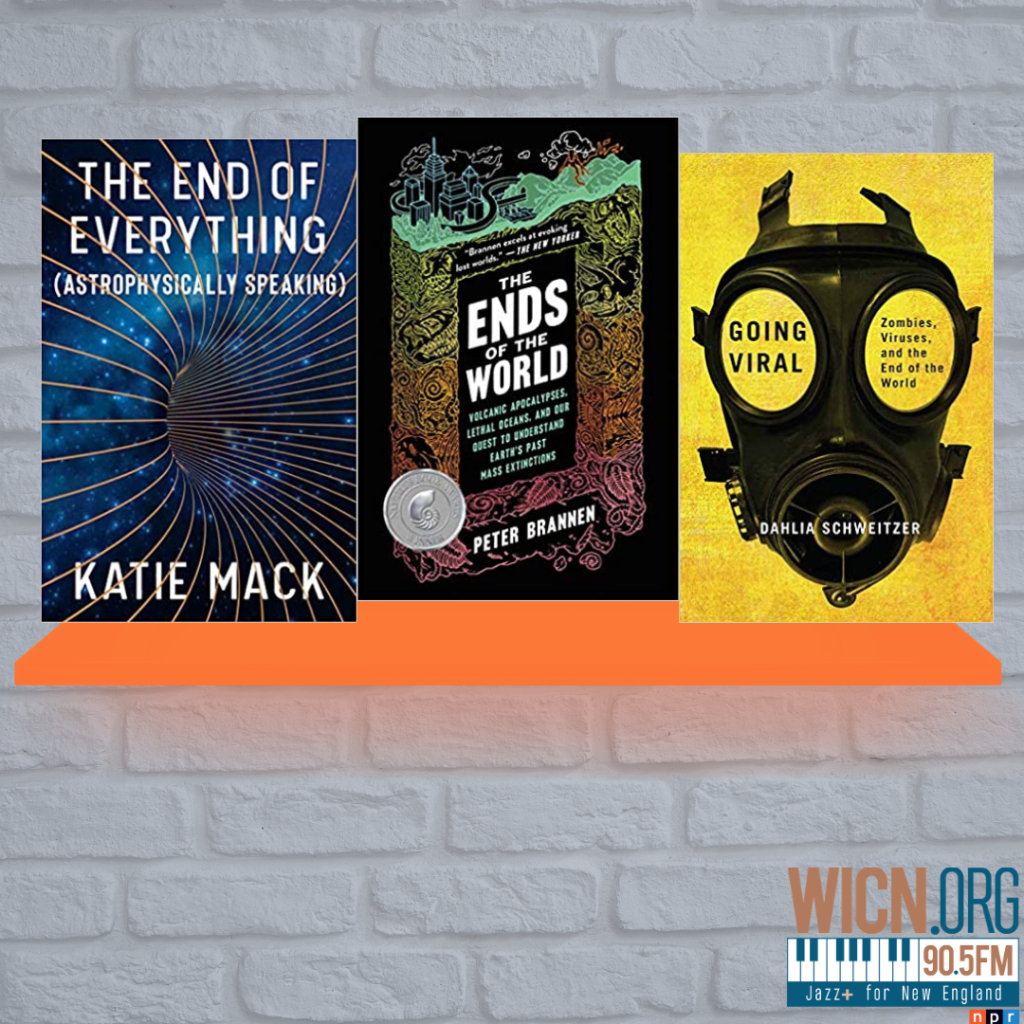
Thank you.
THINGS REALLY COULD BE WORSE…Cheer up! Here are three books about things getting even worse than this year (I know: hard to believe):
1) THE END OF HUMANITY: Movies and television shows about outbreaks of contagious diseases and plagues of zombies are common. But why are these stories so popular? DAHLIA SCHWEITZER is an adjunct professor at the Art Center College of Design in Pasadena, California. Her book unearths the “outbreak narrative:” GOING VIRAL: ZOMBIES, VIRUSES, AND THE END OF THE WORLD. We are living this right now.
2) THE END OF EARTH: Earth has had five mass extinction events over the millennia, global disasters that have wiped out much of the life on the planet. Most of these were not caused by an impact by an asteroid. Why do these events happen and what can they tell us about the results of how we are altering the climate today? Award-winning science journalist PETER BRANNEN has written a great book about these planet-wide disasters: THE ENDS OF THE WORLD: VOLCANIC APOCALYPSES, LETHAL OCEANS, AND OUR QUEST TO UNDERSTAND EARTH’S PAST MASS EXTINCTIONS.
3) THE END OF EVERY JOT AND TIDDLE: Have you ever wondered how it’s all going to end? Not just you. Not just Earth. Not simply our solar system. But the whole kit and caboodle, every jot and neutron, gone forever. The Big Nada. DR. KATIE MACK is a theoretical astrophysicist and assistant professor of physics at North Carolina State University and she has compiled some of the best serious scientific theories about the ultimate fate of the universe. The title of her book says it all: THE END OF EVERYTHING (ASTROPHYSICALLY SPEAKING).
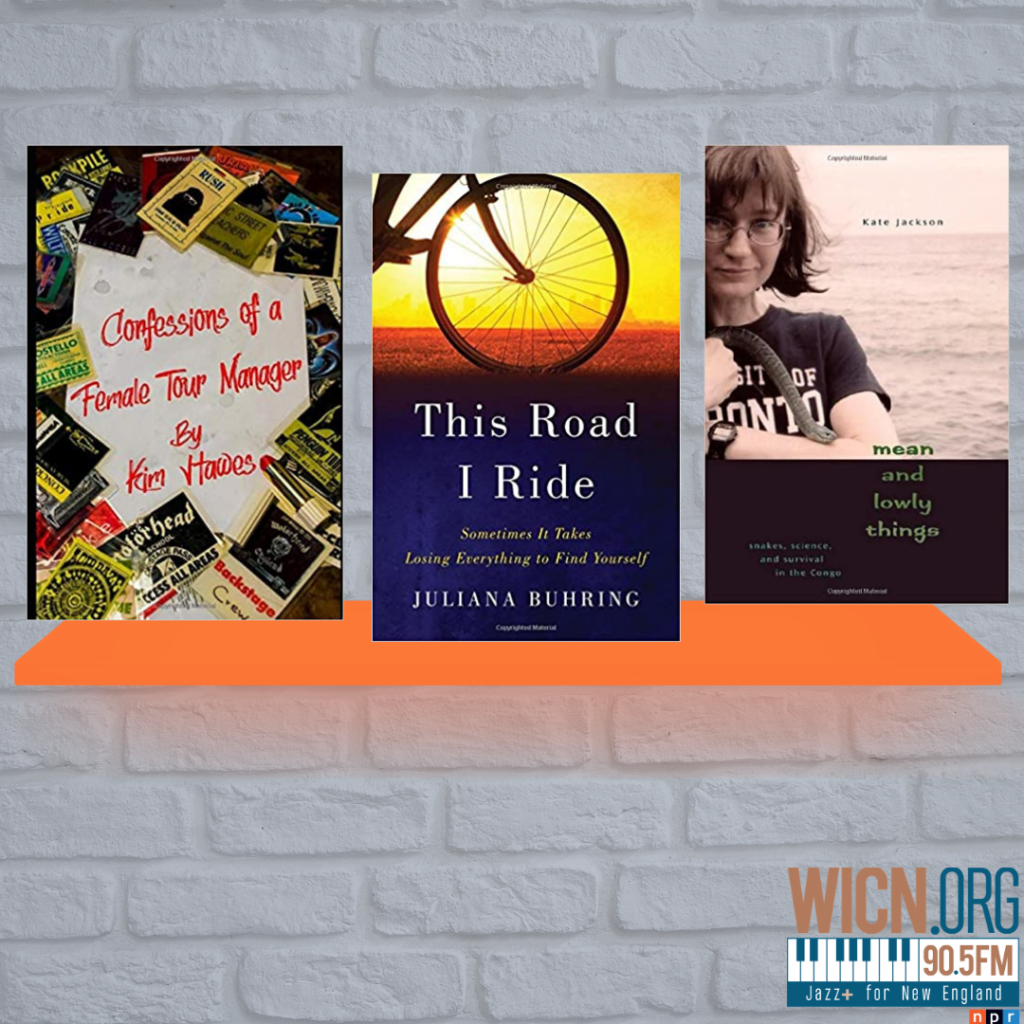
Thank you.
EXTREME OCCUPATIONS: Tired of wasting away in middle management? Dreading another day in the service industry? Has COVID made you rethink what you are doing with your time? Here are three books by three women who decided to do something your high school guidance counselor would never have recommended.
1) Ever wonder what it would be like to go on tour with a major rock band? KIM HAWES has toured with bands like Hawkwind, Concrete Blonde, and Mötorhead, first as a merchandising marvel and then as a band manager. Her wonderful, story-filled memoir is titled CONFESSIONS OF A FEMALE TOUR MANAGER: THIS WOMAN’S LIFE ON THE ROAD WITH SOME OF THE MOST NOTORIOUS ROCK BANDS EVER.
2) When JULIANA BUHRING set off on her record-breaking 18,063 mile trip around the world on her bicycle, Pegasus, she had no sponsors or funding. Even more amazing is the fact that when she had come up with the idea of doing this feat, she hadn’t even seriously ridden a bike! In the end, she became the fastest woman to circumnavigate the world by bike, and her wild story is told in her book THIS ROAD I RIDE: SOMETIMES IT TAKES LOSING EVERYTHING TO FIND YOURSELF.
3) Herpetologist KATE JACKSON, Assistant Professor of Biology at Whitman College, has spent several years doing fieldwork collecting snakes, lizards, and frogs in the remote forests of the Congo. The conditions under which she worked were nothing less than horrible: she lived in what can only be termed the “idea” of a shelter. She ate food that redefined “inedible.” There was constant rain and high humidity; daily onslaughts of ants, bees, wasps, and screw flies whose larvae hatch and grow under your skin. Finally, there was the very real possibility she would be bitten by a deadly venomous snake far from any medical help. But she loved every minute of her work because she is truly a passionate field biologist. This is a sobering “behind the scenes” book about how science is really done in the field and what it takes to collect deadly cobras and other ophidian treasures. Her exciting and revealing book is MEAN AND LOWLY THINGS: SNAKES, SCIENCE AND SURVIVAL IN THE CONGO.
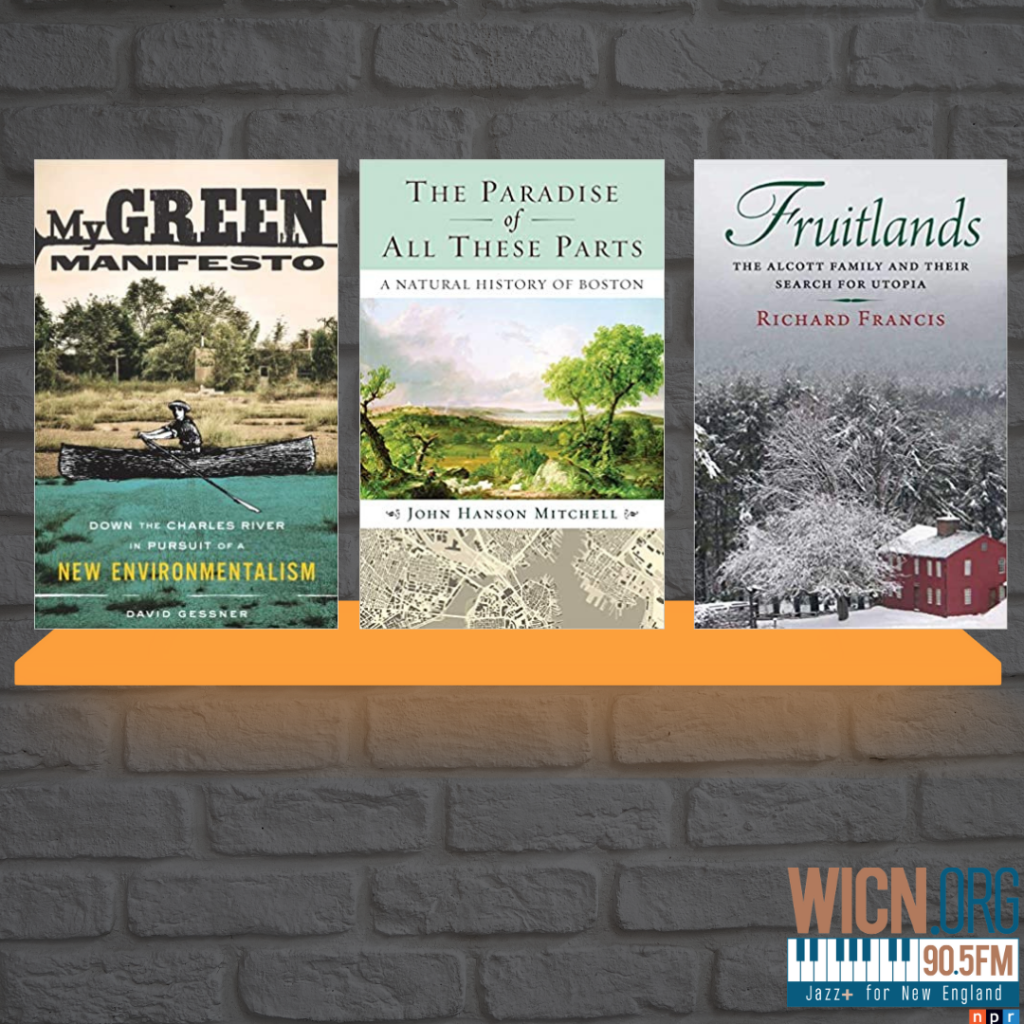
Thank you.
MASSACHUSETTS RESIDENTS AND THE NATURE AROUND THEM: IT’S NOT JUST BEANS, LOBSTERS, AND DUNKS. Here are three books that celebrate the history of natural history of our Bay State.
1) In the mid-1800s, a number of Americans formed unique communes to live separate from the rest of society and aspire to a more spiritual life. None of these experiments in living were as unique or as destined for failure as the Fruitlands in Harvard, Massachusetts. Founded by Bronson Alcott, father of Louisa May, the Fruitlanders had very strict beliefs about diet, sex, and what you could wear. But their tight little group nestled in the hinterlands could not avoid internal turmoil and conflict that would eventually tear their idyllic group life apart. This is a gripping story of lofty spiritual ideals chaffing against earthbound human emotions. RICHARD FRANCIS is a Research Fellow at Harvard and he has taught American Studies on both sides of the Atlantic. His fascinating history is titled FRUITLANDS: THE ALCOTT FAMILY AND THEIR SEARCH FOR UTOPIA.
2) Award-winning author and editor JOHN HANSON MITCHELL has written a natural history of Boston. From the Pleistocene glaciers to the coming of the Paleo-Indians and the creation of the Emerald Necklace, the dark days of the “New Boston” and finally the re-greening of the city, it’s all in this complex but thoroughly enjoyable account of the green spaces of this grand city. Mitchell’s book is titled THE PARADISE OF ALL THESE PARTS: A NATURAL HISTORY OF BOSTON.
3) Professor DAVID GESSNER is one of my favorite authors of books about history and the environment. One of his really enjoyable travel books is MY GREEN MANIFESTO: DOWN THE CHARLES RIVER IN PURSUIT OF A NEW ENVIRONMENTALISM. During a dayslong canoe and kayak trip down the Charles River with his friend Dan Driscoll, David observes the wonders of urban wildlife while at the same time meditating on what has gone wrong with environmentalism and why it has lost its powers to excite and motivate the masses. If you “love that dirty water”, pick up this book.
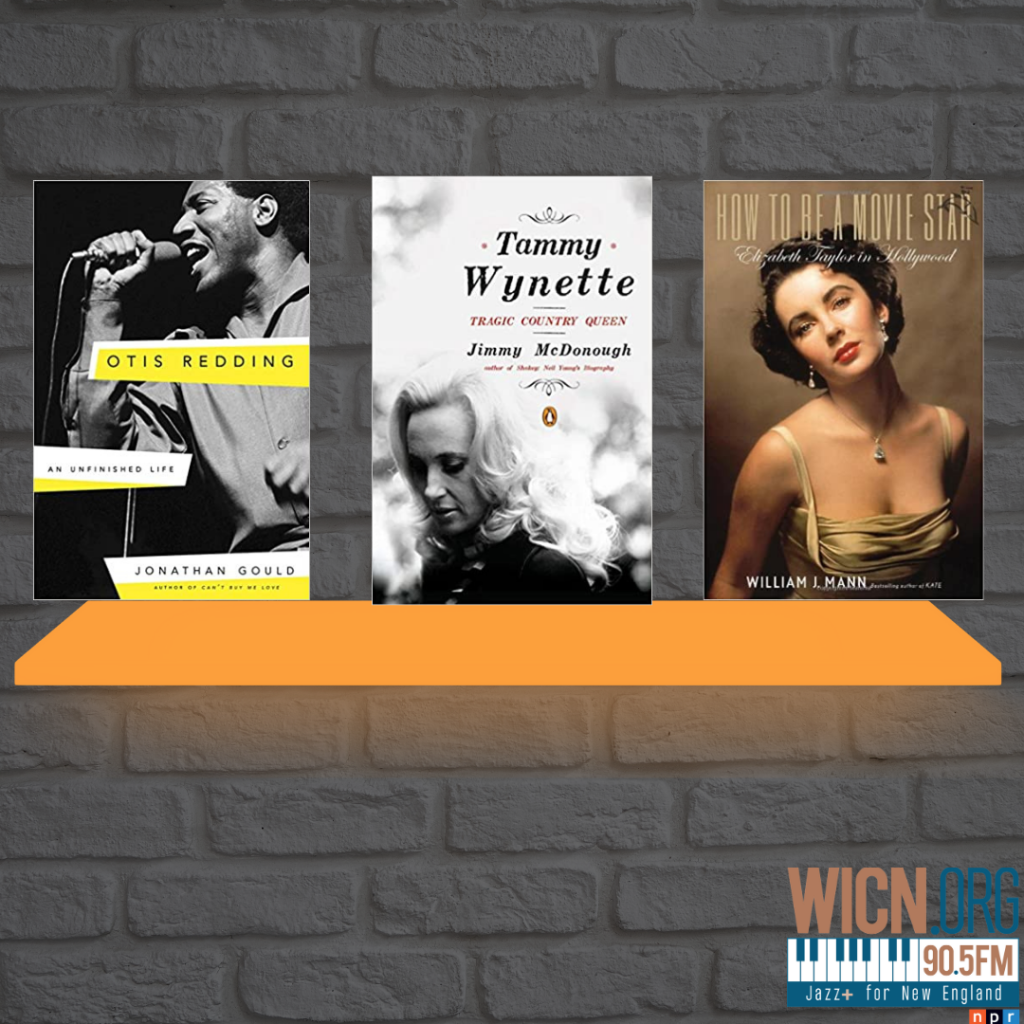
Thank you.
COMPLICATED LIVES, WELL-LIVED:
This week’s books are biographies of three well-known people whose lives still touch people.
1) “No one has done anything that Elizabeth Taylor didn’t do first-and without the excess calculation.” writes biographer WILLIAM J. MANN. Elizabeth Taylor defined the modern ideas of “stardom”. Before Elizabeth Taylor, the “paparazzi” were just a “bunch of aggressive Italian photographers. “Throughout her long career, she has made decisions, chosen films, even married partners that would allow her to be who she wanted to be. She was never a pawn of the antiquated studio system, and has never cared what the press or the gossip mongers have had to say”. Mann writes about Taylor’s “chocolate sundae years” when she made some of her most famous films and had some of her most notorious marriages and torrid love affairs. Mann’s must-read biography is HOW TO BE A MOVIE STAR: ELIZABETH TAYLOR IN HOLLYWOOD.
2) She looked like a “tiny, troubled wisp of a human being” as she stepped up to the mike, but when she opened up her mouth, out came “an atom bomb voice”. This is how JIMMY McDONAUGH , writer, autobiographer, describes Tammy Wynette. She sang before five presidents, had twenty #1 hits and five husbands, and is loved fiercely by her fans. Tammy was one of the great country music stars of the 20th Century, with hits like “Your Good Girl’s Gonna Go Bad”, “Stand By Your Man”, and “Apartment #9”. Yet as her success mounted, her health crumbled until her untimely death. McDonough has talked with many of the people involved in her life, her producers, her friends and exes, and has created a monumental, wild yet still moving, biography. His book is titled: TAMMY WYNETTE: TRAGIC COUNTRY QUEEN.
3) Georgia-born Otis Redding was one of the great soul singers of the 1960s with his intense performances of his songs like “Try a Little Tenderness” and “I’ve Been Loving You So Long”. Sadly, his career was cut far too short when he died in a plane crash in 1967. Musician and writer JONATHAN GOULD’s biography is titled: OTIS REDDING: AN UNFINISHED LIFE.

Thank you.
Keyboard? Check! Guitar? Check! Vocalist? Check! Now, all we need is a drummer and we have got a band.
1) The piano is 300 years old and from the time of its creation, it has cast a spell over musicians and audiences alike. The piano changed the ways musicians toured and presented themselves to the public. The piano also changed audiences’ expectations about presentation and showmanship. From Mozart’s first concertos to Jerry Lee Lewis’ incendiary keyboard techniques, the piano has captured the mind and soul of musicians and listeners all over the world like no other musical instrument. Pianist and writer STUART ISACOFF’s fascinating and entertaining history is A NATURAL HISTORY OF THE PIANO: THE INSTRUMENT, THE MUSIC, THE MUSICIANS. FROM MOZART TO MODERN JAZZ AND EVERYTHING IN BETWEEN.
2) Keerrrrang! Writer BRAD TOLINSKI, who was the Editor in Chief of Guitar World magazine, and writer ALAN DI PERNA, who is a longtime contributor to Guitar World and Guitar Aficionado, have written a fine history of the electric guitar. This book begins with the first electric guitar pickup in the 1920s and runs through to Jimi Hendrix playing the Star-Spangled Banner at Woodstock. Their book is: PLAY IT LOUD: AN EPIC HISTORY OF THE STYLE, SOUND, AND REVOLUTION OF THE ELECTRIC GUITAR.
3) Joni Mitchell is the iconic singer-songwriter, widely considered one of the greatest songwriters of all time. DAVID YAFFE is a critic, writer, and professor of humanities at Syracuse University. His book is a lively, in-depth, and fascinating biography of this musical legend: RECKLESS DAUGHTER: A PORTRAIT OF JONI MITCHELL.
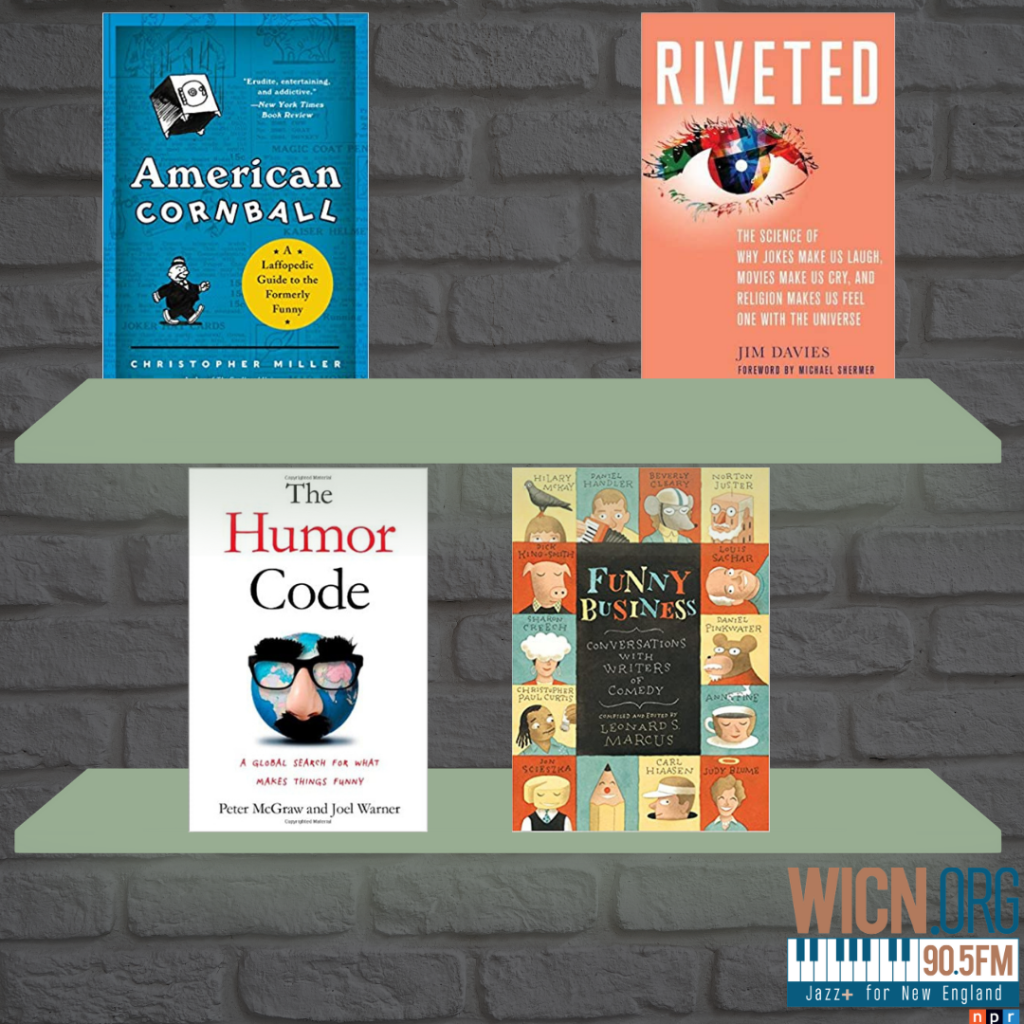
Thank you.
A HORSE WALKS INTO A BAR…
We could all use some humor right now. But we rarely agree on what is funny. Over the past decades, I’ve had the pleasure to speak with a number of authors that have attempted to understand what is funny. Here are a few of their noteworthy books…
1) Why are Japanese game shows so funny to the Japanese but don’t seem so funny to Americans? What makes a New Yorker cartoon hilarious? What kind of humor is found in Palestine? Journalist and writer JOEL WARNER and PETER MCGRAW, Ph.D., a professor at the University of Colorado in Boulder, decided to explore what’s funny around the world and discover if humor translates from one culture to the next. These stories from the field are collected in THE HUMOR CODE: A GLOBAL SEARCH FOR WHAT MAKES THINGS FUNNY. It was one wild and crazy trip!
2) If writing comedy is hard, authors who write comedy for young audiences must have very special and unique talents. One of the world’s most respected writer on children’s literature, LEONARD MARCUS, has assembled a collection of interesting and entertaining interviews that he conducted with noted children’s authors like Judy Blume, Daniel Handler, Norton Juster, and Jon Scieszka about how they write “funny” for young people. Why do children find Captain Underpants infinitely hilarious? Pick up a copy of Leonard Marcus’ book FUNNY BUSINESS: CONVERSATIONS WITH WRITERS OF COMEDY.
3) Writer CHRISTOPHER MILLER compiled a hilarious and fascinating encyclopedia of funny objects and conventions from the comics, jokes and films of the early decades of the Twentieth Century. Included are citations on anvils, hen-pecked husbands, B.O., pie fights, Limburger Cheese and so much more. If you have ever watched a Three Stooges short and wondered what “alum” was, pick up a copy of AMERICAN CORNBALL: A LAFFOPEDIC GUIDE TO THE FORMERLY FUNNY.
4) Why do we cry during movies when we know they aren’t real? Why do some people believe the most outrageous conspiracy theories? Why do we find gossip so compelling? JIM DAVIES, a Professor at the Institute of Cognitive Science of Carelton University and the Director of the Science of Imagination Laboratory wrote a book which answers these questions and many others: RIVETED: THE SCIENCE OF WHY JOKES MAKE US LAUGH, MOVIES MAKE US CRY, AND RELIGION MAKES US FEEL ONE WITH THE UNIVERSE.
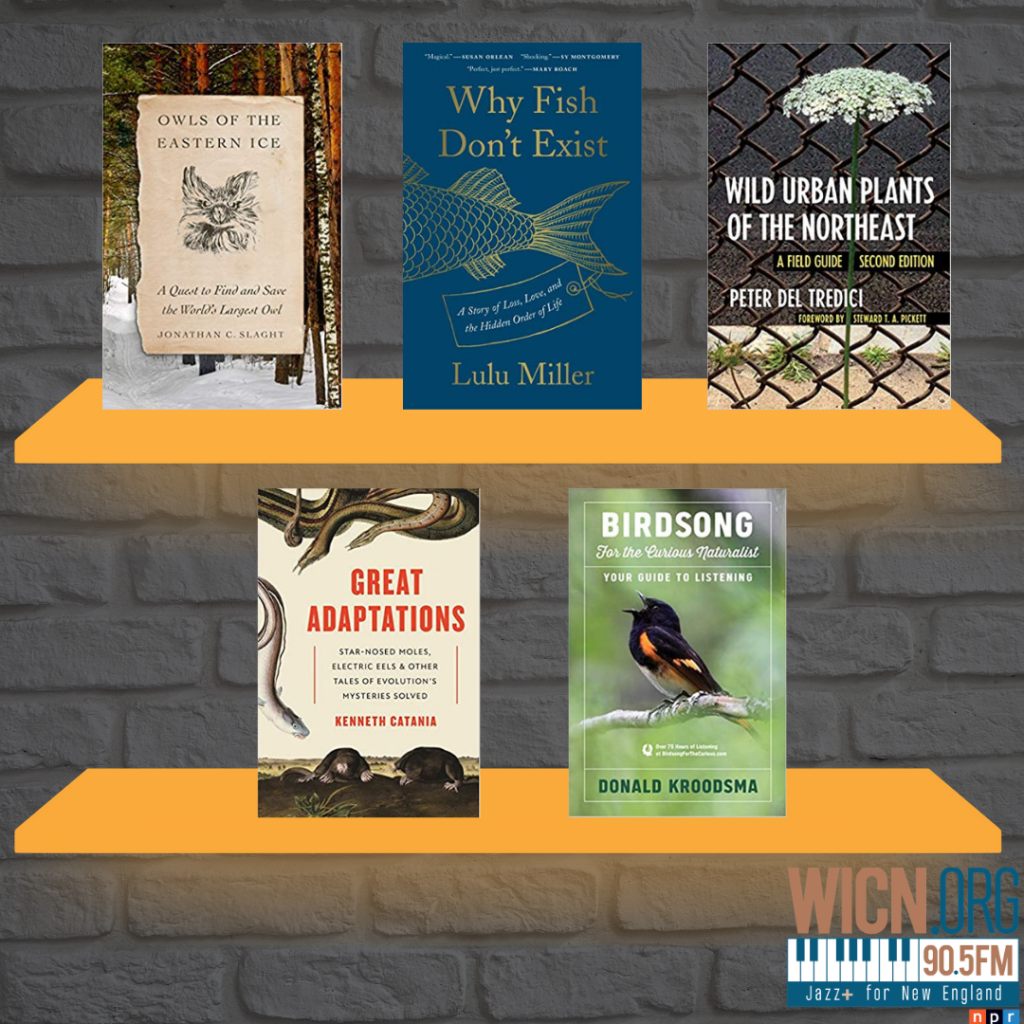
Thank you.
MY TOP 5 FAVORITE NATURAL HISTORY BOOKS OF 2020:
2020 was a phenomenal year for books about natural history, my passion. Here are 5 of the best, most unique, and most entertaining. Any one of them would make a great gift.
1) The magnificent Blakiston’s Fish Owl is the largest owl in the world. It lives in rugged and remote areas of Primorye Province in extreme eastern Russia in areas along rivers that flow to the Sea of Japan. JONATHAN C. SLAGHT is the Russia and Northern Asia coordinator for the Wildlife Conservation Society. For years he has studied this fish owl in its natural habitat to develop a conservation plan for its survival. The challenge was that the best time to study these owls is in February when the temperature often dips to minus 30, there are few roads and very few people. Now, he has written a book about these adventures: OWLS OF THE EASTERN ICE: A QUEST TO FIND AND SAVE THE WORLD’S LARGEST OWL. A perfect book to read this winter.
2) KENNETH CATANIA is the Stevenson Professor of Biological Sciences at Vanderbilt University. Throughout his career, he has studied the sensory adaptations of some very strange creatures like the Star-Nosed Mole, the Tentacled Snake, and the Electric Eel. He has even looked into why Worm Grunting works. All these amazing tales of true research science are found in his new book GREAT ADAPTATIONS: STAR-NOSED MOLES, ELECTRIC EELS, AND OTHER TALES OF EVOLUTION’S MYSTERIES SOLVED.
3) LULU MILLER is a Peabody Award-winning science writer and co-founder of NPR’s Invisibilia. Her new book is WHY FISH DON’T EXIST: A STORY OF LOSS, LOVE, AND THE HIDDEN ORDER OF LIFE. It’s a unique book about ichthyology, academia, collecting stuff, and even a murder mystery. One of the best books of this year in any category.
4) They grow in empty lots, along railroad tracks, even in the cracks of sidewalks. They are wild urban plants, and most of us don’t give them a second glance even though we see them every day. But they are important parts of an urban ecosystem. PETER DEL TREDICI is a botanist specializing in trees. He retired from Harvard University’s Arnold Arboretum after 35 years as plant propagator, bonsai curator, editor of Arnoldia, Director of Living Collections, and Senior Research Scientist. He is also the author of WILD URBAN PLANTS OF THE NORTHEAST/ A FIELD GUIDE.
5) We will eventually slide into spring, and when we do the birds will begin to sing. Have you ever wondered why birds sing? How they make those beautiful sounds? Have you ever wanted to learn some of the basic bird songs? DONALD KROODSMA is a world-renowned authority on birdsong and professor emeritus of ornithology at the University of Massachusetts. His new book is a portal to over 75 hours of listening to the varieties of birdsong while at the same time, teaching you how to listen critically: BIRDSONG FOR THE CURIOUS NATURALIST: YOUR GUIDE TO LISTENING.
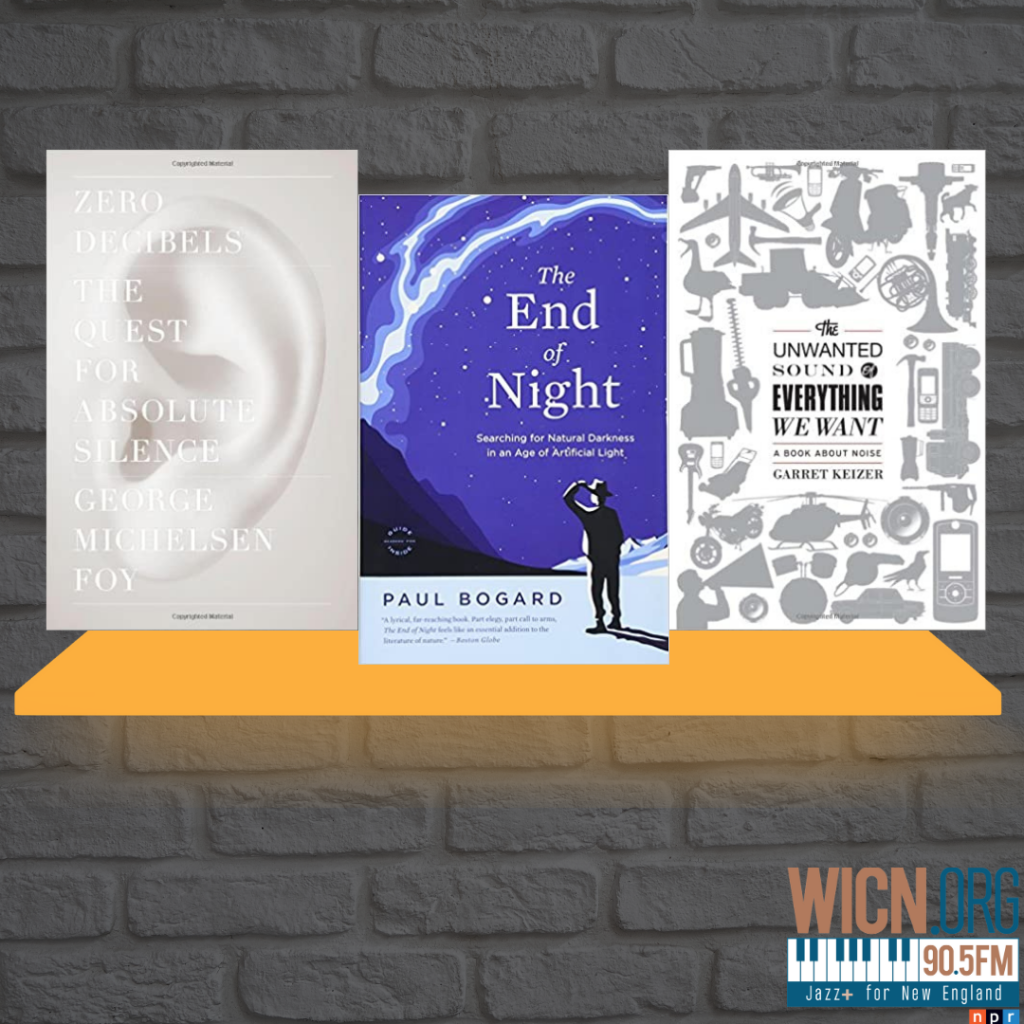
Thank you.
THE NEVER-ENDING SEARCH FOR SOME PEACE, QUIET, AND DARK
We now live in a world that is always noisy and at night, we never enjoy real darkness. Does real peace and quiet still exist? Here are three books that look at this problem.
1) Noise is a political and social issue that affects all of us. Though many of us seek a quieter existence, others declare their ability to make loud noises an all-American right. To the bikers at Sturgis’s massive rally, noise is a celebration of their way of life, but for the nearby Native Americans on their sacred land at Bear Butte, that noise is deeply profane. Who is right? Whether it is bikes, ATVs, blasting your radio, or even just using leaf blowers, many times the creation of noise is about what we want, but not necessarily what the community needs. How and where do you draw the line? Writer, editor, and former Guggenheim Fellow GARRET KEIZER has written a wide-ranging and thoughtful book about these issues: THE UNWANTED SOUND OF EVERYTHING WE WANT: A BOOK ABOUT NOISE.
2) An ear-splitting encounter in the New York City subway system set writer and reporter GEORGE MICHELSEN FOY on a grail-like quest for total and absolute silence. Along the way, he learned that absolute silence is a very subjective and elusive thing. His relentless search took him to sensory deprivation tanks, to conversations with astronauts and deaf scientists, and ultimately to the Orfield Labs anechoic chamber, declared the quietest place on earth by Guinness Records. Along the way, Foy learns about the many societal and metaphysical meanings of silence and how we live in a destructively noisy world. Foy’s book is titled: ZERO DECIBELS: THE QUEST FOR ABSOLUTE SILENCE.
3) Two-thirds of Americans and Europeans no longer experience real night. Light pollution from numerous malls, parking lots, streetlights, and sports fields have bleached our night sky so that we can only see a tiny fraction of the stars that are above us every night. Very few people can now see the Milky Way. But this is not just an aesthetic issue. All this over-lighting is costing us surprising negative health effects, high energy bills, and horrible environmental consequences. But what can be done? PAUL BOGARD teaches creative non-fiction at James Madison University. His important book is THE END OF NIGHT: SEARCHING FOR NATURAL DARKNESS IN AN AGE OF ARTIFICIAL LIGHT.
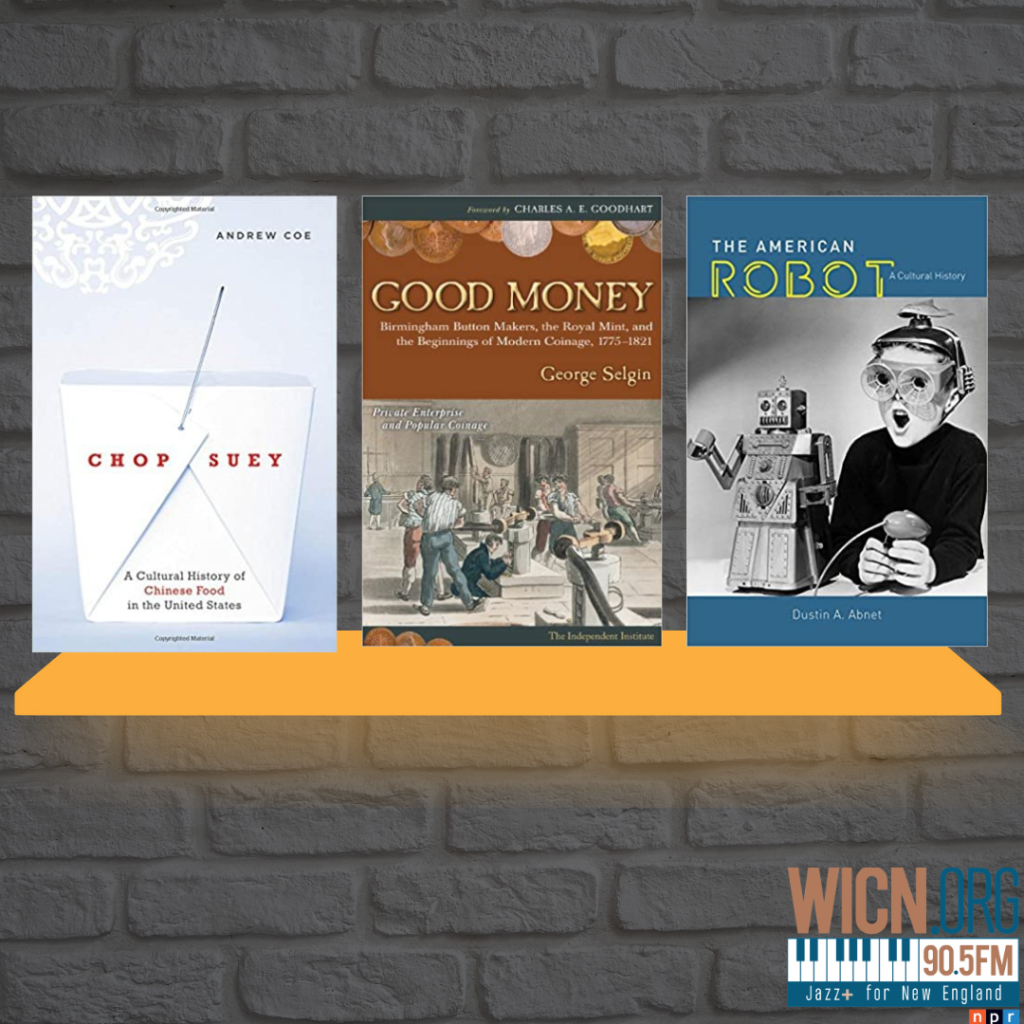
Thank you.
MORE UNIQUE HISTORIES:
On Inquiry, I am always interested in interviewing authors of books about odd corners of history. Below are three books that will make for interesting party conversation.
1) DUSTIN A. ABNET is the assistant professor of American studies at California State University, Fullerton. His new book looks at how concepts of automatons, robots, and androids are conceptually linked with critical questions in American culture: THE AMERICAN ROBOT: A CULTURAL HISTORY.
2) In the late 1700s Britain ran out of change!!! There just were not enough pennies to go around. This meant that factory workers could not be paid and the Industrial Revolution was quickly grinding to a halt. To make matters worse, the Royal Mint just didn’t care because minting lower denomination coins were beneath them. So, what was a working person to do? Mint your own coins of course and these “commercial” coins became the accepted tender in Britain for many decades. GEORGE SELGIN is the B.B.&T. Professor of Free Market Thought at West Virginia University and his entertaining history of odd coinage is GOOD MONEY: BIRMINGHAM BUTTON MAKERS, THE ROYAL MINT AND THE BEGINNINGS OF MODERN COINAGE 1775-1821.
3) Hot and Sour Soup, Chicken Chop Suey, Szechuan Spicy Eggplant, Shrimp Lo Mein. We have all eaten American Chinese food, but have you ever wondered how Chinese cuisine got to America? What did Americans in the 18th Century think about traditional Chinese food? Where were the first Chinese restaurants in America and what was on their menu? Writer and gastronomic historian ANDREW COE has written a fascinating history on just this subject: CHOP SUEY: A CULTURAL HISTORY OF CHINESE FOOD IN AMERICA.

Thank you.
WOMEN AND THE HOLLYWOOD STUDIO SYSTEM:
True romance! Scary monsters! The Casbah! Here are three books about women navigating the many pitfalls and roadblocks of Tinseltown.
1) Writer and producer VICTORIA RISKIN has written a wonderful memoir about her parents: legendary screen actress Fay Wray and award-winning screenwriter Robert Riskin. Not only is this book an account of a great love story, but it is also an insider’s look at how the Hollywood studio system worked in the ‘30s and ‘40s. Read this book to find out how Kong’s heartthrob met and fell in love with the author of It Happened One Night. Victoria Riskin’s book is titled: FAY WRAY AND ROBERT RISKIN: A HOLLYWOOD MEMOIR.
2) Writer, film producer, and screenwriter MALLORY O’MEARA has written a book that details her long quest to uncover the life of Milicent Patrick, Disney animator, and designer of one of the most iconic monsters of Universal films: The Creature from the Black Lagoon. The reason Patrick’s story was so tough to uncover is that her role in the design of several monsters at Universal had been purposely minimized and covered up. O’Meara’s book is THE LADY FROM THE BLACK LAGOON: HOLLYWOOD MONSTERS AND THE LOST LEGACY OF MILICENT PATRICK.
3) Hedy Lamarr was one of the iconic actresses of the 40s and 50s in American film. She was considered one of the most beautiful women in cinema, but often this came at the price of directors, lovers, and other actors thinking that Hedy was all looks and no brains. Because of this, Hedy Lamarr was never given the complex roles she deserved. She should have been the female lead in Casablanca, and therein lies just part of the complicated life of this very complicated woman. In her later years, she was adrift, almost forgotten except for being the subject of a joking reference in Mel Brooks’ Blazing Saddles. Yet she has left behind a rich legacy of work in films like Algiers and Ziegfeld Girl. Surprisingly, she was also a technological inventor whose patents were decades ahead of their time paving the way for cell phones and most of the modern communication devices we know today. Writer and actor STEPHEN MICHAEL SHEARER have written a wonderful biography that finally gives us the complete picture of this enigmatic actress BEAUTIFUL: THE LIFE OF HEDY LAMARR.
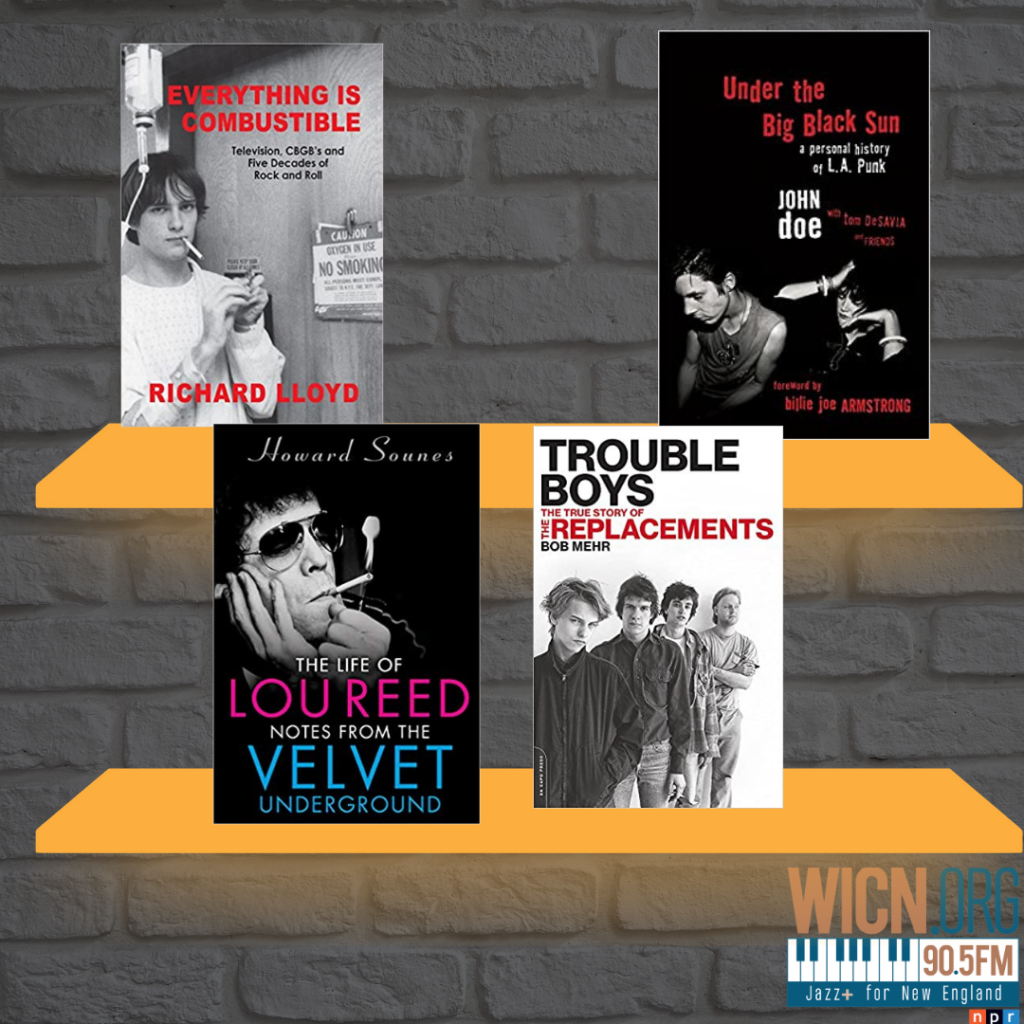
Thank you.
PUNKED!
Here are four great books about hard rock and punk from across the nation.
1) JOHN DOE was the bassist and vocalist for the legendary band “X,” a musician, and actor. He has written and compiled a new book of essays on the emergence of the punk movement in Los Angeles in the late 1970s and early 80s. Besides Doe’s own writing, UNDER THE BIG BLACK SUN: A PERSONAL HISTORY OF L.A. PUNK features pieces written by key musicians of that time; bands like The Plugz, The Flesheaters, and even the Go-Go’s.
2) An electric guitarist, songwriter, and recording artist RICHARD LLOYD has written a memoir that is a roller coaster ride of sex, drugs, rock and roll, and Gurdjieff: EVERYTHING IS COMBUSTIBLE: TELEVISION, CBGB’S, AND FIVE DECADES OF ROCK AND ROLL.
3) There was no other band like them. They were four self-described “losers” who really understood each other. Their live performances were often out of control, yet they recorded some of the most memorable rock of the 1980s. Writer and critic BOB MEHR has written the definitive biography: TROUBLE BOYS: THE TRUE STORY OF THE REPLACEMENTS.
4) He was a difficult and conflicted person, often plagued by his use of drugs. But he was also one of the most creative, original, and wild rockers to come out of New York. Writer and biographer HOWARD SOUNES has written a great biography about THE LIFE OF LOU REED: NOTES FROM THE VELVET UNDERGROUND.
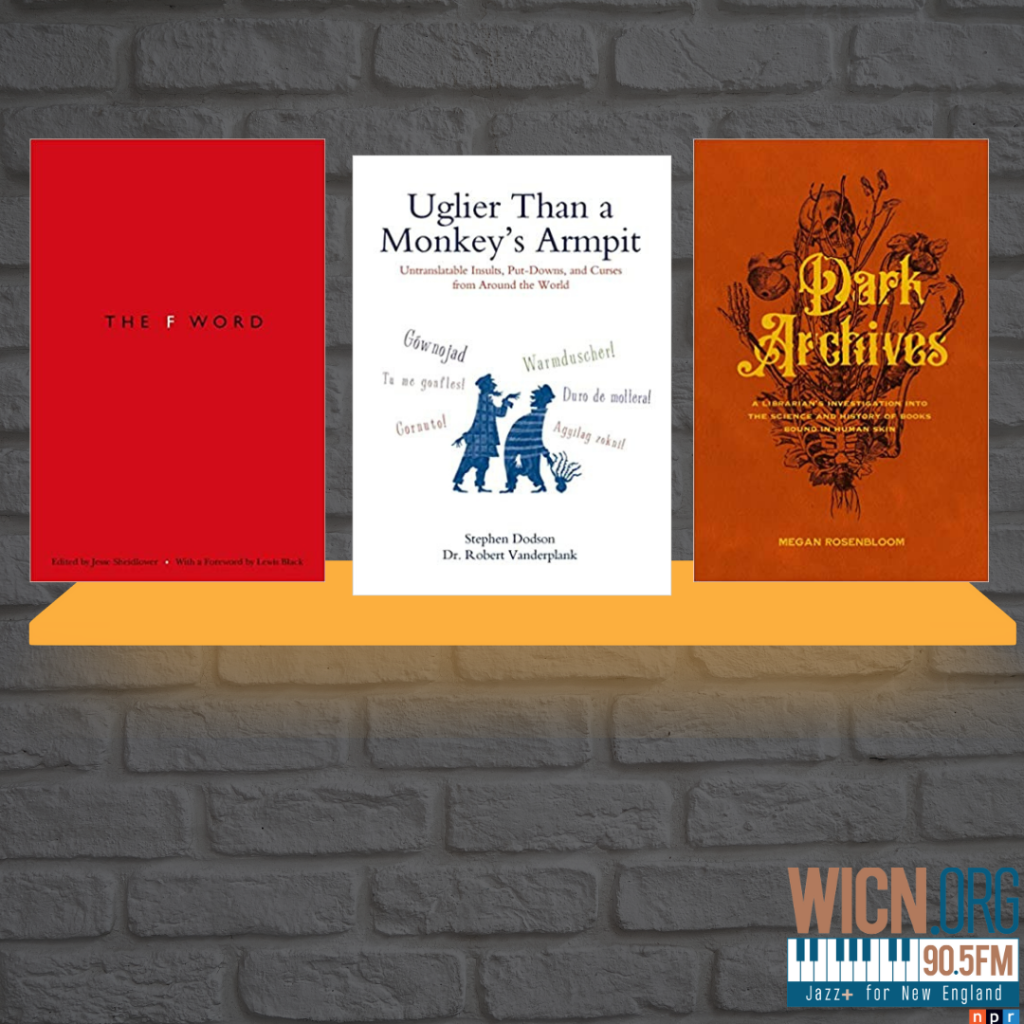
Thank you.
INSULTS, BAD WORDS, AND EVEN WORSE BOOKS:
1) “You are the scum of soy paste!” In Japan, that odd phrase is just one of a number of common insults that children say to each other. Swearing and cursing are as old as language and this book looks at the cultural differences of telling someone off in no uncertain terms. Linguist and editor STEPHEN DODSON, with Dr. VANDERPLANK of the Oxford University Language Center, have written an informative look at put-downs from around the world titled UGLIER THAN A MONKEY’S ARMPIT: UNTRANSLATABLE INSULTS, PUT DOWNS AND CURSES FROM AROUND THE WORLD.
2) JESSE SHEIDLOWER is a lexicographer and an Editor-at-Large for the Oxford English Dictionary. He has compiled a rather unique lexicon focusing on the “f” word: its origins, many uses, initialisms, and euphemisms. If you have ever wondered about the origins of a term like “dropping the ‘F’ bomb,” this book is a serious etymological discussion about all forms of THE F-WORD, the title of Sheidlower’s book. Years ago, when I interviewed Sheidlower, we managed to never drop “the F-bomb” in the entire 30-minute interview!
3) The following book is a serious discussion about anthropodermic books, volumes bound in human skin. MEGAN ROSENBLOOM is a librarian with a research interest in the history of medicine and rare books. She also works for the Anthropodermic Book Project. Moving beyond the initial macabre titillation of the subject, these books raise important questions about whether they even belong in museum and library collections. A number of these books were also owned and prepared by medical doctors. How could moral doctors bound a book with the skin of one of their patients? Rosenbloom’s new book is titled: DARK ARCHIVES: A LIBRARIAN’S INVESTIGATION INTO THE SCIENCE AND HISTORY OF BOOKS BOUND IN HUMAN SKIN.
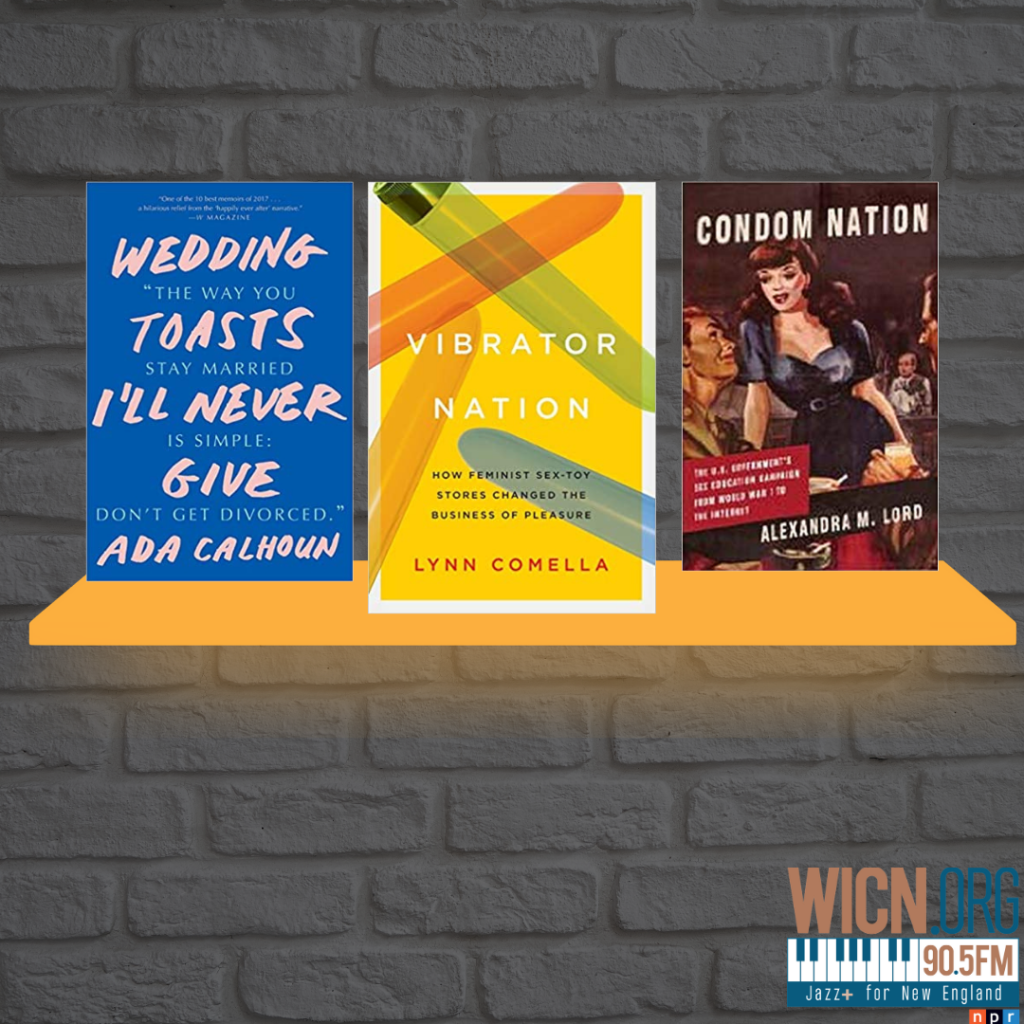
Thank you.
LOVE, SEX, MARRIAGE:
1) Since our nation’s inception, governments at the local, state, and federal levels have advanced programs to promote American’s health. Probably no other program has been as controversial and widely debated as the national government’s sex education campaigns. Kicked into high gear during World War I, the program was begun to control the national epidemic of sexually transmitted diseases. These programs have been complicated by racist assumptions, local faith-based resistance, and an inability to actually talk openly about the subject. Writer ALEXANDRA M. LORD, who previously served as a historian with the United States Public Health Service, has written a unique and fascinating history of these efforts: CONDOM NATION: THE U.S. GOVERNMENT’S SEX EDUCATION CAMPAIGN FROM WORLD WAR I TO THE INTERNET.
2) LYNN COMELLA is an Associate Professor of Gender and Sexuality Studies at the University of Nevada, Las Vegas. Her book traces the history, evolution, and social impact of women run sex-toy stores: VIBRATOR NATION: HOW FEMINIST SEX-TOY STORES CHANGED THE BUSINESS OF PLEASURE.
3) “If dating is poetry, then marriage is a novel.” Why do we get married and why do we stay married? “The main problem with marriage is that it’s not better than the rest of your life,” says writer and journalist ADA CALHOUN. Calhoun was well into her second decade of marriage when she started to wonder what do we get out of marriage. Her book is a frank and honest meditation on the cultural institution: WEDDING TOASTS I’LL NEVER MAKE.
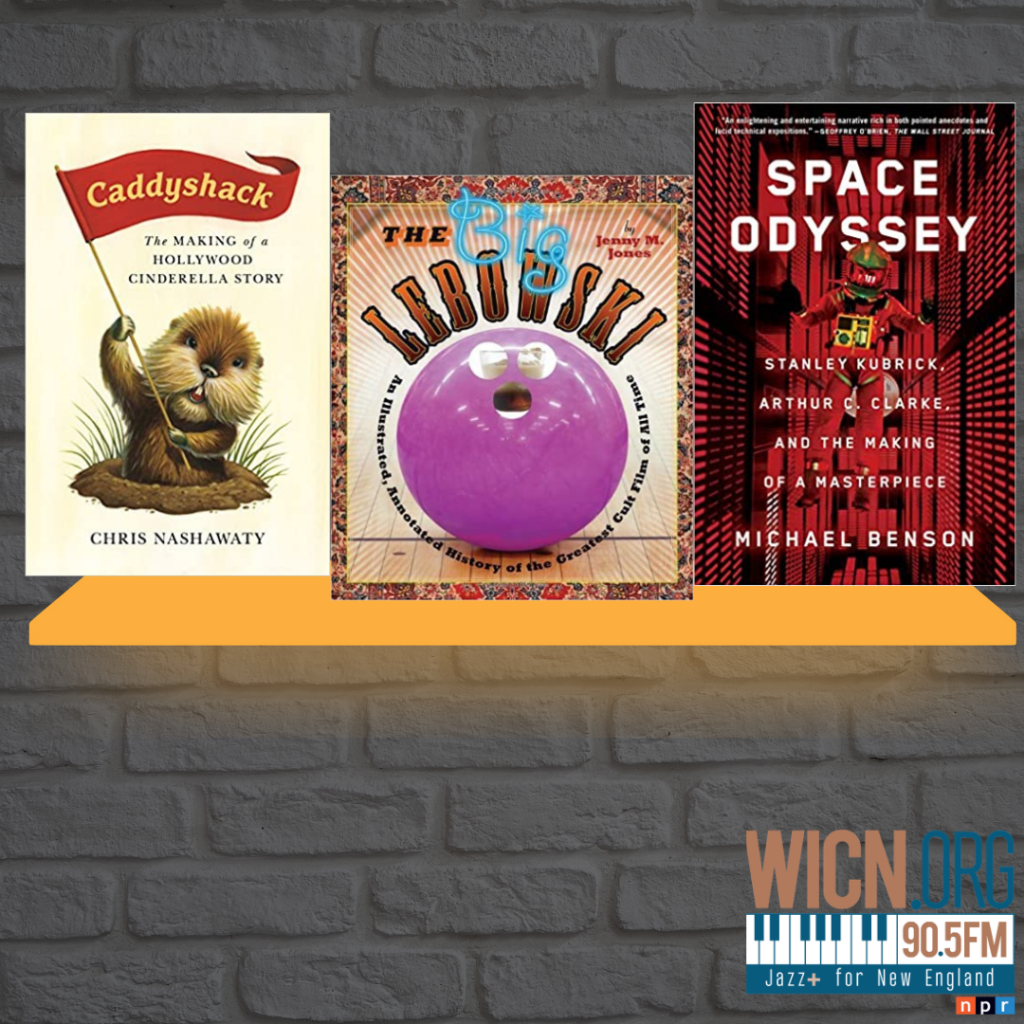
Thank you.
THE STORIES BEHIND 3 POPULAR FILMS:
Every film has a story about how it got made. Some of these stories are better than others. Here are three of the best.
1) On April 2, 1969, the film 2001: A SPACE ODYSSEY opened and was instantly recognized as a landmark of filmmaking as well as a perfect film to see if you were tripping. A half-century later, people are still talking about this film. Writer, artist, and filmmaker MICHAEL BENSON has written a great book about how this movie got made, SPACE ODYSSEY: STANLEY KUBRICK, ARTHUR C. CLARKE, AND THE MAKING OF A MASTERPIECE. Pick it up and learn what the monolith originally looked like.
2) The 1998 film THE BIG LEBOWSKI has become one of the greatest cult films of all time. What is it about this complex shaggy dog story that is so appealing? Author and cinema historian JENNY M. JONES has written a sprawling and endlessly entertaining history: THE BIG LEBOWSKI: AN ILLUSTRATED, ANNOTATED HISTORY OF THE GREATEST CULT FILM OF ALL TIME. In this book, you will learn about how the Coen Brothers work together when filming; about who might have been cast as “The Dude” instead of Jeff Bridges; Maude Lebowski’s connection to the Fluxus art movement, and the inspiration for Walter Sobchuk. The Dude abides.
3) It was often total drug-fueled anarchy on the set. Bill Murray was out of control and everyone was waiting for the big fight to happen between him and Chevy Chase. Ted Knight hated everyone. Rodney Dangerfield was pretty much what you saw on film. When the film opened, it was roundly panned by most critics. Yet today, Caddyshack has become a comedy classic. The crazy background and history of that film is perfectly captured in Entertainment Weekly film critic CHRIS NASHAWATY’S book CADDYSHACK: THE MAKING OF A HOLLYWOOD CINDERELLA STORY.
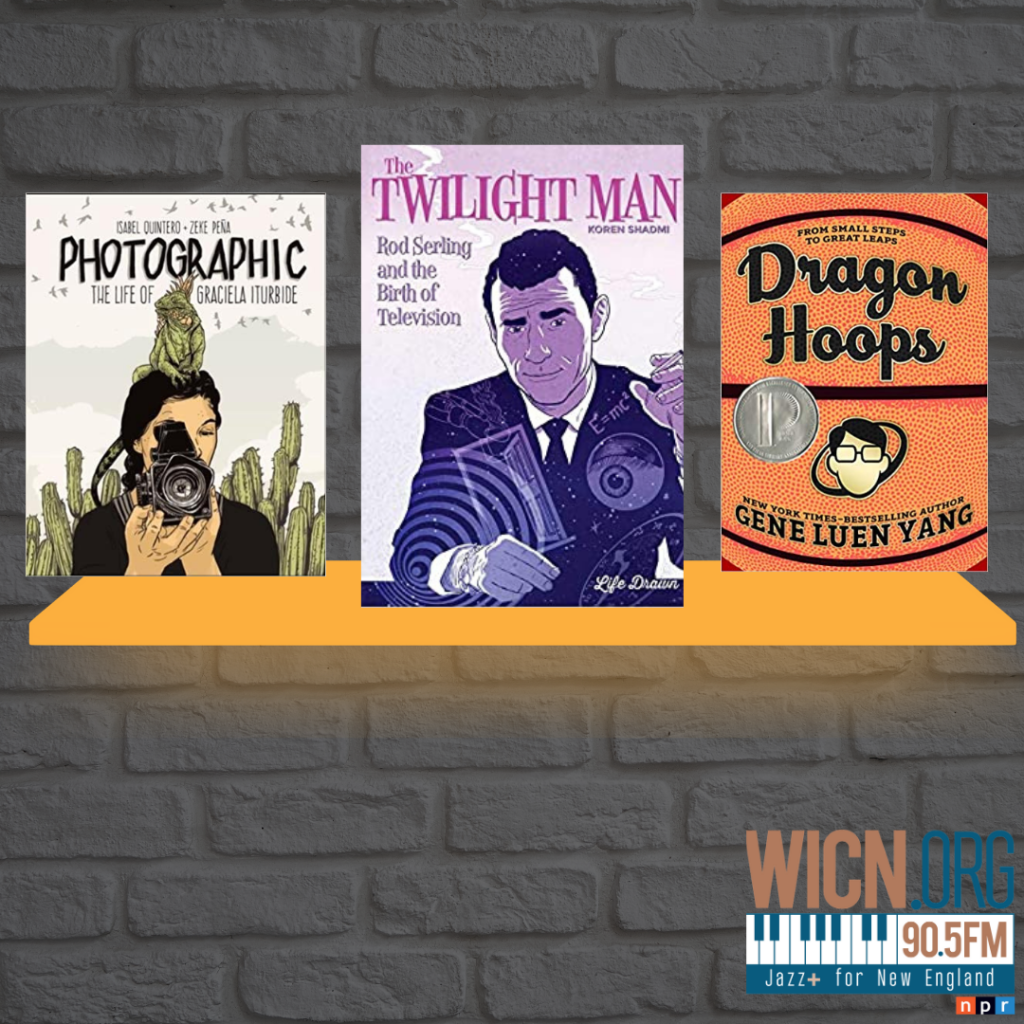
Thank you.
LIFELINES:
Some of the most unique biographies and memoirs today are drawn as well as written. Below are three examples.
1) ISABEL QUINTERO is a writer and interviewer, and ZEKE PEÑA is a cartoonist, illustrator, and painter. They have collaborated to illustrate and write an outstanding biography of a mysterious Mexican photographer: PHOTOGRAPHIC: THE LIFE OF GRACIELA ITURBIDE.
2) GENE LUEN YANG writes, and sometimes draws, comic books and graphic novels. His newest book is DRAGON HOOPS: FROM SMALL STEPS TO GREAT LEAPS. This graphic memoir traces Yang’s interest in the high school basketball team where he teaches. It’s a project he started even though he has never enjoyed sports and knows nothing about basketball. His book is a thrilling account of his school’s attempt to finally win the State finals as well as a unique history of the sport.
3) Rod Serling was a screen and television writer who helped create the “Golden Age of Television” with his television plays like Patterns and with his ground-breaking series The Twilight Zone. Yet he was a tortured soul, often haunted by his military experiences. Award-winning illustrator and cartoonist KOREN SHADMI has written and drawn a fine graphic biography: THE TWILIGHT MAN: ROD SERLING AND THE BIRTH OF TELEVISION.
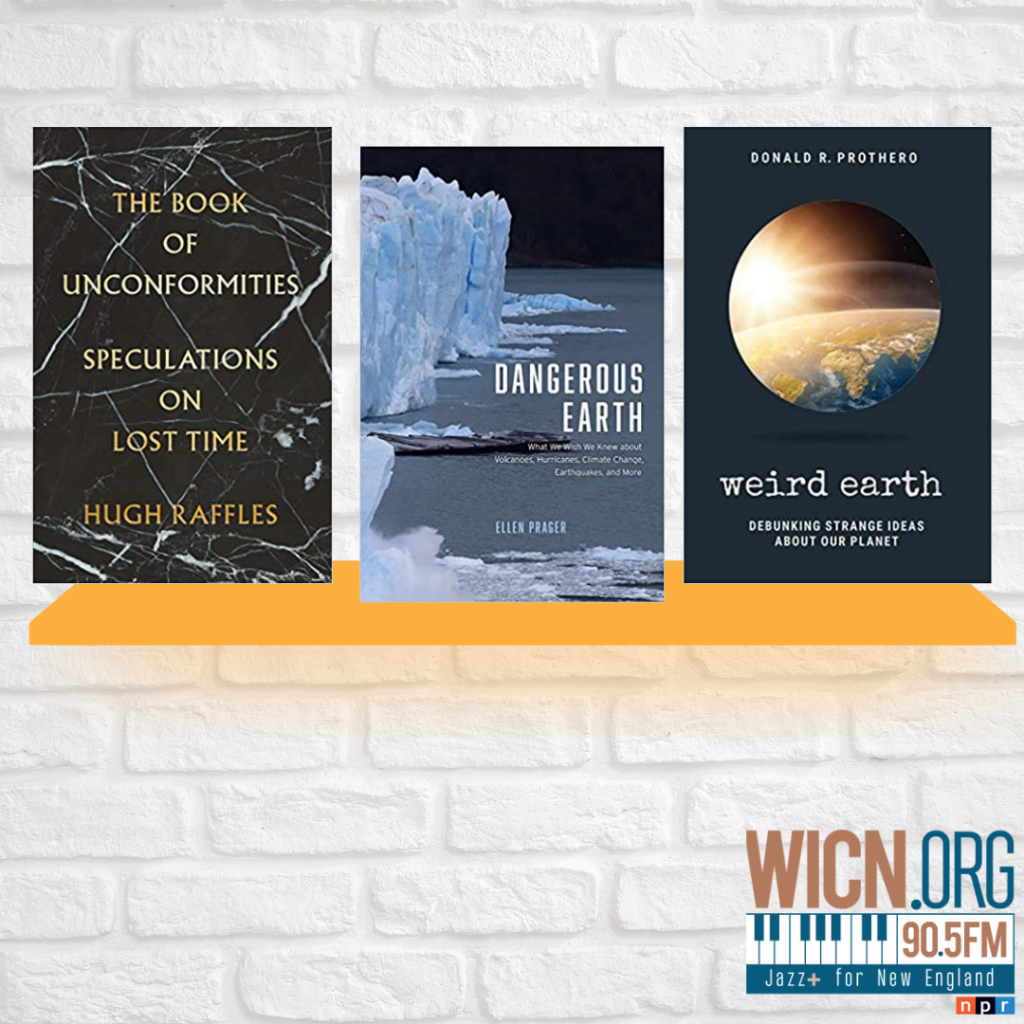
Thank you.
EARTH: IT’S THE ONLY HOME WE ALL HAVE, BUT IT CAN BE A DANGEROUS AND WEIRD PLACE.
1) Earth is beautiful and filled with wonders, but it is also “frustratingly” complex and at times extremely violent. There are volcanoes, hurricanes, tsunamis, earthquakes, and climate change. Because of the hard work of numerous scientists, we understand a bit of why these events occur, but there is so much more we wish we knew. Author and marine scientist ELLEN PRAGER’s new book is DANGEROUS EARTH: WHAT WE WISH WE KNEW ABOUT VOLCANOES, HURRICANES, CLIMATE CHANGE, EARTHQUAKES, AND MORE.
2) Why do seemingly intelligent people believe in crazy things that are obviously untrue? There are folks who believe that the earth is flat, the earth is hollow, that the moon landing never happened, or that dinosaurs never existed. Geology and paleontology professor DONALD R. PROTHERO’s must-read new book is WEIRD EARTH: DEBUNKING IDEAS ABOUT OUR PLANET.
3) Award-winning writer HUGH RAFFLES is also a Professor of Anthropology at The New School. His new book is THE BOOK OF UNCONFORMITIES: SPECULATIONS ON LOST TIME. This unique book is about loss, deep time, and how various minerals and rocks have become human obsessions. Think stone circles and meteorites.

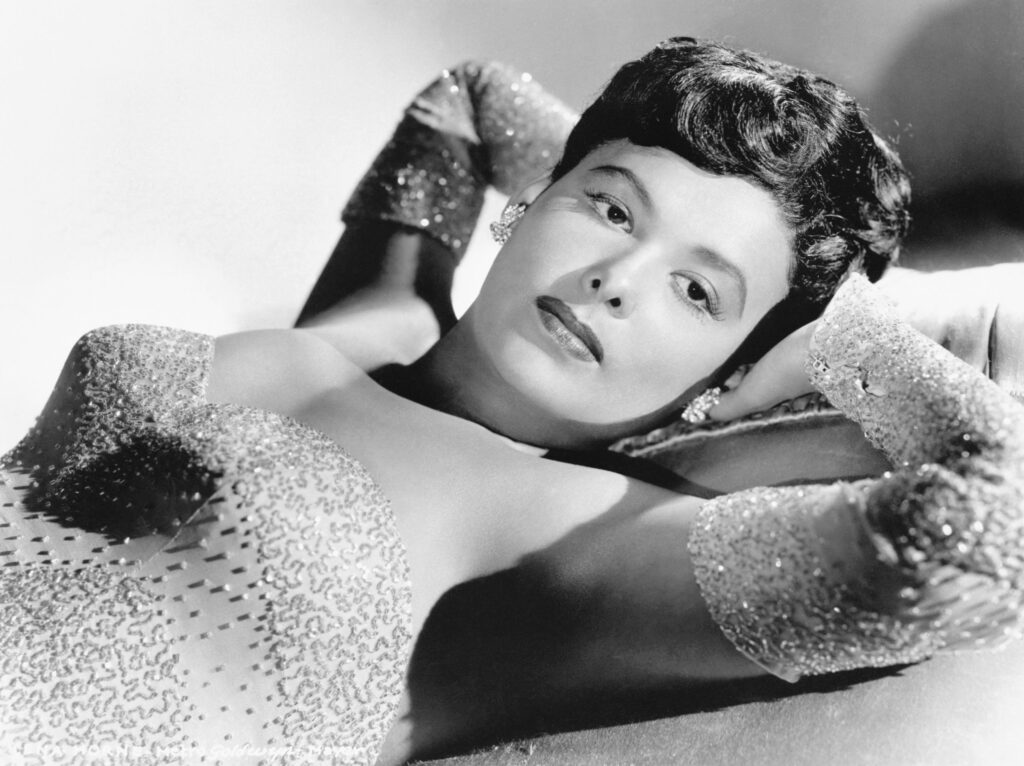
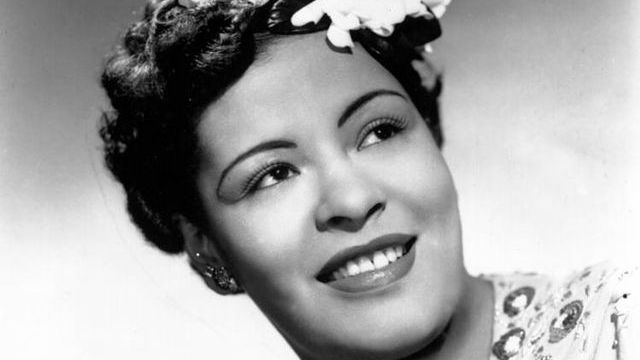
Cameryn On May 2, 2021 at 4:05 am
Hines appreciates having multiple opportunities to immerse her life in music as a pianist, composer and radio host.